If you would like a printed copy of any of our back issues, then they can be purchased on Farm Marketplace. You can also download the PDFs or read online from links below.
-
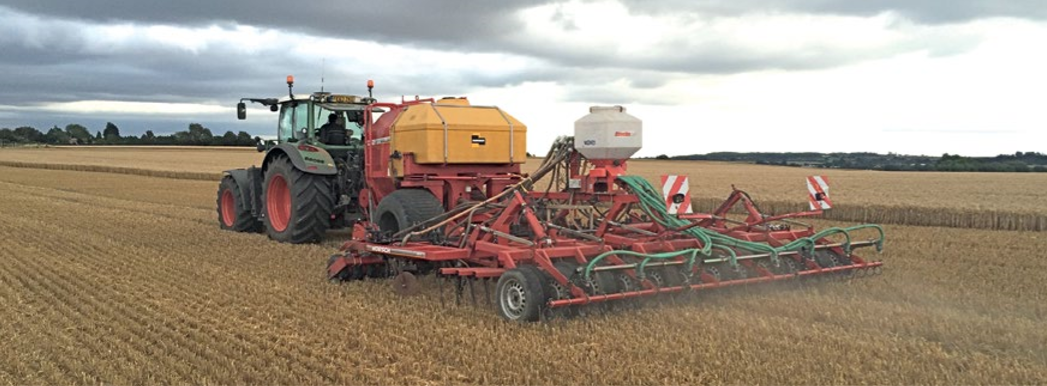
How To Start Drilling For £8K
Clive Bailye’s seed drill of choice is his 6m John Deere 750A , which has been used exclusively for 3-4 seasons. Last year, with an increased acreage, the founder and publisher of this Direct Driller magazine thought a second seed drill was necessary. Having just the one machine was a risk and in a difficult season would mean drilling was delayed. He looked around and found a good condition Horsch CO6 tine drill advertised in Germany.
Words and pictures by Mike Donovan
After delivery he rebuilt the coulters to a narrow profile so as to reduce soil disturbance. He says the tine drill is very useful driling after straw crops such as osr and also through the straw on second crop cereals.
Buying the drill from a German farmer was not particularly complicated, and provided him with a higher spec machine than Horsh sell in the UK. The seed dart tyres are much wider, and the machine is fitted with blockage monitors as well as full width front packers and also a liquid fert application system.
A sheaf of photos were taken, and Clive then asked for some of specific parts to show wear. The deal was done at under £5,000 which Clive says is the market value of these machines which are too large for small farmers to buy. Original owners like to buy new and sell when the machine is still in good condition.
Narrow tines with wear tiles
@Clive knew he wanted to make changes, substituting the Horsch tines and coulters for something far narrower, and has ended up getting his own design of tine made, which has a wear tile made from Ferobide, far harder than tungsten. The drill is on the farm primarily for osr and 2nd crop cereals drilled into chopped straw and the 25cm spacing is okay for these crops.
Comments on Clive’s on-line forum, TFF, said the drill many not be so good with beans, as the slot is a mere 12mm wide. And in barley the spacing may well be too wide as it needs to be thick. Clive points out that the seed pipe can actually be a bit wider than 12mm as it is in the shadow of the point. It would be good to have the option of using it for beans.

Above left: The cheap CO6 is being calibrated ready for its first outing

Above right: The adapted Horsch is being filled by the home built drill logistics trailer with seed and liquid starter fert.
Getting around the German instructions
The Horsch came, of course, with a control box and instructions in German. More on-line discussion revealed that English instructions were available on the Horsch website, and another explained that Horsch was sourcing some of these parts from Agton in Canada anyway. Zealman from New Zealand explained that the button marked with callipers should be held down for around 5 seconds. The menu is where you adjust the tramline sequence, valve layout and row numbers.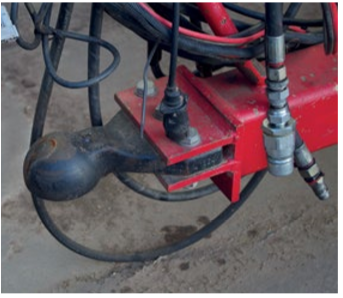
Ball hitch is a continental standard and provides a positive connection between tractor and drill

The Stocks Wizard has a rotor modified for Avadex which otherwise leaks everywhere
A Stocks Wizard is on the back of the drill and used for Avadex. Here again the knowledge of actual farmers is helpful. Alistair Nelson warned that the rotor and the surrounding shroud need to be changed, and he got good advice “from Rick at Stocks”. Clive has the same setup on the 750A and says that the Avadex leaks everywhere unless the modification is made. The drill was acquired and modified in 2016 and the results have been excellent.
The machine went through the residue without many problems and having the second drill has meant more timely planting. Clive has shown that moving into No-Till is not the expensive exercise so many farmers think it might be. The total cost, after modifications which included replacing all tines and coulters, was under £8,000.
Author Mike Donovan writes: we have featured a number of home made direct drills in @Practical Farm Ideas, and are always interested in seeing more. Please contact mike editor@farmideas.co.uk or 07778877514.
-
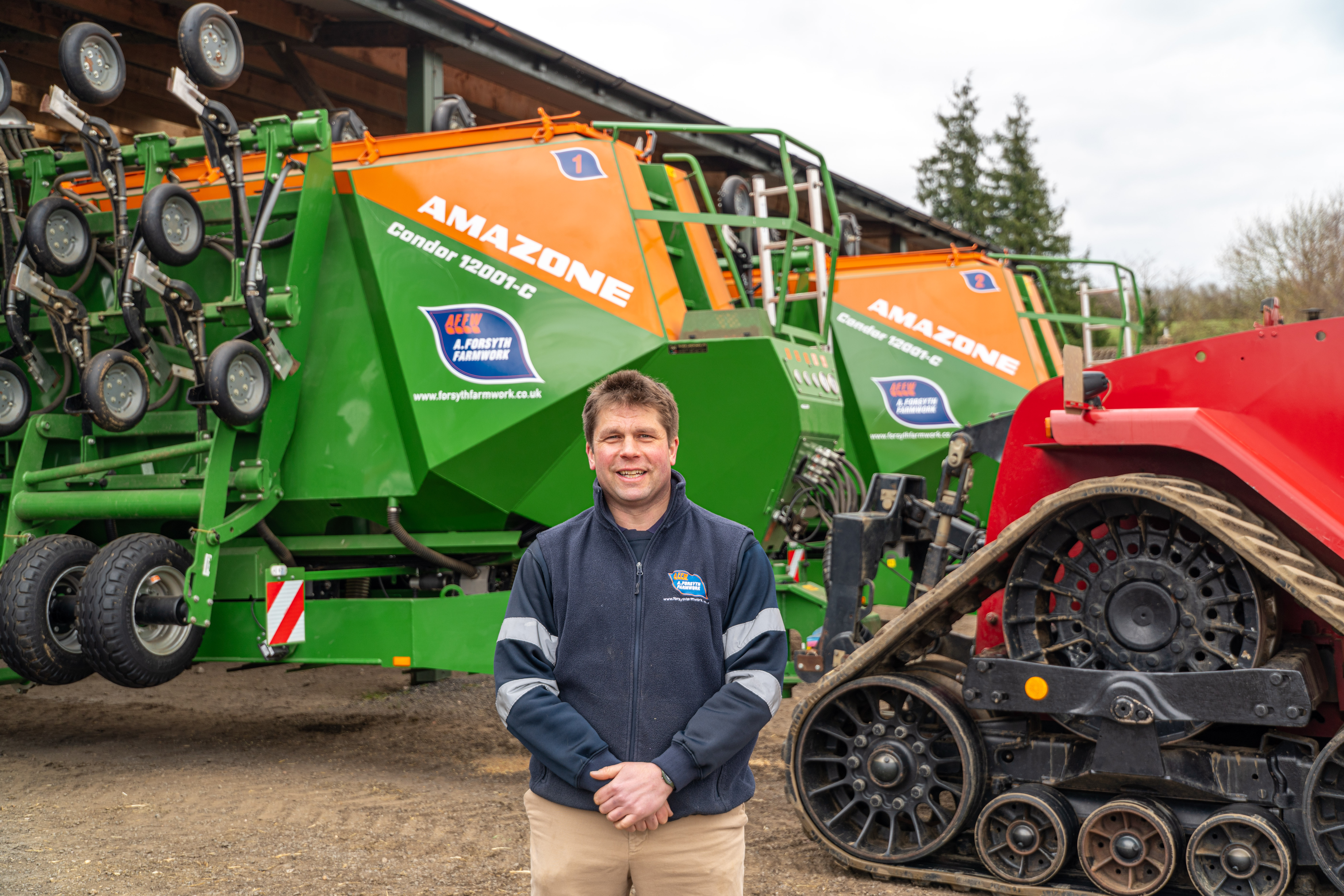
Drilling for Success: The Versatility of AMAZONE’s Tine Drills
In the current farming climate, growers require drills with maximum flexibility to handle multiple crop types and establishment methods. AMAZONE has developed a range of tine drills to meet these challenges. Since the late 1970s, the company has utilised the TineTeC coulter across various models, more recently including the Cayena, Condor, and Primera DMC. The slim chisel opener provides excellent penetration for precise depth control, even at shallow sowing depths, while minimising soil disturbance to reduce moisture loss and limit weed germination.
For farmers like William Forsyth, who works with heavy clay soils
across his 2,200 ha Warwickshire farm, this adaptability was essential. His previous disc coulter drills lacked the necessary pressure to maintain consistent seed depth, leading him to invest in three Condor 12001-C drills.
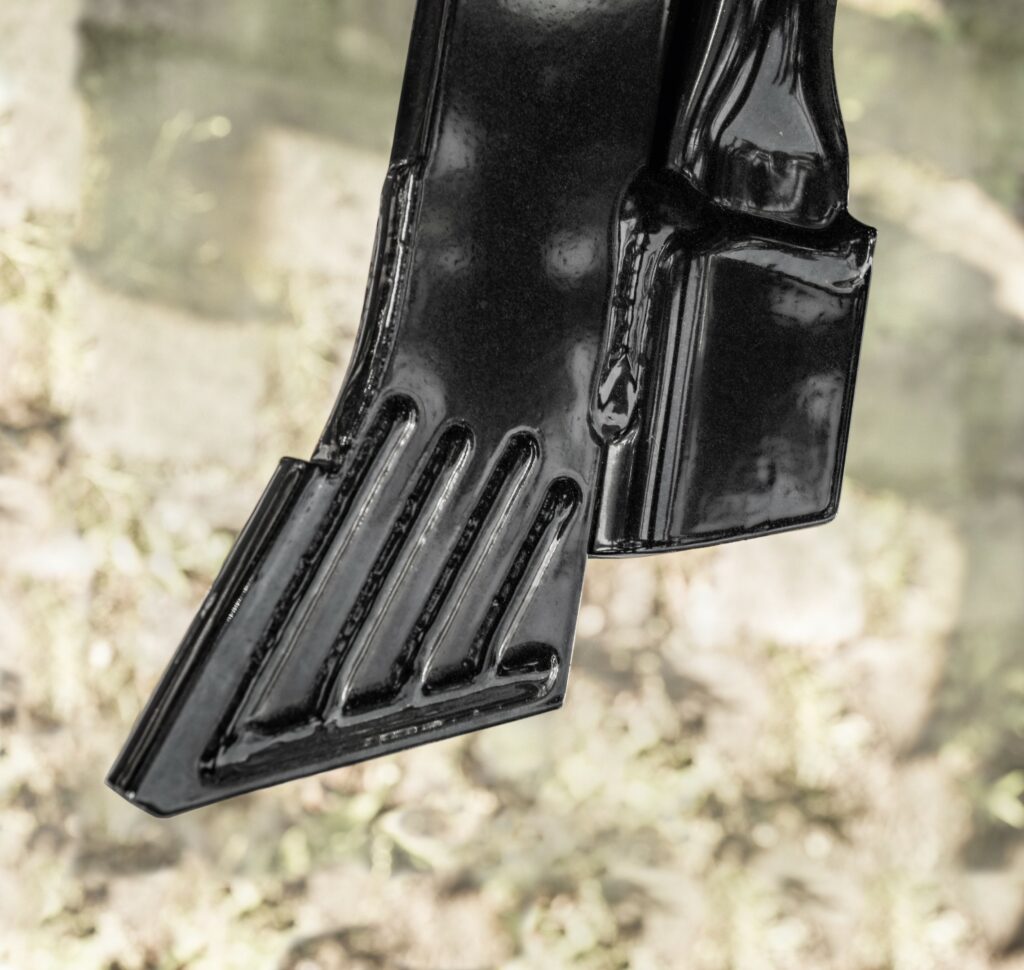
Cayena TineTec coulter 
Condor ConTeC pro coulter After first trialling a Condor in autumn 2023, William and his father Anthony were immediately impressed with the drill’s versatility. Despite the wet and steep conditions on the demo day, they successfully used it for direct drilling, as well as into tilled and ploughed ground.
“The seed was at a completely even depth across the entire machine, something we were not used to at all with our previous drill,” stated William. “Setting the seeding depth is also surprisingly easy, with a tool on each end of the drill to adjust the depth of individual coulters, making it simple to get the right seed depth behind the tractor wheels.”
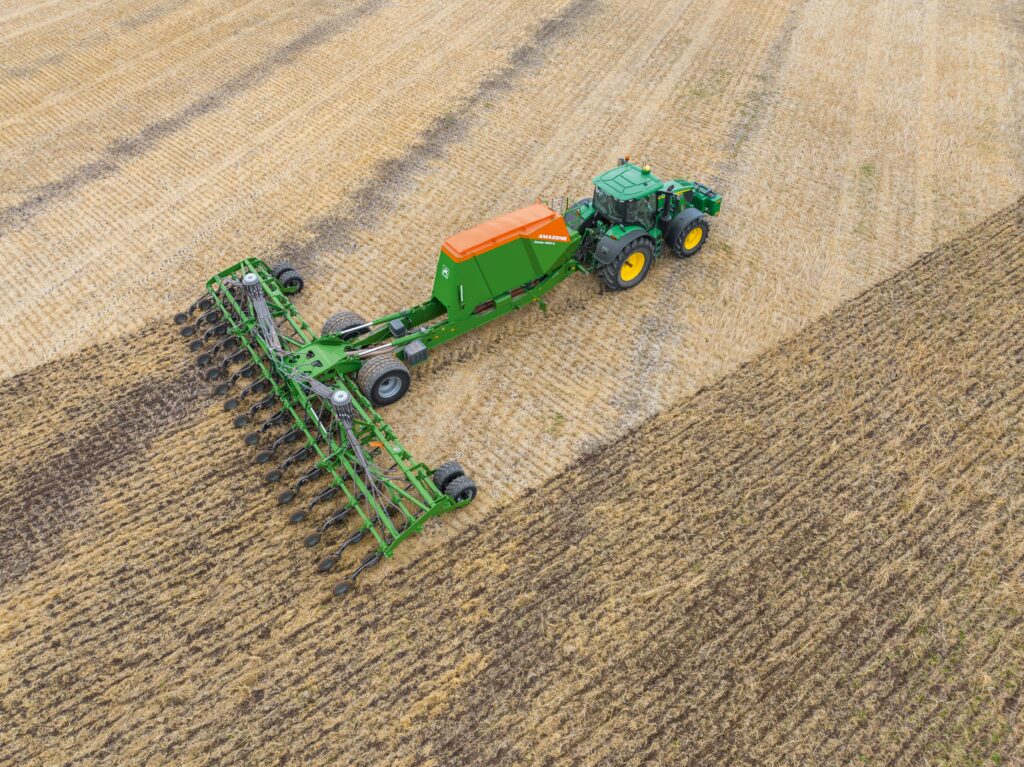
Condor 12001-C 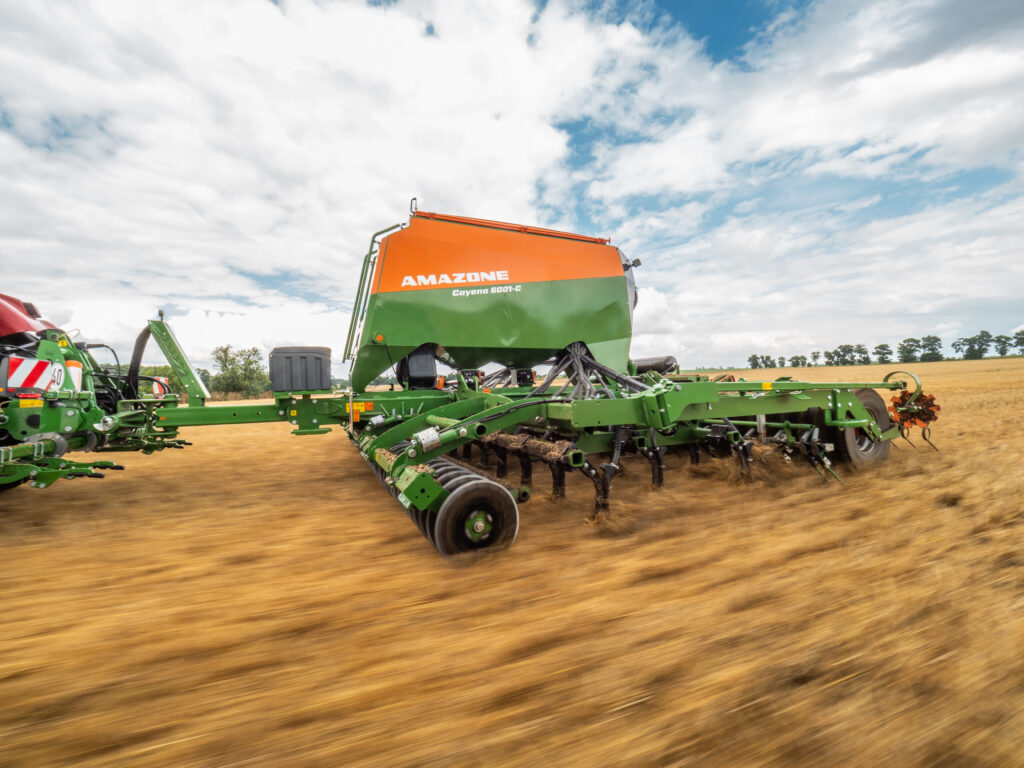
Cayena 6001-C The chisel action of the tine forms a clean seed slot, placing the seed without seed/straw contact. This improves germination and eliminates the risk of residue breakdown affecting crop establishment. The long coulter spacing allows row spacing to be as narrow as 16.6 cm while ensuring that surface residues pass through the drill without blockages. The Cayena model further improves residue management with a row of vertical front cutting discs that slice through trash ahead of the coulters.
William also noted the reduced pulling power of the new Condor drills, allowing the tractors to run at lower revs, reducing fuel consumption. Additionally, the fast folding and unfolding process makes field-to-field transitions effortless—a key factor when working with a 12-metre drill on fields averaging just 9 hectares.
The MultiBin System: Precision and Efficiency
With these models of tine drills having the ability to establish a cover crop straight into stubble – or into a stale seedbed, sow a cash crop following last year’s cash crop or to sow a cash crop into a cover crop, the AMAZONE tine drills are equipped with the MultiBin system with a divided hopper along with additional seeder boxes. Using the divided main tank, available with either two or three chambers, the drill can be used to sow a multitude of seed varieties as well as undersowing crops, companion crop planting, or mix of seed and fertiliser to target phosphate in the seeding zone. Additionally, the MultiBin system can be used for a mix of seed and slug pellets, or seed and a micro-granular herbicide. Each hopper within the MultiBin system is controlled via ISOBUS individually and can run off three or four variable rate application maps for site-specific, part area application where seed populations are matched with soil type and topography to maintain an even crop density.
As farms incorporate more diverse crop rotations, changing seed types or mixes has become more frequent, meaning seed calibration has become a much more regular task. TwinTerminal involves a secondary terminal mounted on the drill near the metering units, allowing for easy calibration and pre-metering for all seed hoppers and metering units without having to jump in and out of the cab. Simply hold the calibration button and then enter the weight of the metered seed Simply hold the calibration button and enter the weight of the metered seed. William’s team described how it saved them significant time and reduced the need to jump in and out of the cab.
Optimised Reconsolidation for Strong Establishment
Beyond precision seeding, AMAZONE’s tine drills ensure robust crop establishment through their unique reconsolidation system. Strip-wise reconsolidation, where only the seed row is firmed while the area between rows remains loose, is key to improved water infiltration and reduced weed germination.
With conventional drills, capped soil surfaces and poor drainage often hinder establishment. However, the Condor’s depth and consolidation rollers ensure uniform firmness around the seed, maintaining moisture availability even in dry conditions, whilst leaving the areas between the coulters undisturbed. Similarly, the Cayena drill uses a Matrix profile tyre, which applies pressure precisely in line with the seed rows, mirroring the spacing of the tine coulters.
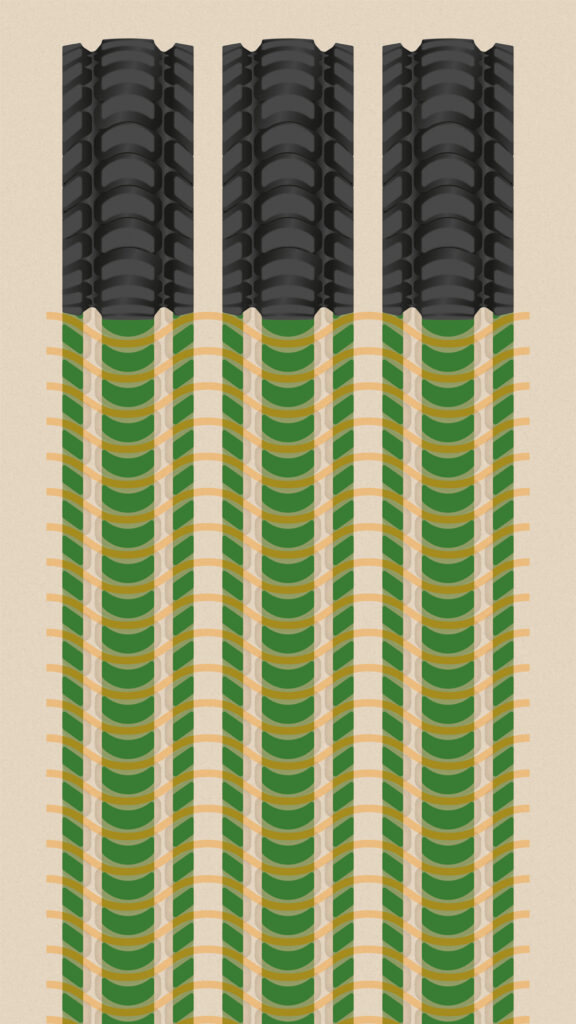
Strip-wise reconsolidation with the Matrix tyre profile. Cost-Effective and User-Friendly Design
The ability to direct drill, work in a min-till system, or function as a conventional
seeder means farmers like William get maximum flexibility from their drill investment. Setup is straightforward, and with fewer moving parts, wearing costs are kept low—something every farm operation can appreciate.
Available in working widths from 6 m to 15 m, AMAZONE’s tine drills offer efficiency without compromising precision. With lower fuel requirements, adaptable seeding options, and user-friendly operation, they are an ideal investment for modern arable farming, delivering reliable performance across a variety of soil and establishment conditions.
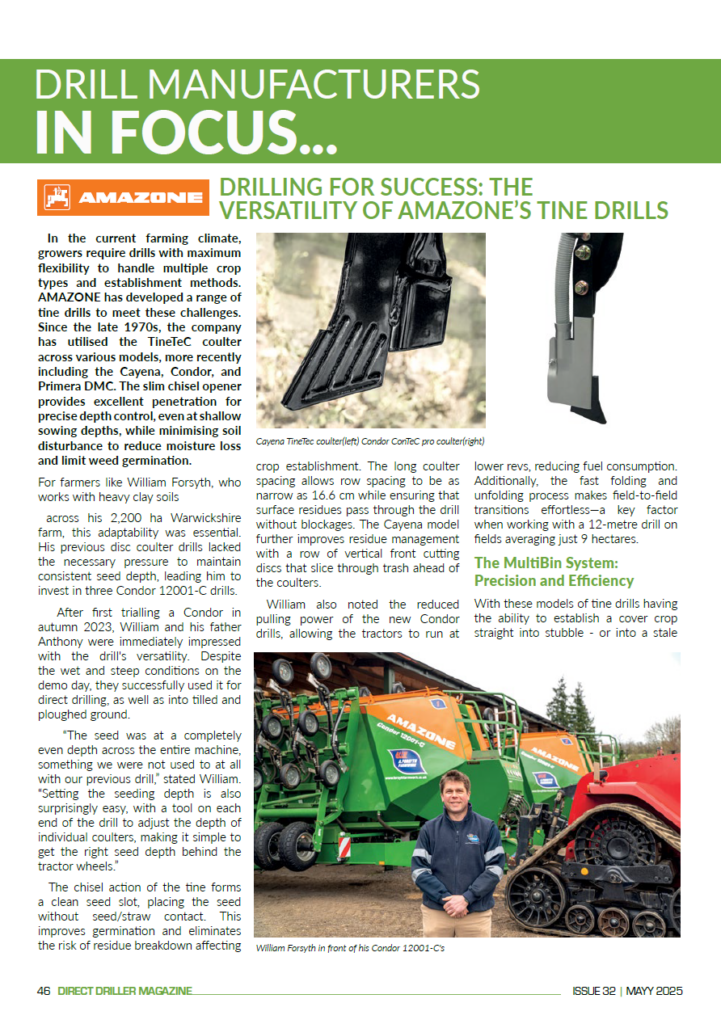

-

Foliars mean less nitrogen with increased yield and protein
Rosalind Platt is managing director of crop nutrition specialists BFS Fertiliser Services Limited.
Foliar nitrogen treatments later in the season reduce the total amount of nitrogen needed while maintaining or lifting yield, and increasing protein.
The pressure on farmers today seems more relentless than ever. Key priorities are to maximise soil health and nitrogen use efficiency while maintaining yields, as well as increasing protein levels in milling wheat. As a UK leader in crop nutrition for more than 75 years, BFS has developed fertiliser programmes tailored to meet these challenges.
One solution is our foliar nitrogen product, PolyNPlus Foliars; another – our protein enhancers, Profol and ProfiPlus – gives farmers flexible options to increase protein in milling wheat.
Over many years, independent research on PolyNPlus by one of Britain’s oldest agricultural research centres, NIAB, and international farm managers and agronomists, Velcourt, has verified the excellent results achieved by farmers.
Nitrogen, vital to maximise yields in crop production, is traditionally soil-applied as ammonium nitrate, urea or liquid UAN. Farmers would normally make two or three applications of soil-applied fertiliser in the spring. But later in the season the nitrogen use efficiency of these types of fertiliser, whether solid or liquid, can decline to 25 to 30%, especially when the conditions are dry – see charts.


When the leaf canopy is sufficient, PolyNPlus Foliars can replace a proportion of the soil-applied nitrogen for a wide range of crops including cereals, oilseed rape, sugar beet, potatoes and maize. Application timings combine well with fungicide.
Application rates vary by crop. As a guide, and depending on soil and weather factors, 25 litres of PolyNPlus – supplying just 8kg of nitrogen – can replace 40 to 50kg of any type of soil-applied nitrogen. This can cut the carbon footprint of the third application by 77 per cent – PolyNPlus’s sticky nature prevents nitrate loss, avoiding groundwater contamination, and the loss of ammonia is minimal.
Therefore farmers can apply less nitrogen while maintaining or increasing yields.
Paul Jannaway, a Wiltshire-based contractor working with several large landowners, said: ‘The yields and quality of the products we harvested were excellent. I applied PolyNPlus in all conditions, even when it was very hot, and had absolutely no scorch. I believe we will see a lot more of this product – PolyNPlus is the future.’ As well as using PolyNPlus successfully on wheat and rape, he has used it on oats just before the panicles or oat heads emerged, and recorded a bumper crop.
PolyNPlus is the only foliar nitrogen which has been extensively and independently trialled.
Protein enhancement
To increase protein later in the season for milling wheat showing potential, applying additional nitrogen at growth stages 69 to 75 is highly effective. BFS’s urea-based solutions boost protein and improve the prospect of premium prices.
BFS Profol (18N) is a urea solution and, as a foliar application, has a rapid uptake even in dry weather. It is used at 200 litres per hectare to provide 40kgs of nitrogen per hectare.
If a smaller quantity or reduced application rates are preferred, we supply ProfiPlus, for which the timing of application is more flexible, in 10 hectare packs. It is a hybrid product which includes a small amount of PolyNPlus, sulphur, magnesium and seaweed extract. These ensure rapid uptake and slower release of nitrogen, meaning ProfiPlus can be applied earlier than Profol, and making it more efficient than other solutions.
A foliar future
Foliar nitrogen is set to play an essential role in the future of farming. It is a cost-effective way of improving nitrogen use efficiency, maintaining or increasing yield and protein, reducing pollution and cutting a farm’s carbon footprint.

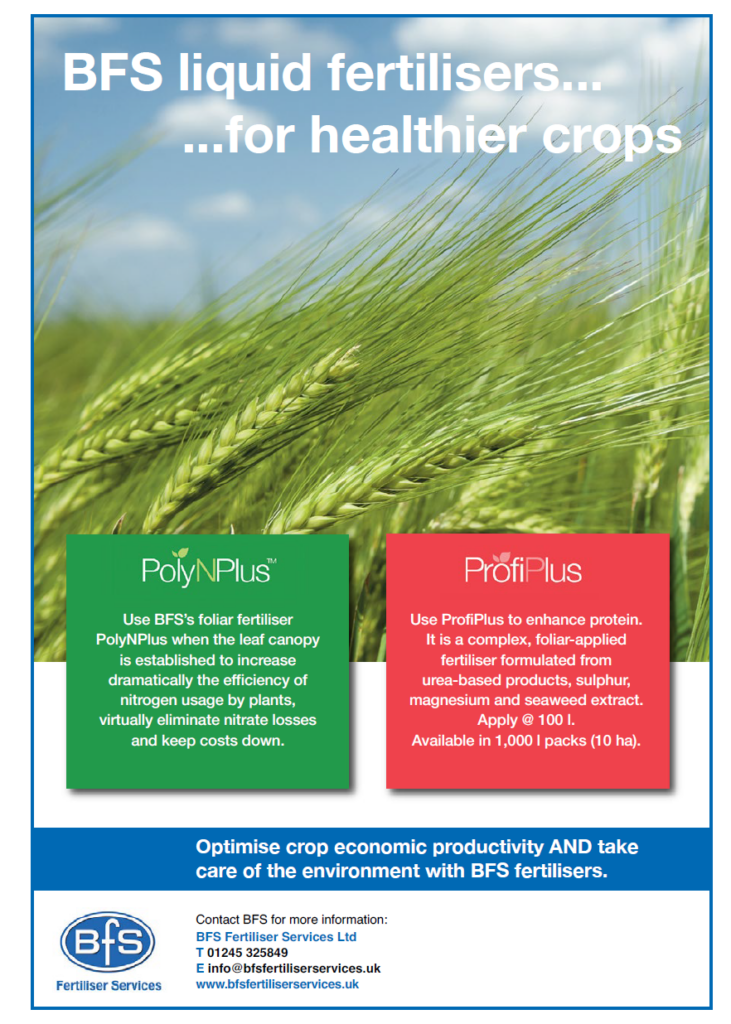
-
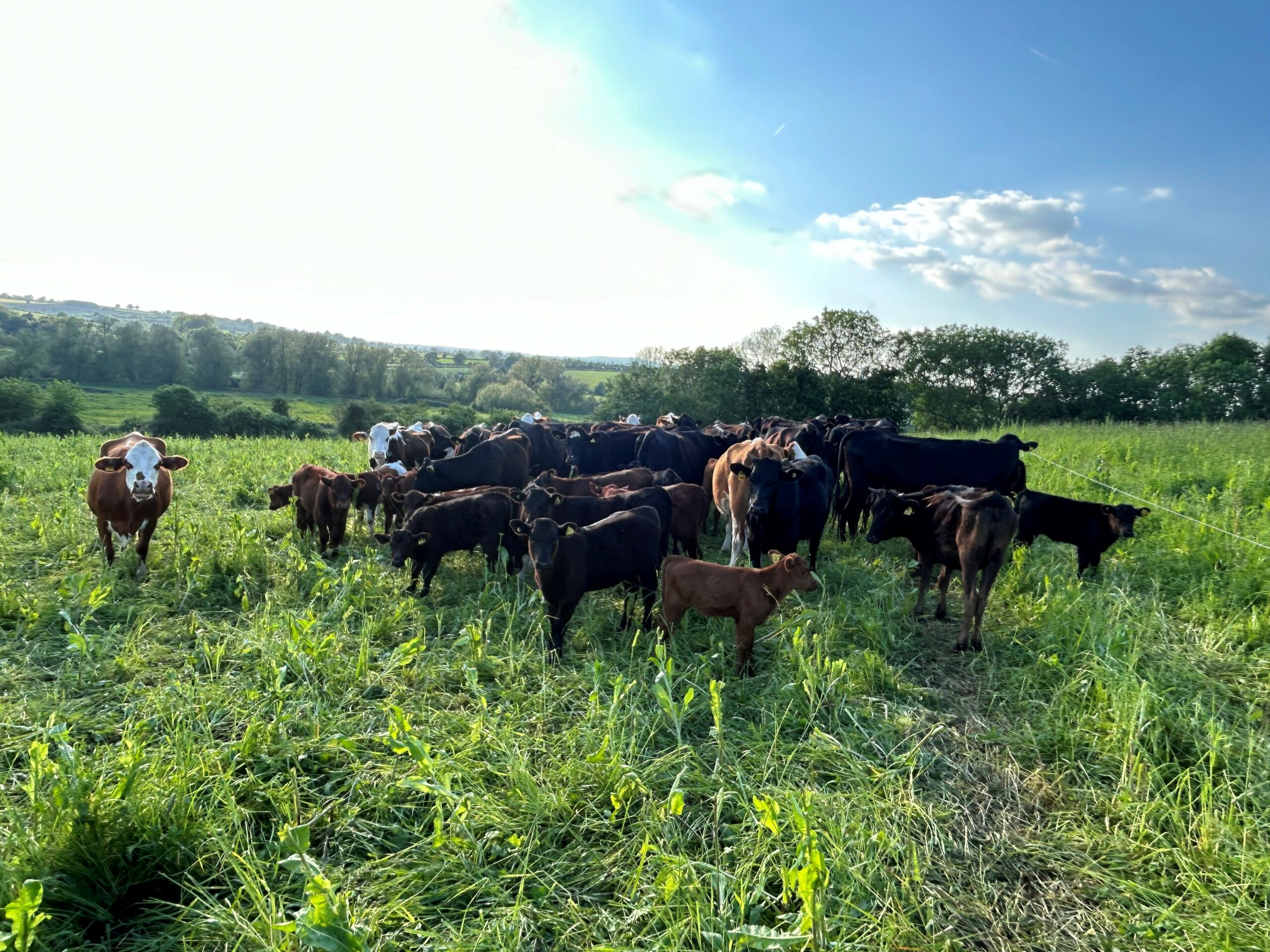
Farmer Focus – Ben Taylor-Davies
Embracing Diversity and Branding for Farm Resilience
Up horn, down corn – never has this statement been so true and never have the principles of regen ag been so ultimately important for profitability and the ironing out of the horrific bumps in the road ahead. 2024 saw us have almost double our annual rainfall average (measured since 1930) of 1130mm, that combined with the lack of light intensity and depressed combinable crop prices are a recipe for disaster when compared to just 2 years ago when everything looked so different for high input, high yield farming.
On 18th November 2020 we purchased 10 Hereford cross heifer calves and bucket reared them for the long term, these were going to be our suckler herd of the future, the following year we added 20 Angus heifer calves for the same purpose. I was once told that you bought chickens to lay and sell eggs every day, pigs every 4 months, sheep every 6 months and cows every 24 months. Spreading risk and income streams was the mission we were on after having all of the previous on the farm already. In hindsight we should have begun with the cattle and finished with the chickens to get ahead of the game, but we find out generally after the event.
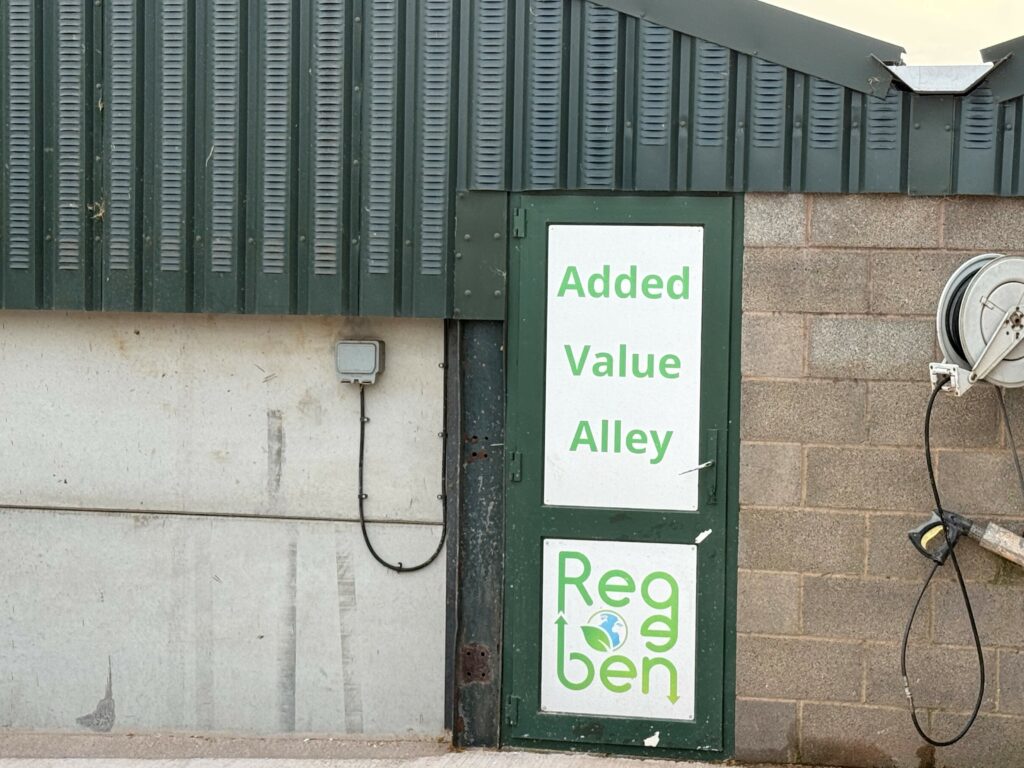
Cows and calving, purchasing a bull etc has gone well and have realised the size of the herd explodes in size when you’re into the 3rd year of cows calving, we seem to have over stretched the size of barns and the amount of herbal leys we have on the rotation and therefore about to sell 41 head, just the simple task of a TB test to clear first! The beef market is at all-time highs and as the time comes nearer, the nerves that the market will ‘hold’ become ever more real! If all goes according to plan, the cattle and lambs this year will bail out what looks like the doom of the arable side of the business, much like the vineyard did in 2022 when everything pretty much the crops died of drought stress.
Diversity is still the main driving force of the farm and I find it odd that when you talk to so many about diversity the response is we shouldn’t need to, blaming supermarkets and the like. I see things slightly differently and not sure blame needs to be apportioned, but equally the easiest action to take. The whole world works around profit, the easiest way to produce profit is to become desirable in what you have to sell, which often leads to the formation of a ‘brand’ in essence a brand is profit, it differentiates you from competitors and makes it almost impossible to make accurate comparisons between goods and services. As farmers of course, everything ‘bought’ onto farm is a ‘brand’ ag chem companies get a good kicking, but rarely if ever do I hear the same rhetoric when discussing say banks, and their profits are enormous, but have you ever tried to compare their services? interest rates are one thing, but ‘hidden’ charges are just about everywhere and at different values.
Why is this important? Well, we essentially buy in brands, to generally produce a commodity (of which has zero branding) and total price takers, only for the first thing to happen to the commodity we sell to be turned into a brand as soon as humanly possible! A chicken, plucked, wrapped and put on a shelf is easily comparable and therefore profitability is much lower to say taking that chicken, dicing it up, shaping into a dinosaur and covering it with breadcrumbs, the value of the chicken has trebled in this process.

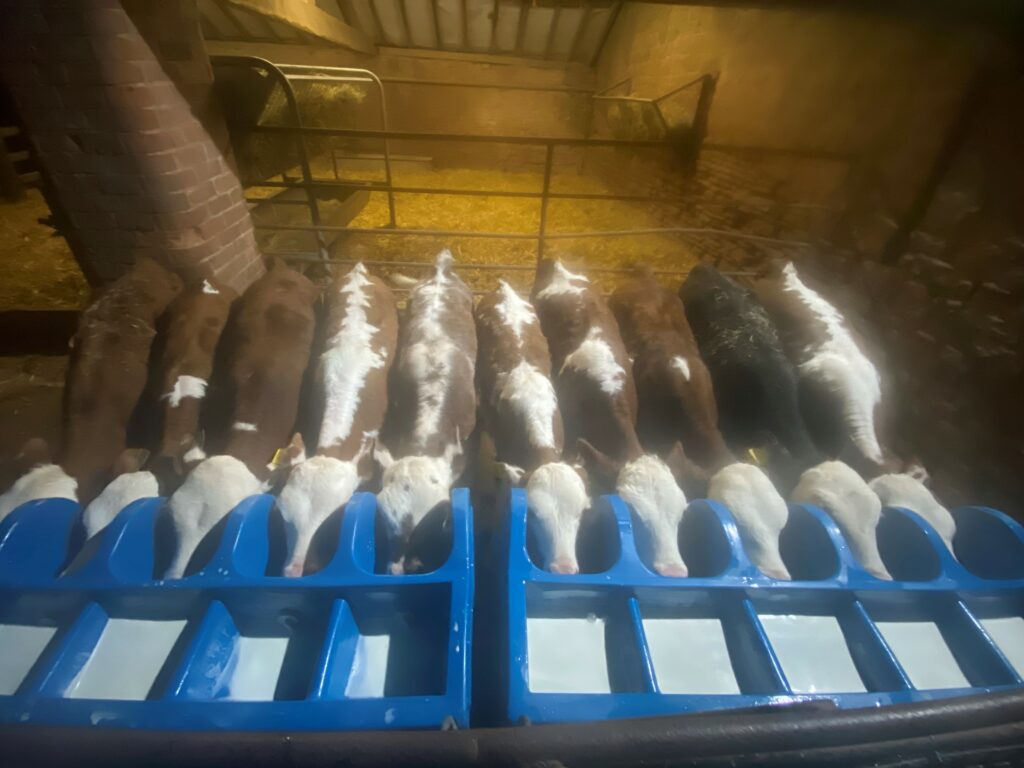


We have recently worked out that, not only do we need to take far more control of the ‘brands’ entering the farm but need to try and brand things leaving the farm. Wildfarmed wheat is a great start, but so much more can be done and the development of our ‘Added value alley’ where are producing ancient grain pasta, biltong, air dried meats and fruit biltong is showing the profit is in branding and not in chasing yield. I’m not sure any of this is that much different to what my great grandfather was doing, lots of diversity of income streams, selling local, by reputation of what he produced (branding). It was this generation that often tenants made enough from their produce to purchase their own farm, perhaps we need to look backwards in order to move forwards and realise that diversity is something we should all embrace whenever we seek profit and take ownership of your brand, it could and should build confidence and ultimately see a farms long term sustainability.
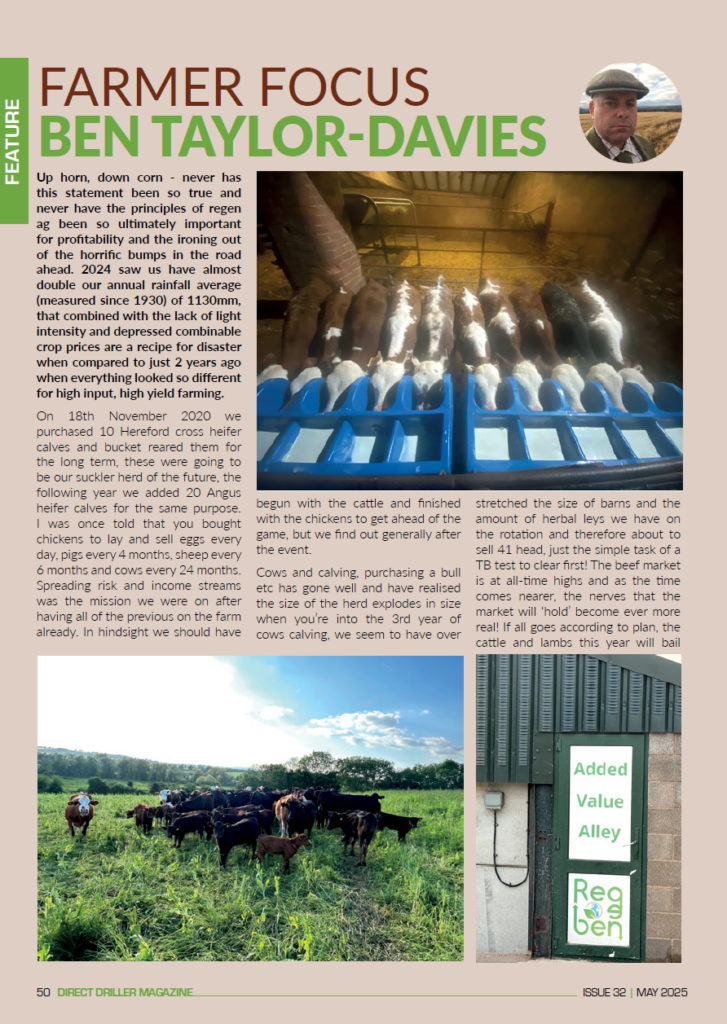

-

Agronomist in Focus – Cameron Ferguson
Responding to the challenges of climate change and extreme weather with versatile varieties
Although it’s fair to say that growing cereal crops in the western half of Scotland has always been a challenge with unpredictable weather and a shorter growing season, it’s now apparent that “tough” is becoming “very tough” following two out of the last three autumns’ where its been virtually impossible for many farmers to establish a winter wheat crop.
Born and bred in Ayrshire, I’ve worked for the last 5 and a half years for Agri-Source, a division of L S Smellie and Sons limited (pronounced “Smiley” by the way) so I’ve seen the landscape of farming in western Scotland change significantly over the last 40 years, and, in many ways, not for the better.
Farmers in my patch covering Ayrshire, Renfrewshire and some of the outer lying Islands within the county of Argyll, have always been incredibly resilient. But waiting for a drilling window that doesn’t come after you’ve pre-committed to major input purchases such as fertiliser and seed would test anyone’s patience.
As a boy, some of my happiest memories are of tobogganing in deep snow or ice skating on the local river Ayr. There were always four distinct seasons back then, and farmers knew and trusted the calendar to plan ahead of each new season. As of 2025, I can’t tell you the last time we had sufficient snowfall to justify getting a sledge out of the shed or the last time any local rivers where frozen over enough to skate on!
What I do know is that autumn, winter and often early spring have now become one mild, extremely wet, six month period where key establishment decisions are either not being made or, at best, being made during a rare good weather window making it increasingly difficult for agronomists and distribution, particularly the bigger agrochemical distributors, to react quickly enough. Fifteen years ago, all my customers ordered spring seed before Christmas. Now they’ll often leave purchasing decisions till as late as mid-March. Again, all down to the unpredictability of climate change.
For balance, can I also mention that, whilst I firmly believe we are living through a period of climate change, I am more sceptical about the source of temperature rises. Whilst there’s an argument for man-made contributions to rising global temperatures, we have to remember that the earth has been much hotter than it is now and that during that warmer period, before the last ice age, human beings weren’t industrialised or polluting the world with greenhouse gases. What is happening right now is the latest chapter in a world warming cycle that we’ve been living through for 10,000 years since the end of the last ice age. Scientists will argue about the speed of recent change, but, in my opinion, it’s difficult to form a definitive opinion in the face of conflicting science.
So, what’s to be done to help growers in my region, and many others in the UK, facing similar climatic challenges?
As an agronomist, the answer for me has to be science based. Specifically in plant breeding technology, focusing on improving genetic traits such as rapid early growth, earlier maturity and perhaps, most importantly, drilling flexibility rather than always prioritising yield and disease resistance.
When I look at the current AHDB lists, one variety – Blackstone, a Group 4 soft wheat, from breeder Elsoms Seeds stands out from the pack. I first saw the variety in National List year 2 trials in 2023. At first glance, it was taller than most and, in comparison to other plots, it looked relatively clean showing fewer signs of either rust or septoria – a good early positive.
However, when I saw the 6 month recommended drilling window for Blackstone, September 1st to the end of February, and then explored the varieties’ vernalisation data in more detail showing evidence of high to full levels of vernalisation for plots drilled in late March, I began to form an idea that this variety could be an answer for many growers caught in a difficult scenario of deciding if they should risk drilling a winter wheat in spring.
With another long, wet autumn and winter on the horizon for 2023/ 2024 I didn’t have to wait long to test my theory and I remember sitting down with farmer Jamie Kyle, a successful mixed farmer from the Robstone Farming Company, near Stranraer to talk through his spring rotation and the inherent risk involved in growing a winter wheat as a spring wheat.
Whilst I’ve no doubt many agronomists would rightly question my decision given the AHDB official advice and the breeder’s own recommendations, I would like to add that spring seed was very scare in spring 2024, we had the Blackstone seed on farm by late April, it was paid for, plus we’d assessed the vernalisation data supporting the case for Blackstone up to a potential late March drilling slot. The only question remaining in my mind was could Blackstone perform as well, if not better, than bonified spring wheats such as Talisker if drilled in April?
Drilling 10ha of Blackstone at a high seed rate of 400 seeds per m2 on April 28th following a late harvested crop of potatoes the crop got away well, racing through its early growth stages and competing well against the main weed burden of annual meadow grass. On nutrition, 2 main splits of Nitrogen were applied totalling 160kg/ha, and, on fungicides, we went with just a 2 spray program. Spring is a relatively short season in west Scotland, so any septoria present was coming into a growing crop, not waiting to explode since the winter so I believed a 2 spray strategy was justifiable.
Applying the T1 spray on June 12th, we went with 1l/ha of bixafen + prothioconazole + spiroxamine alongside 1l/ha of folpet. This was applied one week after Blackstone had received its second split of Nitrogen and, I have to say, it had tillered well and was looking exceptionally lush. To give it an extra boost we applied 3l/ha of Seamac Gold foliar feed, and, on July 16th, we applied the main T2 ear-spray using the same T1 chemistry but adjusting the dose rates to 1.2l/ha on the bixafen + prothioconazole.
Blackstone stood very well showing no signs of lodging but, despite its height and although it looked quite forward, I felt there was no requirement for a plant growth regulator.
Harvesting on October 3rd, Blackstone combined well achieving a final overall yield of 7.4t/ha at 15% moisture, as good a yield as any spring wheat I’ve grown and a remarkable performance for a winter wheat sown almost 2 months outside its officially recommended drilling window. Jamie Kyle was delighted and will be increasing his area of Blackstone to 16ha for crop25 with a firm eye on the distilling market again with Grant’s distillery on his doorstep.
There’s definitely a need for more varieties with Blackstone’s drilling flexibility and well done to breeder Elsoms Seeds for stepping up with their Responsive Rotations initiative to try to address some of the ever-growing pressures faced in modern day farming. Blackstone is certainly a step in the right direction.
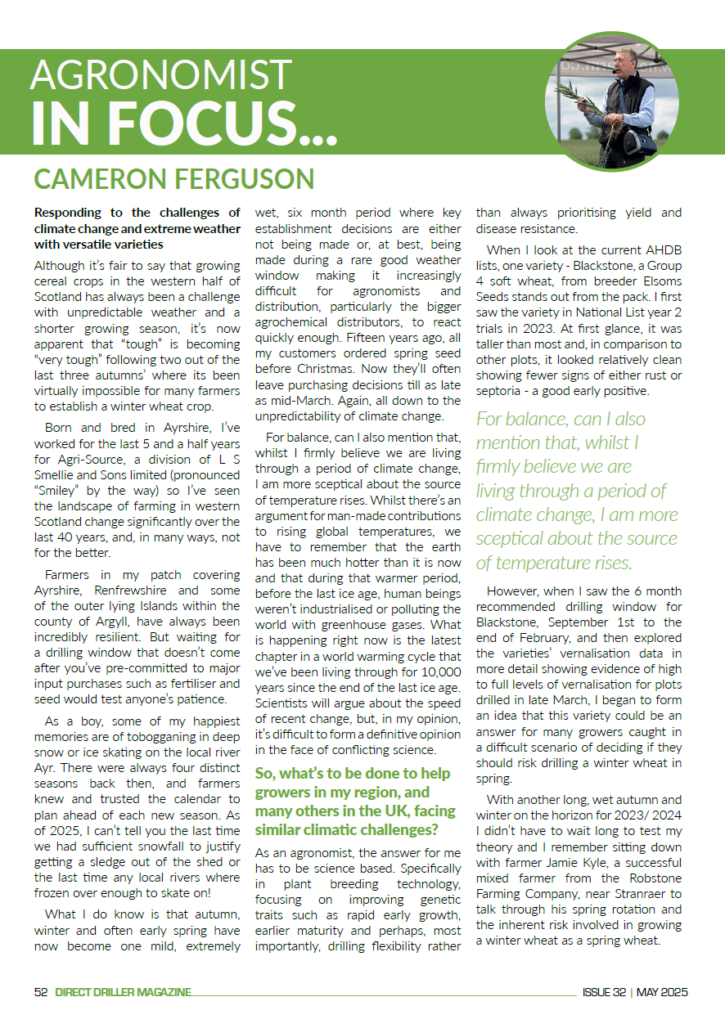
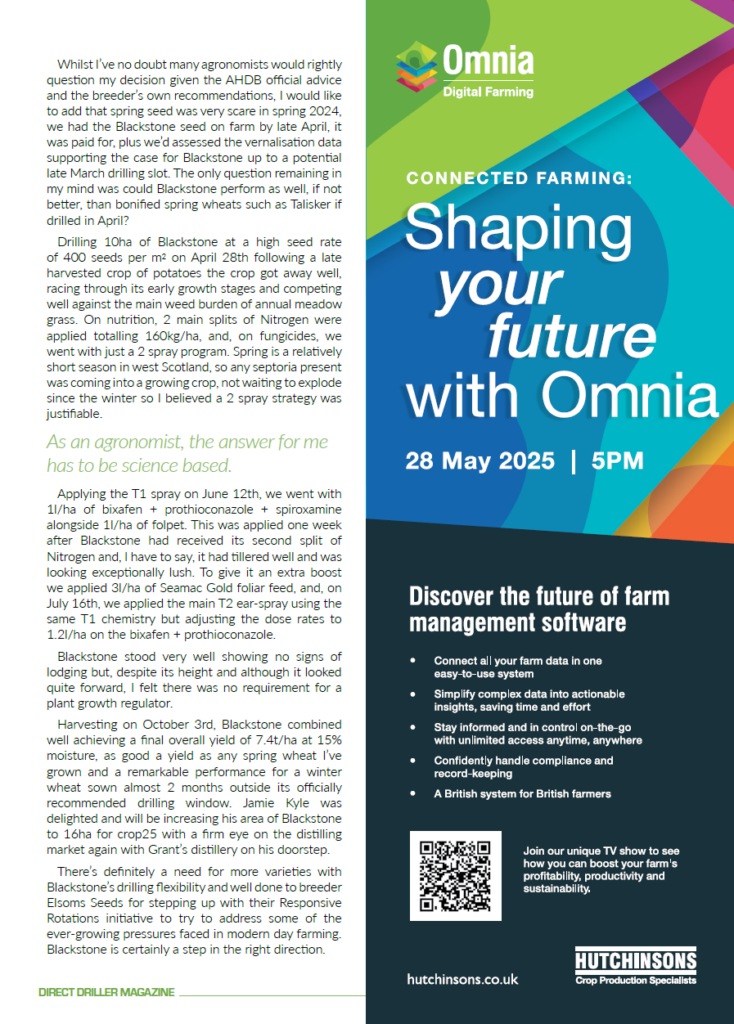
-
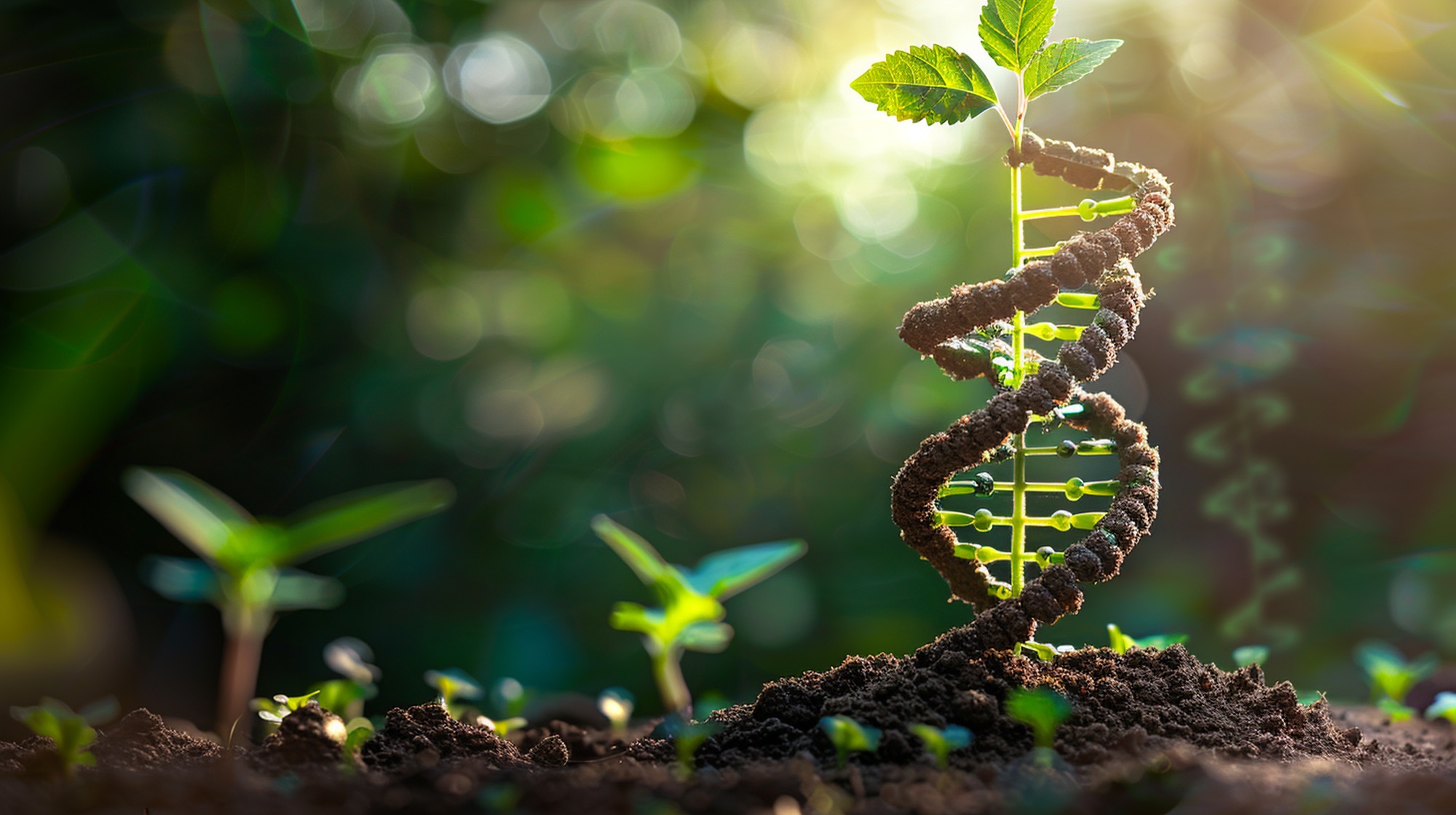
Unlocking the power of genomics: What it means for farmers
Biostimulants are becoming a staple in agriculture, enabling growers to boost crop health, resilience, and yields in a cost-effective way. Until now, farmers and agronomists have assessed the efficacy of these products through phenotypic observations – measuring visible changes such as larger root systems, greener leaves, or improved overall plant vigour. While this approach has served the industry well, genomics is now enabling a deeper, more precise understanding of how and why these changes occur.
What is plant genomics?
Plant genomics is the field that explores the complete genetic blueprint of plants, including their DNA structure, function, evolution, and interactions, with the aim of gaining insights into plant biology and enhancing crop performance.
The benefits of biostimulants are generally evaluated based on physical changes observed in the field. For example, data from the University of Nottingham has shown how certain biostimulants lead to enhanced root growth and greener leaves. However, this only tells part of the story. With genomics, it’s possible to go beyond surface-level observations and identify the genotypic responses driving these visible improvements.
“Genomics is not about altering the plant’s DNA, it’s about understanding genetic pathways and behaviour, i.e. ‘reading the book without altering the words,’” explains John Haywood, at Unium Bioscience. “It’s our aim to understand the link between plant biology, genetics, nutrition, and biostimulants, to create solutions for growers, allowing us to build a deep understanding of the mode of action of our products,” he says.
John Haywood explains that this targeted approach enables the creation of more reliable and lower-cost solutions for farmers. He highlights that 60-70% of crop production is lost to abiotic stress (environmental stress) compared to just 20% lost to biotic stress (pests, diseases, and weeds). “However, only around 40% of farmers are using biostimulants and biologicals to mitigate biotic stress. With genomics, farmers have the power to use reliable science to create future solutions, addressing both biotic and abiotic stress more effectively.”
Understanding plant stress at a genetic level
Genomics provide valuable insights into how crops respond to abiotic and biotic stresses. Whether plants are facing drought, heat, cold, or disease pressure, genomic analysis reveals which genes are being upregulated or downregulated -essentially showing how the plant is reacting on a molecular level.
Layne Ellen Harris PhD, owner and research consultant at Foresight Agronomics, specialises in plant gene expression in response to biological agricultural products., and emphasises that gene expression is the key to understanding what is happening beneath the surface of the plant. In the past, the industry has observed that “biostimulant plus application equals expected results,” but the reason why it happens remained a mystery. Genomics answers this by revealing the central dogma of molecular biology – the process of information transfer in cells from DNA to RNA to protein. By identifying which genes are being expressed in response to stress or biostimulant application, scientists can see how plants adjust their biological pathways.
“For example, drought stress triggers biochemical and genetic pathways within the plant to develop coping strategies such as being more efficient with the way it uses water. If we can use products that trick the plant to elicit the same responses, making it think it’s stressed, but making it be more resistant to stress down the road, that’s going to have huge benefits to farmers,” she says.
Benefits to farmers
The greatest advantage of using genomics in biostimulant development is the increased likelihood of seeing a strong return on investment (ROI). With a clearer understanding of how products work at the genetic level, farmers can be more confident that applications will deliver consistent and measurable results.
Tim Eyrich, head of agronomy and innovation at HELM Agro, has over 41 years of expertise in agronomy and horticulture and points out that studying genomics at the field level reveals the interconnectedness of biostimulants and crop nutrition. “Biostimulants rely on optimal nutrition to be effective. By understanding this relationship, farmers can ensure that nutrient dependencies are addressed before applying biostimulants. This enhances both product performance and ROI.”
He also highlights the Importance of timing, explaining that in trials with the biostimulant, Scyon, applying it as early as possible (at the three-leaf stage in wheat) allowed plants to develop better coping strategies for abiotic stress, resulting in improved phenotypic characteristics.
Additionally, genomics helps biologicals specialists like Unium Bioscience accelerate the development and positioning of new products, bringing effective solutions to market faster and at a lower cost – savings that can ultimately be passed on to farmers.
The future
The integration of genomics into farming practices is more than just a scientific advancement – it’s a practical tool for boosting productivity, improving crop resilience, and maximising the efficacy of biostimulant applications.
By harnessing the power of genomics, farmers can make more informed decisions, optimise product usage, and ultimately achieve better yields and profitability. As John Haywood puts it, “this targeted approach reduces risk and enables more strategic farming decisions. With ongoing research into gene pathways, nutrient dependencies, and optimal application timing, genomics is shaping the future of sustainable, profitable agriculture.”

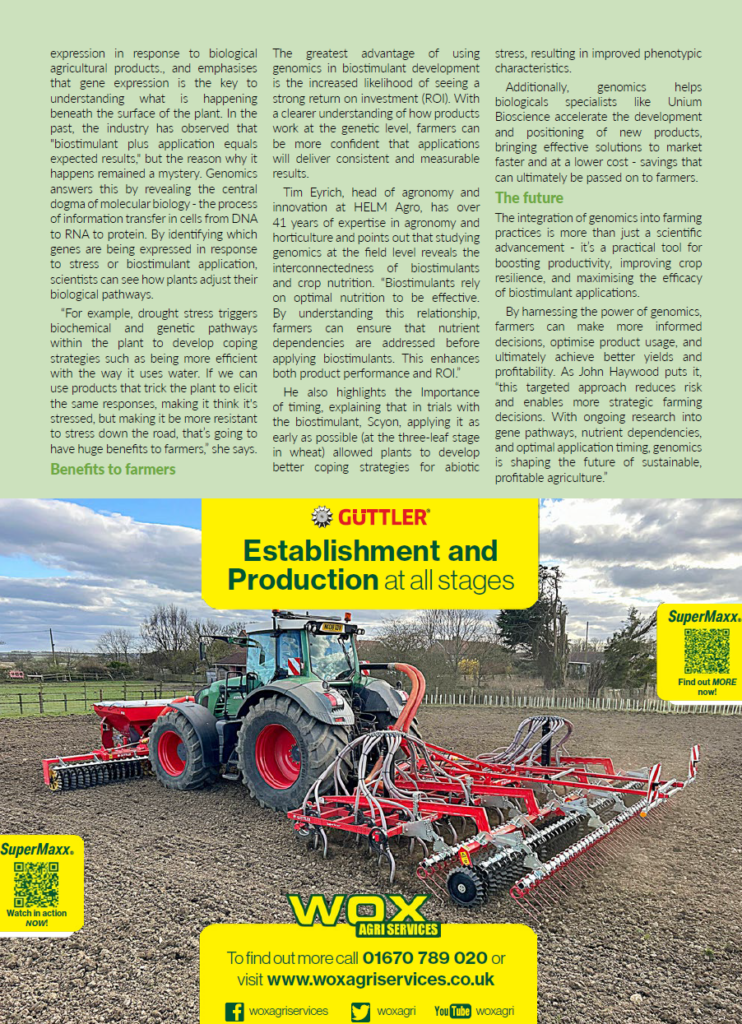
-
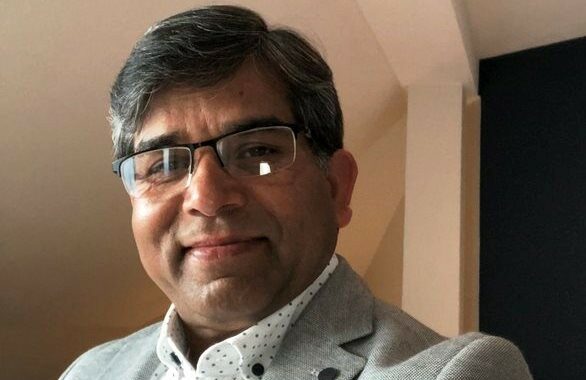
UK National Action Plan Overlooks Biologicals – WBF Urges Regulatory Reform
The UK Government’s revised National Action Plan (NAP) for the Sustainable Use of Pesticides (2025) was published to reduce pesticide risk and promote more sustainable crop protection practices. However, for the World BioProtection Forum (WBF)—the voice of the biologicals industry—this plan represents a critical missed opportunity. While the NAP recognises Integrated Pest Management (IPM) as a key element of the UK’s sustainable agriculture vision, it fails to address the fundamental enabler of IPM’s success: the availability and adoption of biological crop protection products.
Without Biologicals, IPM Cannot Succeed.
Biological solutions, including biopesticides, microbial products, and natural repellents, are cornerstones of modern Integrated Pest Management (IPM) strategies. However, outdated, slow, costly regulatory systems hinder their integration into UK agriculture.
The NAP promotes IPM but does not provide a pathway to ensure farmers can access the tools necessary for its implementation. This oversight makes the plan aspirational rather than actionable. WBF warns that IPM cannot function effectively without a strong pipeline of registered biologicals to replace withdrawn chemical pesticides.
Biologicals Still Trapped in a Chemical Framework
Despite widespread scientific agreement that biopesticides are safer, break down more quickly, and pose significantly less risk to human health and the environment, they are still evaluated under a regulatory system designed for synthetic chemicals.
The UK continues to operate under EU Regulation 1107/2009, a framework that subjects all pesticide products—regardless of their risk profile—to the same level of scrutiny. Consequently, biologicals may take 4 to 5 years to register in the UK. In the EU, this process can extend even longer—6 to 7 years—without prioritising low-risk solutions.
In stark contrast, Brazil and other Latin American countries have embraced progressive regulatory models that permit the assessment and approval of biologicals in as little as 12 months. These frameworks are based on risk proportionality, facilitating swift adoption without sacrificing safety or efficacy.
DEFRA Must Act Now
The WBF has engaged with DEFRA and the Health and Safety Executive (HSE) for several years to highlight this area’s lack of regulatory innovation. In March 2024, the Forum hosted a Westminster conference in 2023 with policymakers, researchers, and industry leaders to present clear evidence and offer practical solutions. The message was consistent and unified:
“Biologicals must be prioritised, and the UK should establish a dedicated, fast-track registration pathway that acknowledges their low-risk status and crucial role in sustainable farming.”
The WBF has also published a White Paper outlining how the UK can reform its regulatory approach post-Brexit. Unfortunately, the NAP fails to reflect any of these proposals, nor does it reference the need for timelines, provisional authorisations, or support for innovation in the biological space.
Farmers Face a Dangerous Gap
Chemical pesticides are being phased out due to environmental and health concerns, but there is no rapid system to fill the gap with biological alternatives. This widening void makes farmers vulnerable—unable to access new solutions yet restricted from using conventional ones.
WBF Chair and Founder Dr. Minshad Ansari warns:
“We are heading toward a future where UK farmers will be left without effective tools to manage pests and diseases. If the government continues to delay biopesticide reform, it will threaten food security, environmental targets, and international business.”
The Call for a Five-Point Reform Plan
To unlock the potential of biological crop protection, the World BioProtection Forum is urging the UK Government to implement the following reforms without delay:
1. A Dedicated Biologicals Strategy
Introduce a national policy and funding framework that prioritises developing, commercialising, and adopting biological crop protection products.
2. A Fast-Track Registration Pathway
Develop a risk-based, proportionate regulatory process for biopesticides, aiming for a timeline of 12–18 months, modelled on international best practices.
3. Post-Brexit Regulatory Independence
Depart from EU Regulation 1107/2009 and create a UK-specific framework designed for the unique characteristics of biological products, utilising science-based risk assessment.
4. Support for SMEs and Innovation
To accelerate innovation, offer technical and financial support to small and medium-sized enterprises (SMEs), including grants and reductions in registration fees.
5. Demonstration and Adoption Programmes
Initiate government-supported on-farm trials, public procurement programs, and demonstration projects to assess the effectiveness of biologicals and promote farmer adoption.
The Time for Consultation Is Over
The biological sector does not seek shortcuts or diminished safety standards. It demands fairness, clarity, and urgency—a system that aligns regulation with risk and innovation with opportunity.
The UK has the chance to become a global leader in sustainable crop protection and post-Brexit regulatory reform. But this cannot happen if we continue to delay the registration of solutions already proven safe, effective, and aligned with our climate and biodiversity goals.
WBF Remains Committed
The World BioProtection Forum will continue to advocate for a more progressive and science-aligned regulatory framework. We remain committed to working with DEFRA, HSE, and UK policymakers to develop a modern system that empowers innovation, protects public health, and ensures farmers can deliver secure and sustainable food production.
Until then, the message is clear:
Without biologicals, the goals of the NAP—and the future of IPM—cannot be achieved.
For media inquiries, quotes, or interviews with Dr. Minshad Ansari, contact:
📧 wbf@worldbioprotectionforum.com
🌐 www.worldbioprotectionforum.com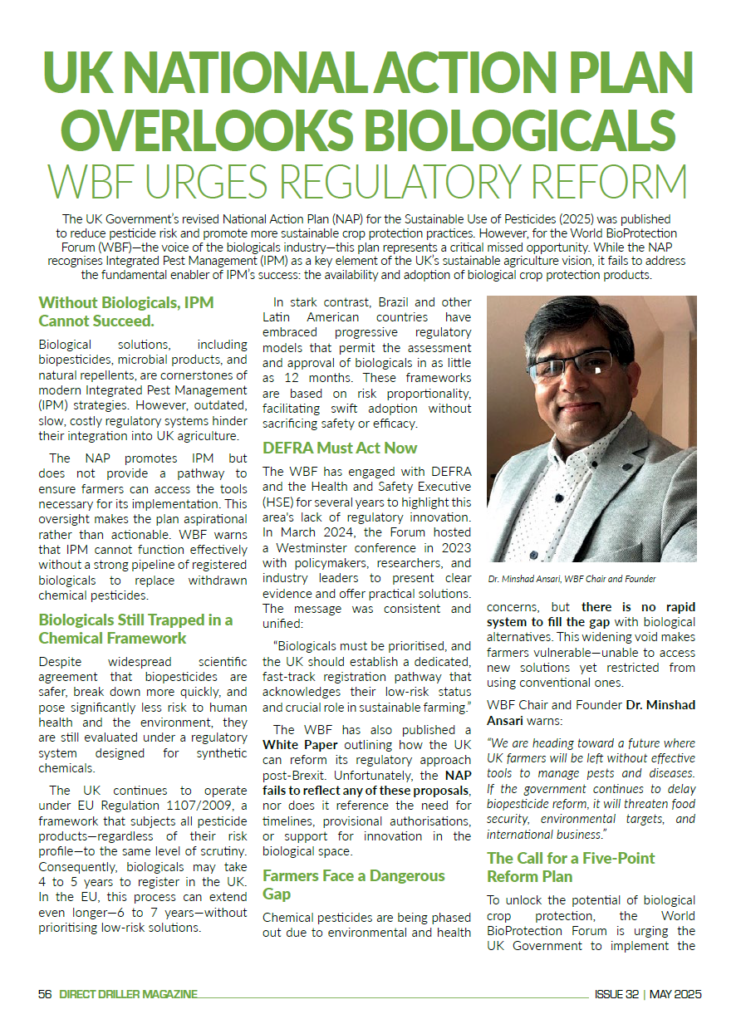
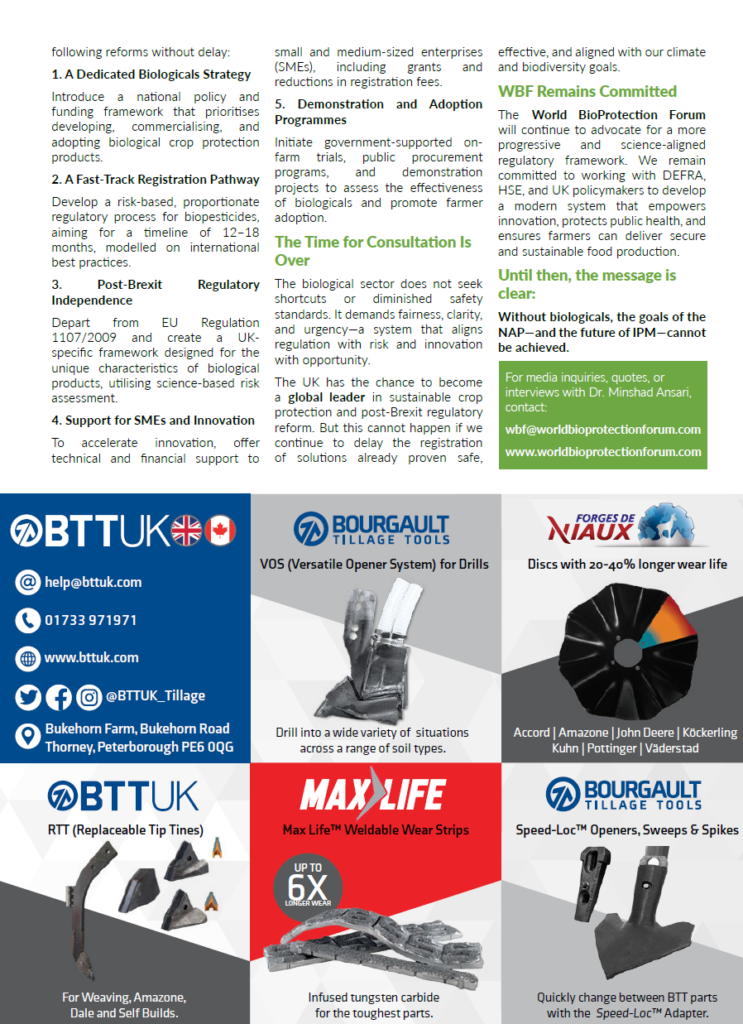
-

Farmer Focus – Andy Cato
Mar 2025
On an April day 90 years ago, Hugh Bennett was testifying to the US congress, trying to instil a sense of urgency about the precarious state of American soils. As he spoke, soil blew in from the great plains 1500 miles away, blocking out the sun and giving the day the name by which it would later be known: Black Sunday. As the light failed, he pointed to the window, “This, gentlemen, is what I’m talking about”

In the absence of evidence so stark, it can feel frustratingly hard to galvanize political action. This winter I’ve become more familiar with the corridors of Parliament than I ever could have imagined when playing jazz in the working men’s clubs of 1980s West Yorkshire, or records in Ibizan DJ booths, or farming for 15 years in SW France. After a long time spent working with members of the DEFRA team on an SFI option that would reward farmers for delivering measured nature outcomes whilst growing food (rather than instead of it), the news of the SFI suspension came as an unexpected blow. More immediately, it was a financial nightmare for many farmers, who began to doubt that any future government support could be relied upon.
The message I’ve delivered at various forums over the last few months is always a version of trying to encourage a more holistic view; that the only affordable long term flood protection is supporting farmers to improve infiltration rates in their soils, and paying them to do so isn’t a subsidy but an investment with superb returns. Or that supporting nature rich food production is the only way we are likely to meet legally binding 2030 species recovery targets without offshoring even more of our food supply.
Perhaps the reason why well-applied regen, a solution to so many problems, is being embraced more slowly than it should be, is because it’s a system not a practice. After centuries of scientific advances based on reductionist methodology – a single variable in a controlled environment – our collective ability to think systemically is compromised. System-based research sits outside familiar disciplines. But with the potential of AI to help us understand complexity, soil and ecosystem science should be entering a new golden age.
On 1st January, Ed Brown become head of farming at Wildfarmed. Already his vast experience has been a huge addition for our community of growers. His insights made our late winter open days some of the best received of any Wildfarmed community events.
He and I are working together at my farm, including a first try (for me) at growing rape. With buckwheat and berseem clover companions acting as flea beetle decoys, the crop got off to a good start. Then, late February, the pigeons found it. In a matter of days, they transformed a verdant, leafy canopy into bare earth riddled with stripped and battered stems; a miniature of World War One woodland. Who needs over-winter grazing with pigeons like these?
A week’s worth of astonishingly expensive double action bangers seemed to give the leaves just enough breathing space to get away again. Time will tell what impact the birds have had on yield.
Yet another illustration of why we need nature on farm spreadsheets was illustrated by research which discovered that when swifts are foraging, they seek out the larvae of the cabbage flea beetle.
There has been a 40-50% decline in swifts since 1995, largely linked to declines in insect populations. Meanwhile, Rape continues to be decimated by flea beetle, despite repeated special dispensations to use neonicotinoids. The area sown to Rape has declined 59% since 2012. Yet for those with rent to pay, astronomical machinery costs and no SFI support for the foreseeable future, taking a long-term view on how to get the swifts back is not a realistic option. Collectively, however, we know that we can.
Results from Wildfarmed’s 2024 insect abundance trial with Bristol University across 17 sites are still awaiting peer review, but the headline result was a year-one doubling of insect biomass in Wildfarmed fields compared to neighbouring Conventional controls. One way or another, we must find a way to get this financially rewarded in the same way that we have begun to do for water quality. Farmers can only deliver what they are incentivised to deliver, and this has to include nature-based food production.
A lot of regen discussions are suffering from carbon myopia. This is despite much of recent history being a story of narrow optimisation at the expense of the whole. As an example, when timber was the main driver of economic growth, pioneering 19th century Prussian tree scientists increased production by overseeing the felling of vast tracts of ancient forests, replacing them with managed, fast growing coniferous monocultures. Their yield and carbon numbers were excellent. It was an ecological disaster.
Spring drilling has shone a light on how bad it’s been these last few years. When was the last time when, early April, everything was drilled and there was a moment to watch things grow? On the lower land at Colleymore, where there are still some compaction issues to deal with, it involved a compromise. Whilst the soil surface was dry and it would drill well, a few inches down it was still wet clay. Cultivating to alleviate compaction was not a sensible option. It would wreak havoc on soil structure, create clods that would have to be intensively worked down, and mean losing all the moisture which, in a climate that increasingly oscillates between extremes of wet and dry, we need to retain. So instead, we added a brassica to our wheat and pea combination, in the hope that its tap root would do some of the decompaction work for us. These went in with a dose of fish hydrolysate and seaweed to get microbial activity off to the best possible start.
As we look to scale outcomes measurements across an expanding Wildfarmed area, we’re doing various versions of calibrating physical measurements with AI alternatives; insect pan traps with in-field devices that identify bugs according to the beating of their wings, or SAP analysis with satellite estimates of nitrogen requirements.

This is an extract from the latest Messium satellite update for their trial field at Colleymore. Despite the yield estimate at 7.98T, the prediction is that the final nitrogen dose can be reduced from 40kg to 34kg. But it’s also a stark insight into the importance of timeliness – a difference of days in application dates means the crop would go hungry at a critical point. We’ll be combining this with a Hillcourt Research flag leaf assessment of crop nutrient levels. Before the plant begins its transfer of nutrients into the grain, we want to see if there is adequate nutrition to hit milling spec. If not, a small amount of foliar N will go a long way to correcting it. “Test, don’t guess” as John Kempf is fond of saying. These two data sets should hopefully remove much of the guessing from a good yield of milling spec wheat grown as efficiently as possible.
At Diddly Squat, a Wildfarmed oat and bean crop followed the summer cover crop described in the last bulletin. With the smaller cover crop seeds drilled too deeply, this inevitably left some spaces which blackgrass was all too happy to fill. But the fields nevertheless had an abundance of worms by autumn, something which even Kaleb was smiling about. The oats and beans, planted with a seaweed application, were also coated with a trial batch of Kempf’s Biocoat gold, a microbial and nutritional seed stimulant. There’s no great difference in plant size, but the difference in soil aggregation compared to the other side of the hedge signposts the cumulative biology of cover crop, inoculant and seaweed.

Impressive also to see roots burying into stone…

We’re using the same small doses of carbon coated N as we are at Colleymore, making sure the nitrogen is used as much as possible by the oats and there aren’t excess nitrates for the blackgrass to feed on.
Avoiding these nitrates is of course as critical for waterways as it is for blackgrass control. The roll out of direct-to-Wildfarmed-grower payments from Water Companies continues. Since the last update, Harriet, Rob and the team have now reached agreements with 6 of the 9 biggest providers.
In a show of solidarity that feels sadly distant today, Crew town hall, March 1936, saw 500 representatives of the County Health Authorities, the Farmers’ Union and the medical profession, all gathered to hear the conclusions of Cheshire doctors following their investigation into the nutritional quality of food and its impact on health. The Medical Testament they presented cited reasonable progress in curing disease. But failure in the other half of their brief – preventing sickness.
“yet most of this sickness is preventable and would be prevented by the right feeding of the people. We consider this opinion so important that this document is drawn up in an endeavour to express it and to make it public.”
Informing consumers about the nutritional impact of food grown in living soils is proving to be highly complex. Advertising rules drawn up for a different food system make it very hard to talk about either the absence of toxicity – ie the fact that we test our grain to be free of pesticide residues, or, beyond the basics of fibre, the presence of nutrition
Over the last few years, we’ve measured significant increases in antioxidants in Wildfarmed crops relative to conventional controls. With US company Edacious we’re now taking this into the production process to see what happens to nutritional differences through the milling and baking process.
The Bio Nutrient Institute researched nutritional quality across around 3500 samples of 21 different crops. It’s author, Dan Kittredge, found that:
“despite what you may predict, there wasn’t a clear link between increased nutrient density and the crop being grown in a regenerative or organic-certified system. There was no connection between increased nutritional quality and whether the crop was grown locally, came from a farmer’s market, or a supermarket. Even more surprisingly, nutrient density wasn’t correlated with the levels of macro or micronutrients or carbon in the soil, nor was it correlated with specific regenerative practices…the only factor that consistently predicted increased nutrient density was soil respiration, a key indicator of the amount of life in the soil”
Soil respiration and infiltration are emerging as useful indicators of overall health and are a shorthand perhaps for the connectivity analyses favoured by Andy Neal at Rothamsted, who’s topographical soil videos show subterranean life from a microbe’s perspective. It’s thwarted attempts to move around compacted soils resemble the dark, dead ends of, in Andy’s words, “a 70s housing estate”.
Andy’s recent study at FarmEd shone a light on the endless difficult compromises faced by farmers. After four years of herbal ley, both the fungal / bacterial biomass ratio and soil structure were similar to that observed in undisturbed, permanent pasture. Yet such was the impact of ploughing, cultivation and sowing that, four weeks after planting, the fungal bacterial ratio and structure had reduced to a point where it was no longer significantly different from that observed in the glyphosate managed, continuous wheat plot.
Nicola Canon, professor at the Royal Agricultural University, invited me to speak at her lecture to celebrate the 180th anniversary of the university’s first cohort of 35 students. During the Q&A I was asked what the biggest challenge for Wildfarmed was today. My mind raced with any number of problems we need to solve. But on reflection, it became clear that they are all versions of the same problem. From field to plate, the Wildfarmed team are constantly working with the best available information to optimise the intersection of good farmer outcomes, quality food, nature recovery, and high street affordability. Doing so requires avoiding dogma and embracing nuance. The most difficult challenge of all is embracing nuance in an increasingly binary world. But if we don’t, we won’t solve anything.
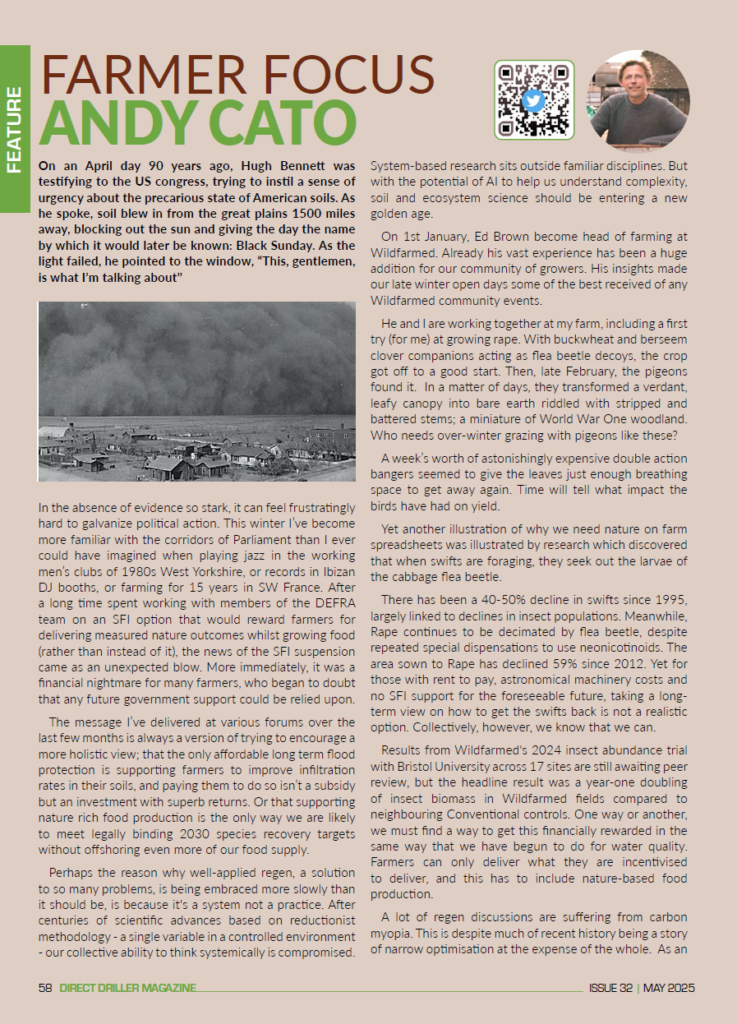
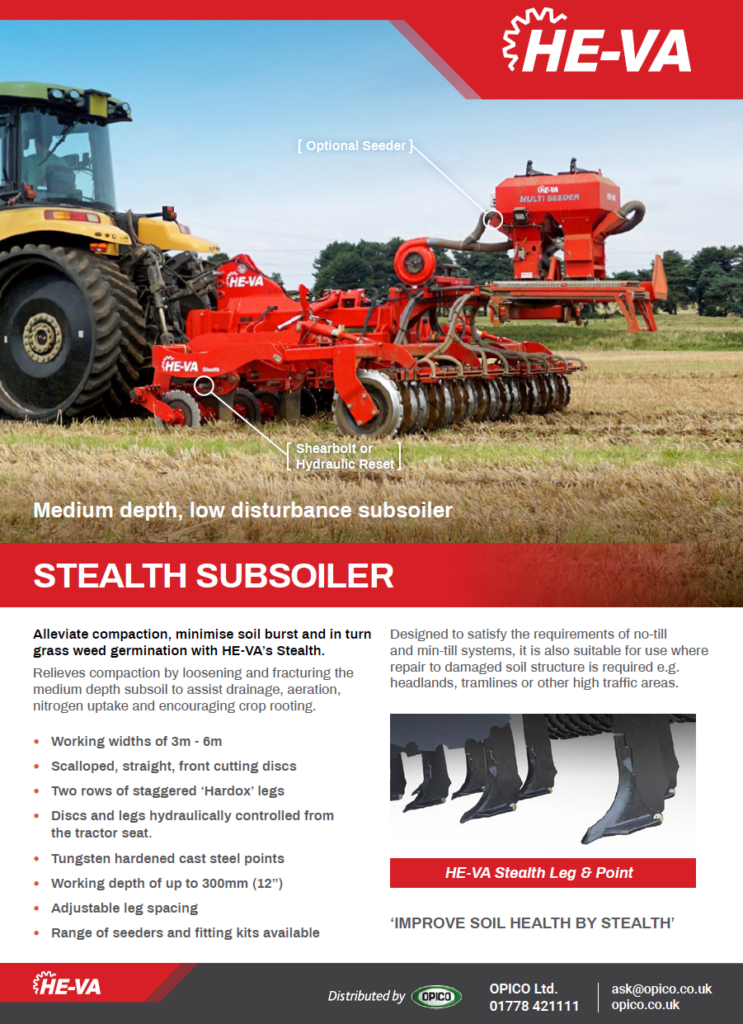
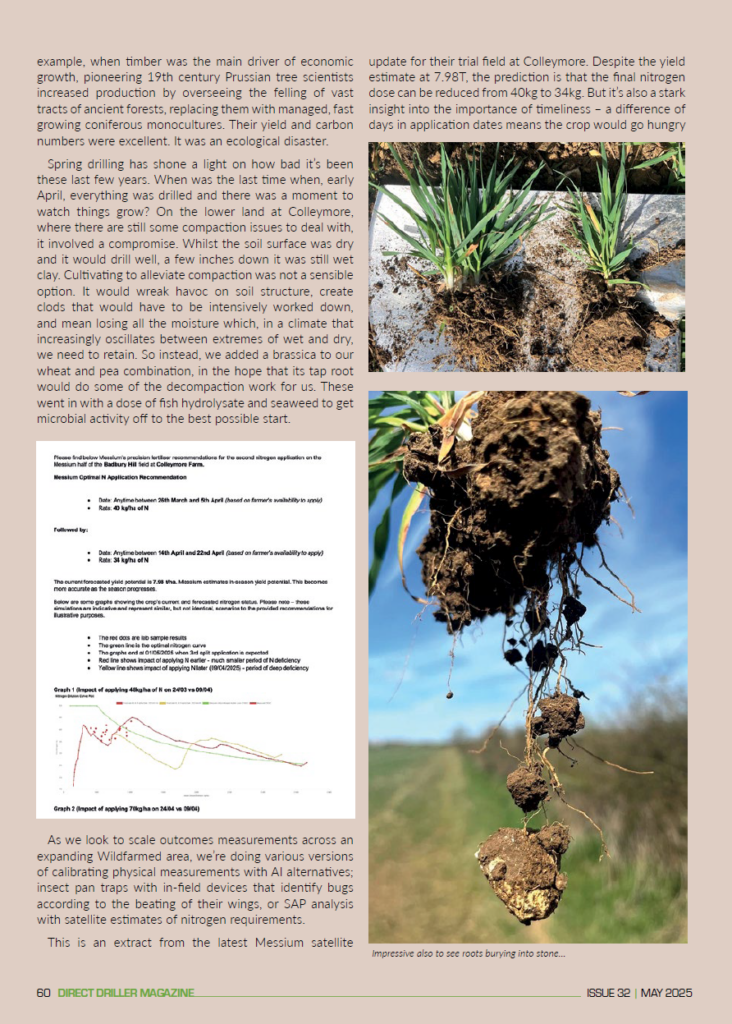
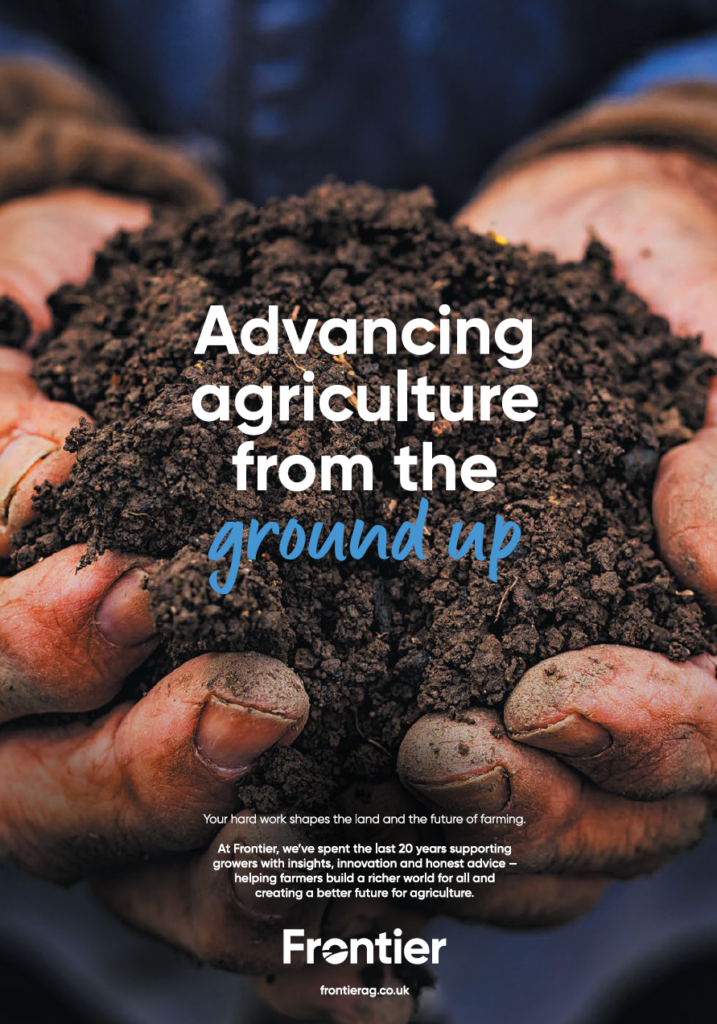
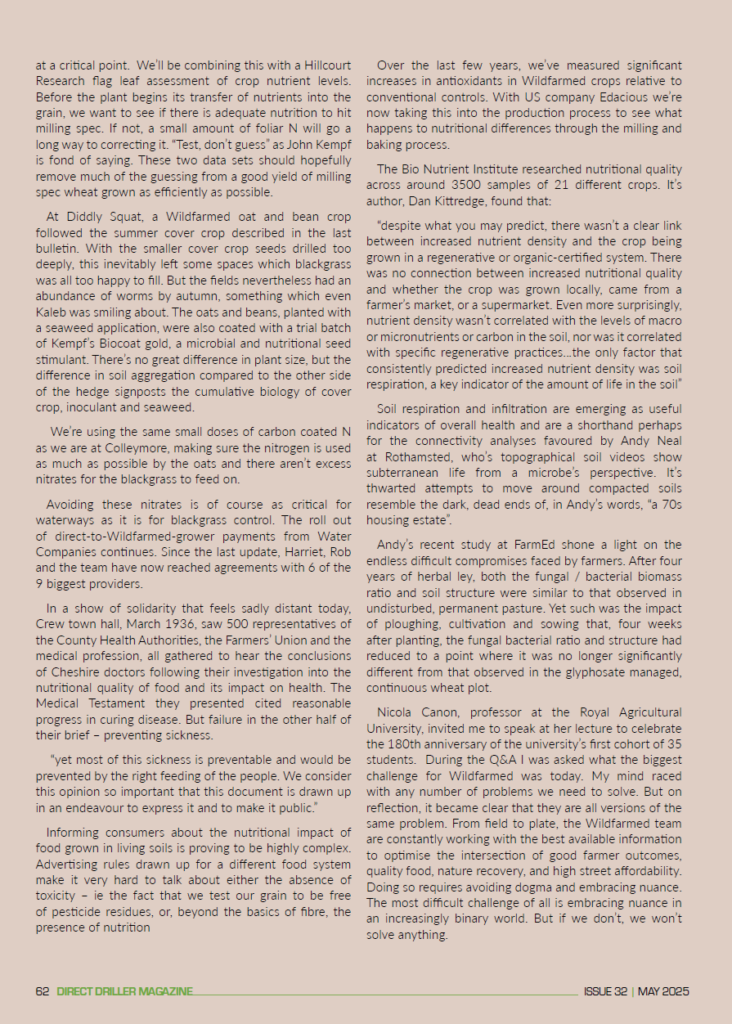
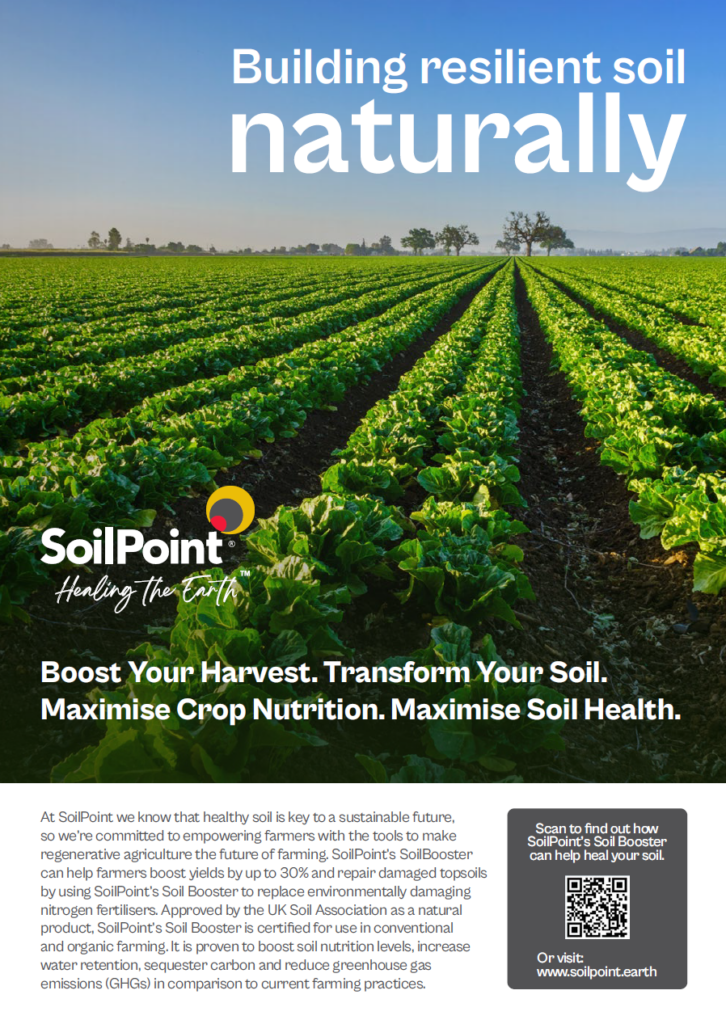
-

Regenerating the soils of tomorrow: SoilPoint’s answer to the UK’s Agricultural Crisis
As farmers worldwide face the dual challenges of maintaining productivity while transitioning to more sustainable practices, SoilPoint has emerged as a leading innovator in the field of soil health and regenerative agriculture, transforming agricultural practices across the UK and beyond, helping ensure a sustainable future for farming and food security.

Who is SoilPoint?
SoilPoint Humic Co. began in the USA and has expanded globally into UK and European markets. Led by CEO Alan Forrester, who is Chair of the UK Fresh Produce Consortium (FPC), the company brings together an experienced team of farmers, food industry executives, and soil technology experts. Together, they are tackling one of the most pressing challenges of our time: the rapid depletion of the world’s topsoil.
At the heart of SoilPoint’s innovation is their breakthrough Soil Booster – a natural soil conditioner proven to reduce dependence on chemical fertilisers. Certified by the UK Soil Association, Soil Booster contains key macro nutrients as well as 87 essential micronutrients extracted from lignite rock deposits. Using a proprietary process, it achieves 50%-70% pure humic granulates – far exceeding competitors’ 10%-20% concentrations.
Global trials
While conventional fertilisers have been relied upon to provide temporary yield increases, they’ve systematically degraded soil ecosystems worldwide, creating a dependency cycle that threatens long-term food security.
SoilPoint has cracked the industry’s traditional reliance on harsh chemical fertilisers, creating a solution that accelerates topsoil formation and generates up to 1cm every three years or faster, depending on conditions – ultimately proving that higher yields are attainable through sustainable practices that deliver both productive and profitable farming.

Global trials, including studies conducted in the UK, have demonstrated impressive results, boosting crop yields by up to 30%, improving soil water retention, enhancing carbon sequestration in soil and biomass and reducing greenhouse gas emissions in comparison to conventional farming practices.
In March 2025, SoilPoint partnered with Cefetra Ltd, a leading UK Grain business and agricultural supply chain specialist, to launch a pioneering soil health initiative in the UK. This initiative is built alongside 36 forward thinking farmers to replace a proportion of their synthetic fertiliser usage with SoilPoint’s Soil Booster, running for a full crop cycle measuring yields, crop quality, soil health, nutrient availability, and carbon emissions. This partnership marks the first phase of a long-term commercial relationship through which Cefetra will offer SoilPoint’s Soil Booster to UK farmers as part of its product portfolio.


Alan Forrester, CEO of SoilPoint, commented:
“Our data suggests that, if the UK continues to lose soil at current rates, it may face significant threats to future harvests. SoilPoint Soil Booster offers a natural and proven way to rejuvenate soils, supporting productivity and environmental improvements at the same time.
Visit www.soilpoint.earth today to discover the best solutions for your crops. SoilPoint’s Soil Booster is available as either a granule or a fine power, compatible with your existing nutrition and crop protection delivery methods.


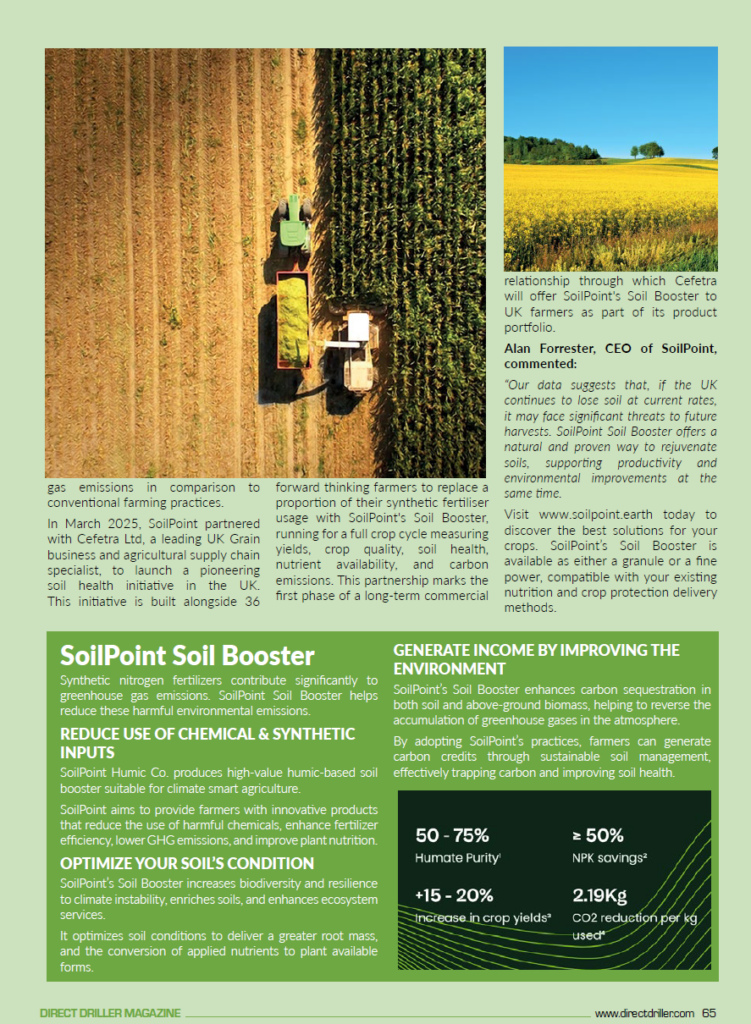

-
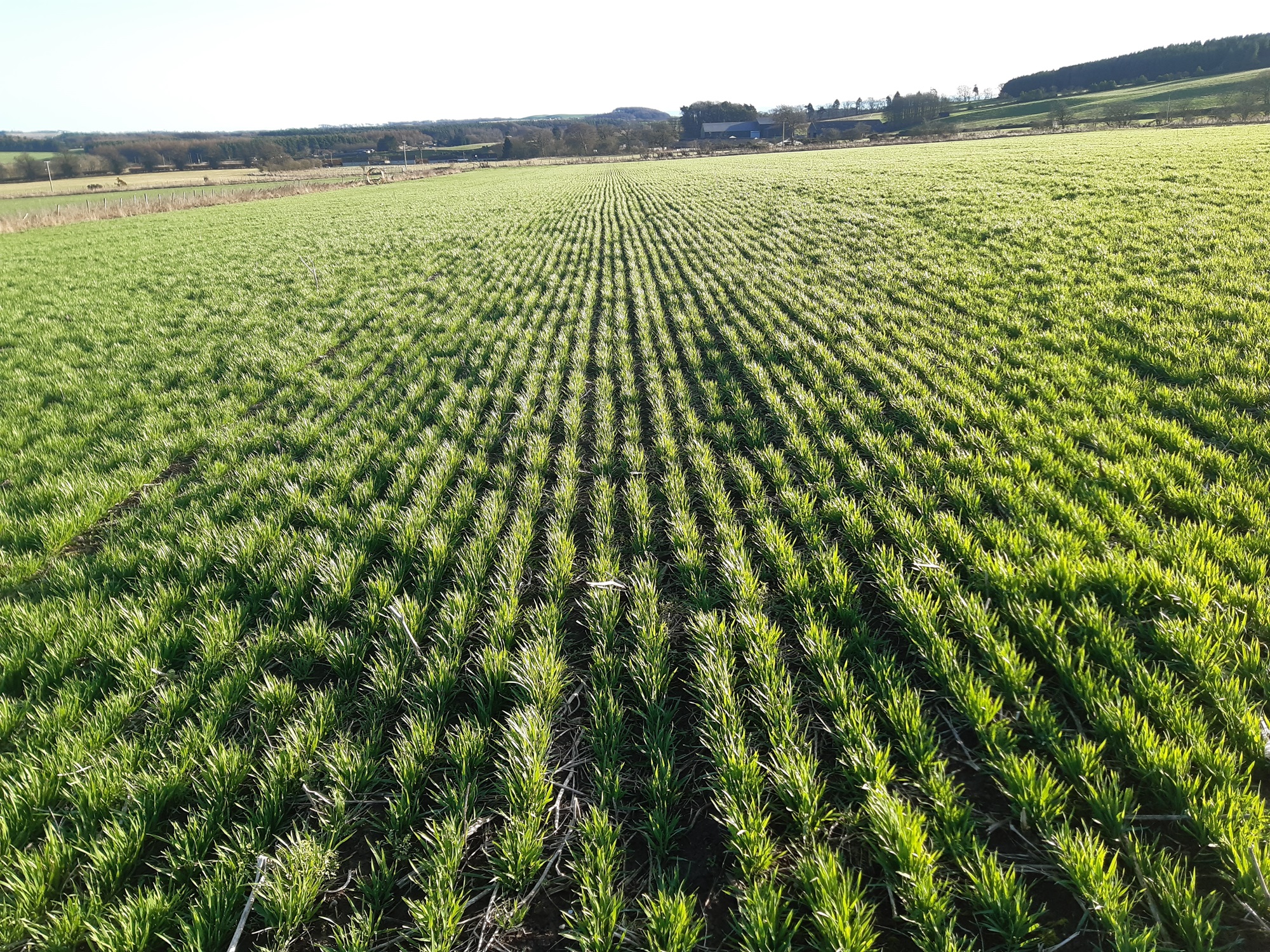
Farmer Focus – David Aglen
Mar 2025
Reflections on learnings and change.
We are moving on to pastures new, after nearly 15 years at Balbirnie Home Farms in Fife, I have taken up a post managing an arable farming business a bit further north that has yet to begin the adventure that is regen ag. This is a great time to look back on what we have achieved and most importantly learned, as we changed a business to rely less on synthetic inputs, and more on what nature would provide. Don’t misunderstand me here, we were still far from organic on the arable front, but had made big inroads to reducing fungicide usage. Herbicides, on the other hand are a bigger challenge, I struggled to reach the eutopia of a cover crop that could be successfully crimped down as the next crop was sown. I think the first crops to be grown like this commercially in the Scotland are likely to be some form of brassica vegetable. The technology exists, we just need the will to give it a go.
Direct drilling has been both challenging at times, and hugely rewarding at other times. There is no doubt that the financial savings are real. The soil and environment have benefited hugely as well. Seeing the drains running with clean water in the winter is very satisfying, especially so when the drains from a nearby cultivated field may be running with dirty water at the same time. What we now know is that no-till needs to be balanced with judicious use of appropriate of cultivation, and dare I say it, the plough.
Changes with the livestock side of the business have been equally dramatic. We have moved from a hugely intensive system, where cattle were housed for most of the winter to one where all stock classes are never housed. The cost savings have been staggering.
Cattle are now far more integrated into the arable side of the business, grazing cover crops as the opportunities arise, and even replacing a portion of combinable crops as an enterprise competing for land, where the margin per hectare is attractive, and that is before we even consider the fertility and soil health benefits.
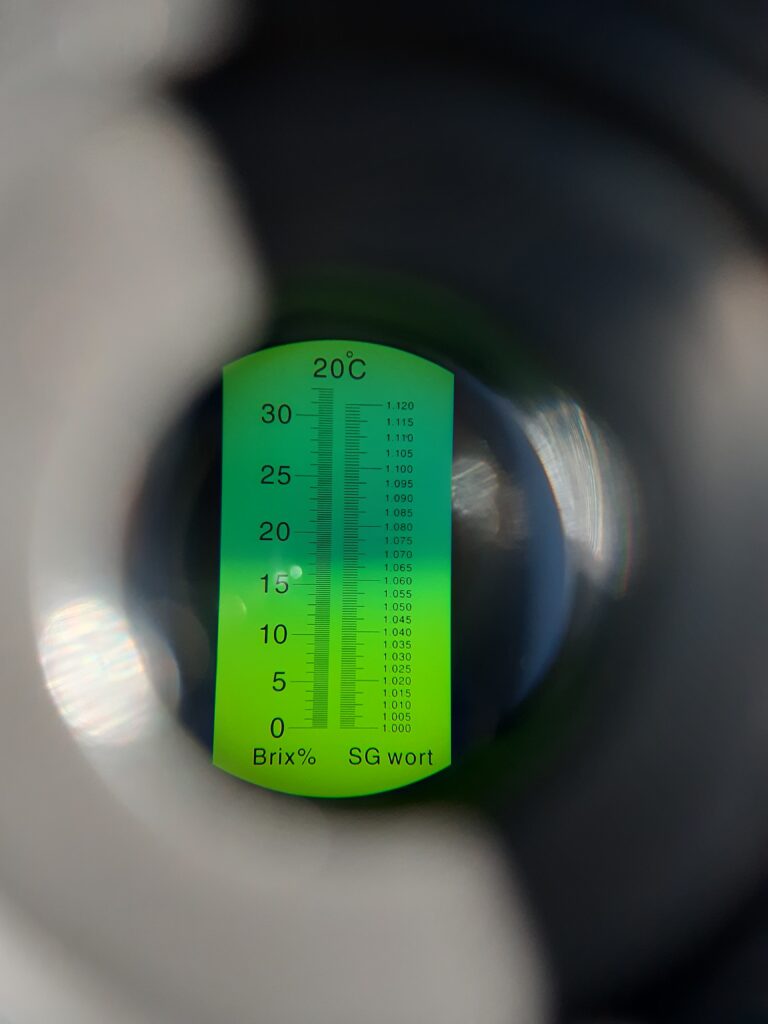
It has not all been plain sailing, reducing nitrogen inputs has been a greater challenge. I have concluded that, in the short term, this needs to be that last input that is reduced. We just need to find ways to minimize the waste that is inherent in the use of artificial N as well as growing and building more nitrogen building crops into our rotation. Perhaps these will take the form of summer cover crops cycled through livestock to generate an income, or more efficient ways to apply the artificial N that we do need to use.
Finding a good rotation has been challenging also. Vegetables and potatoes produce a good income stream and are good break crops, whether that be grown ourselves or renting out fields to others. The requirement for intensive cultivations is not so good though and seems to set the soil back a few years afterwards. The reality is that these crops are a food source and so need to be grown, the aim is to build the soil health back up again in the intervening years. This is where the judicious use of cultivation comes in to get the following crop established well to start the healing process, allowing the direct drilling to resume the second season after veg.
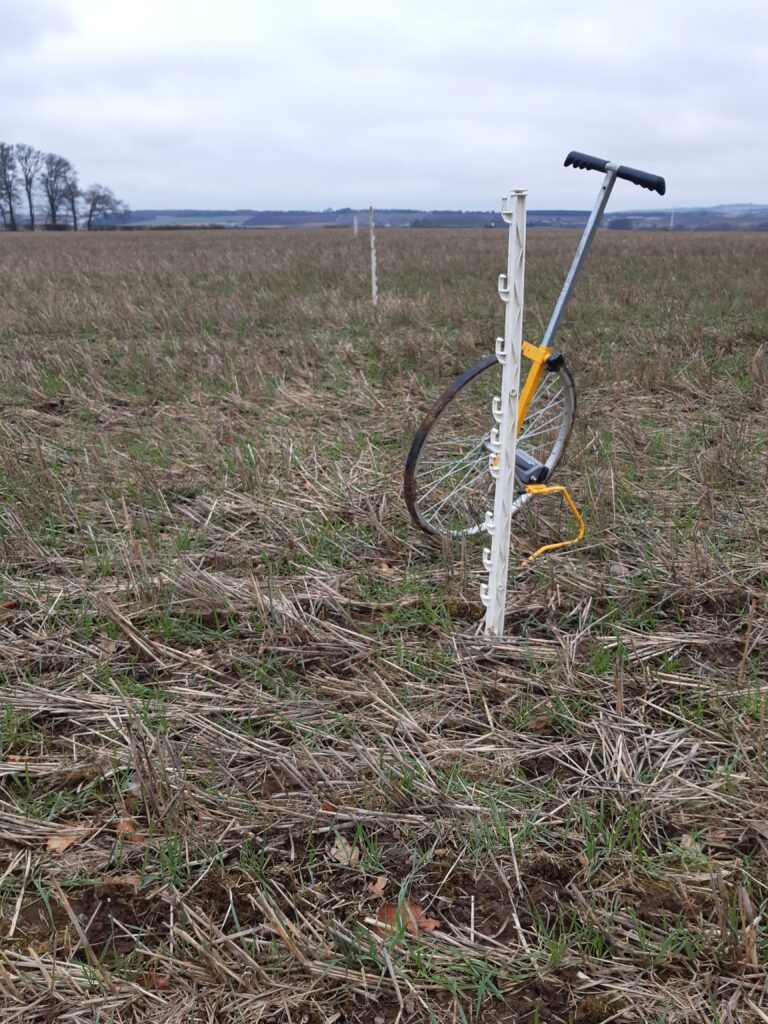
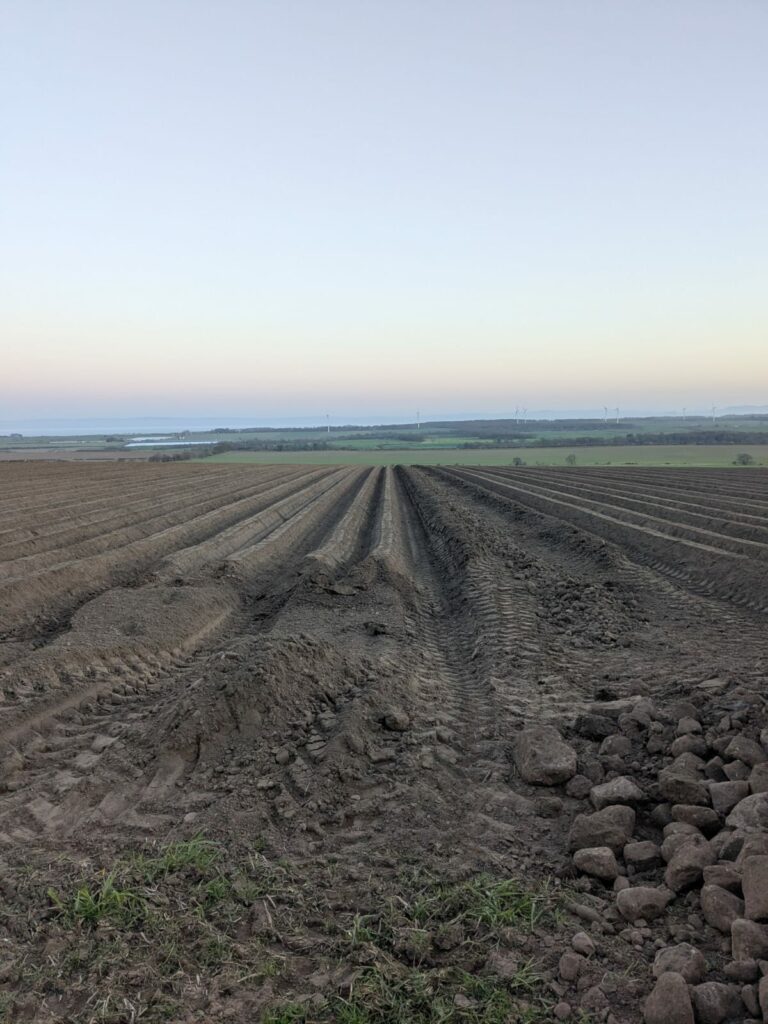
Of course, none of this would have been possible without the support of the Balfour family in allowing me to try things that were a bit different. And of course the team I leave behind, who have worked beside me, Colin Black and Grant Ross. Over the years they have had to endure endless experiments and mad ideas, as well as adding their own at times. Thank you all very much for the help and support over the years, and I wish you all the very best for the future.
And so now it is exciting to embark on a new challenge. Smaller in scale than I have been used to, and with no cows for the time being (looking forward to a few more weekends off though), but, size isn’t everything. I will be leaning on my peers in organisations such as BASE-UK to offer helpful suggestions as to how we proceed as the pressure both financially and environmentally is increased on our industry. I have no doubt that I will be hosting farm walks in the future, allowing me to pick peoples brains for new suggestions.
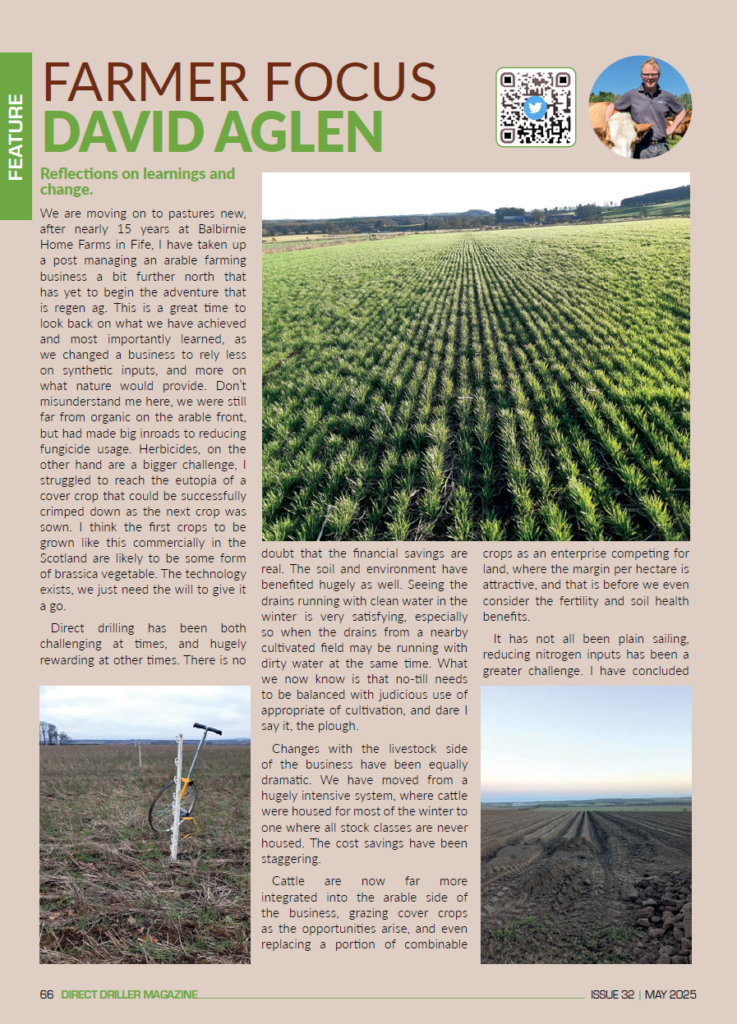

-
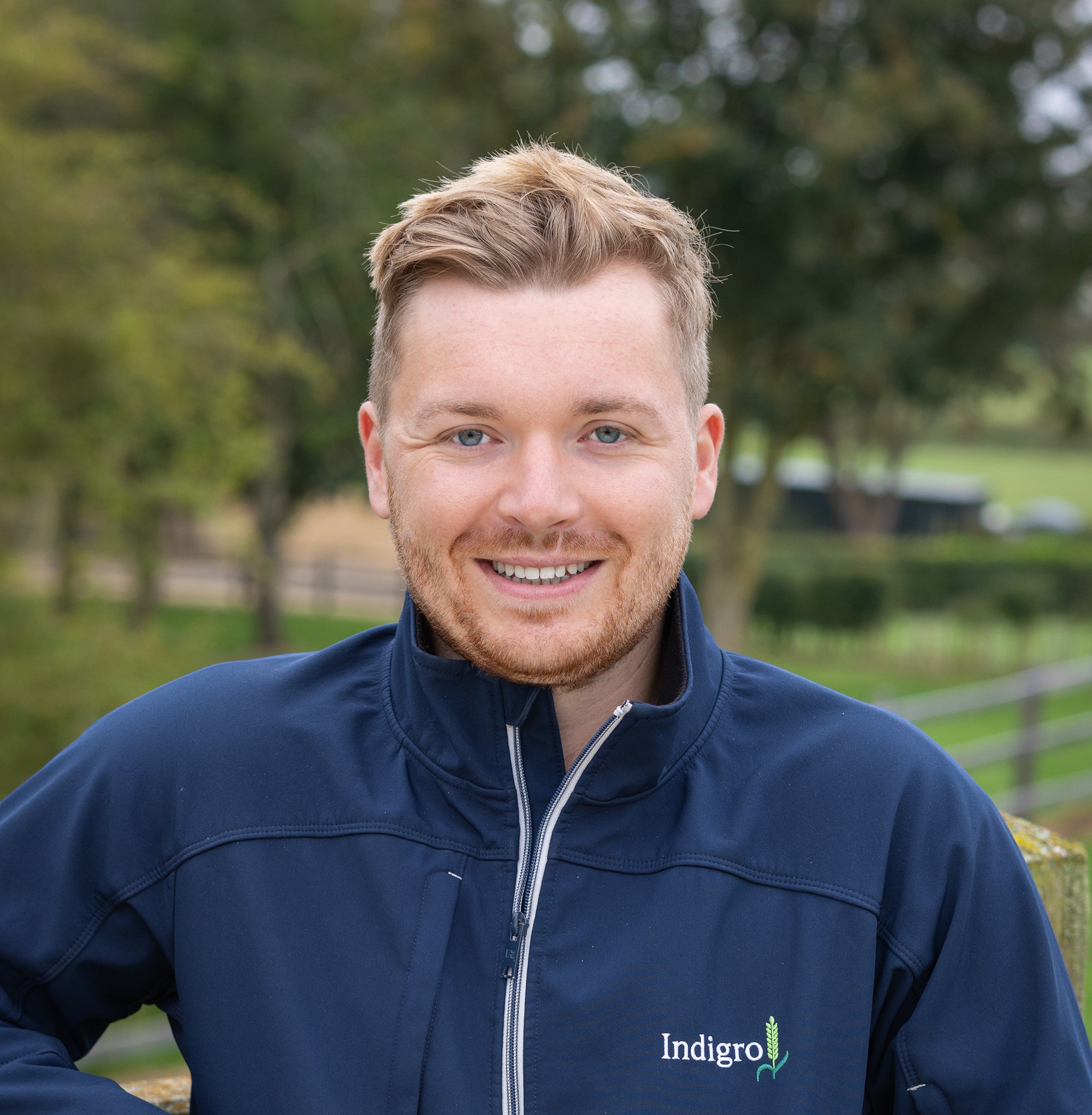
Agronomist in Focus – Harry Molton
“Roots, Rotation and Resilience: The first steps to a more productive and profitable future.
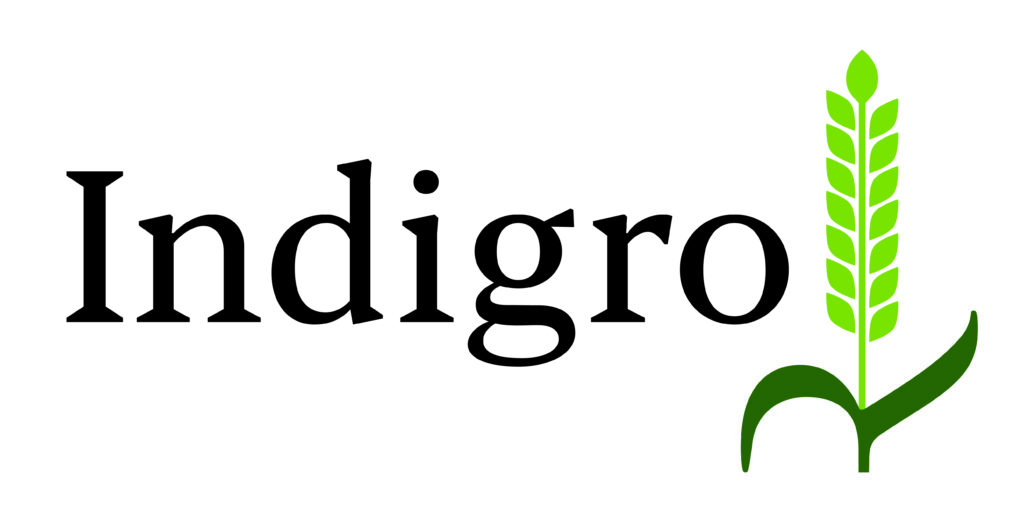
The need for a more resilient and productive farming system is clear, but moving forward requires a shift from short-term yields to long-term sustainability.
Transitioning to a regenerative or more sustainable system involves practices that rebuild soil health, enhance biodiversity, and improve climate resilience. Whether it’s cover cropping, rotational grazing, or reducing synthetic inputs, every step towards regeneration leads to a more productive and profitable future.
However, this transition requires careful planning and a willingness to embrace change. At Indigro, we’ve helped many clients on this journey. Here are the key steps to help you get started.
Understanding the Principles
Regenerative agriculture begins with minimising soil disturbance. On many soils, this takes time — few in the UK can switch from conventional tillage to direct drilling overnight. Building soil structure gradually is key to supporting no-till.
Our second regenerative principle is maintaining soil cover all year. Cover crops fill the gap between cash crops — such as between winter wheat and spring barley. Catch crops or summer covers can make use of long summer days to drive photosynthesis, increasing soil organic carbon.
We’ve also seen success establishing clover understories, which help maintain cover, suppress weeds, and improve diversity.

Clover Understory Maximising Diversity of both cash crops, and cover crops boosts biodiversity – another key facet of regenerative farming. While cover crop mixtures are easily tailored, consider adding a companion crop to increase the diversity within the cash crop. If flowering species are chosen, they can also provide a pollen source for invertebrates.
Diverse rooting systems play a vital role – taproots break compaction, fibrous roots condition soil. Maintaining living roots in the soilat all timesallows your soils to thrive. Fields or areas of fields left fallow can deteriorate, affecting soil health and subsequent crops.
Finally, where possible, integrate livestock into the farming system.
These principles form the foundation of regenerative farming. At Indigro, we see them as good farming practices — guidelines to support decision-making, not rigid rules. Especially in the early stages of moving towards a more sustainable system. It’s about making steady progress, not achieving perfection from day one.
Start with Assessment
When advising a transition to a regen system, we start with a thorough farm assessment.
Firstly, review drainage plans, check drain condition, fix issues, and mark outfalls. We carry out a Record of Condition (RoC) alongside Visual Soil Assessments (VSAs), looking at compaction layers and recording earthworm numbers.
Earthworms are the excavators, decomposers, and cultivators of our soils — a hidden workforce driving soil health. Their presence offers insight into soil condition, with studies showing they can contribute up to 25% of yield increases in sustainable systems.
In-depth soil analysis helps to identify problem areas and creates a baseline for progress. Understand your topography, erosion risk, rotation history, available equipment, and labour. The more you know at the start, the easier it is to measure improvement.
Use Cover Crops as a Starting Point
Cover crops are one of the simplest ways to begin. They improve soil biology, manage weeds, prevent leaching, and boost organic matter. The key is to define your objectives first; that will guide the right seed mix, tailored to your soil type and desired outcome. This may change from one year to the next.
Most farms already include spring crops, so an overwinter cover crop is a logical entry point. Choose a seed mix suited to your farm and objectives—legumes for nitrogen fixation, buckwheat for phosphate, deep-rooters for compaction etc.
Drill covers promptly after harvest, into moisture, and with care. Seed mixes contain different sizes that separate in transit or hoppers, so fill the drill little and often. Depth should suit the smallest seeds or use split hoppers to drill separately.
Covers should be managed like cash crops — timeliness, seedbed prep, and slug control matter.
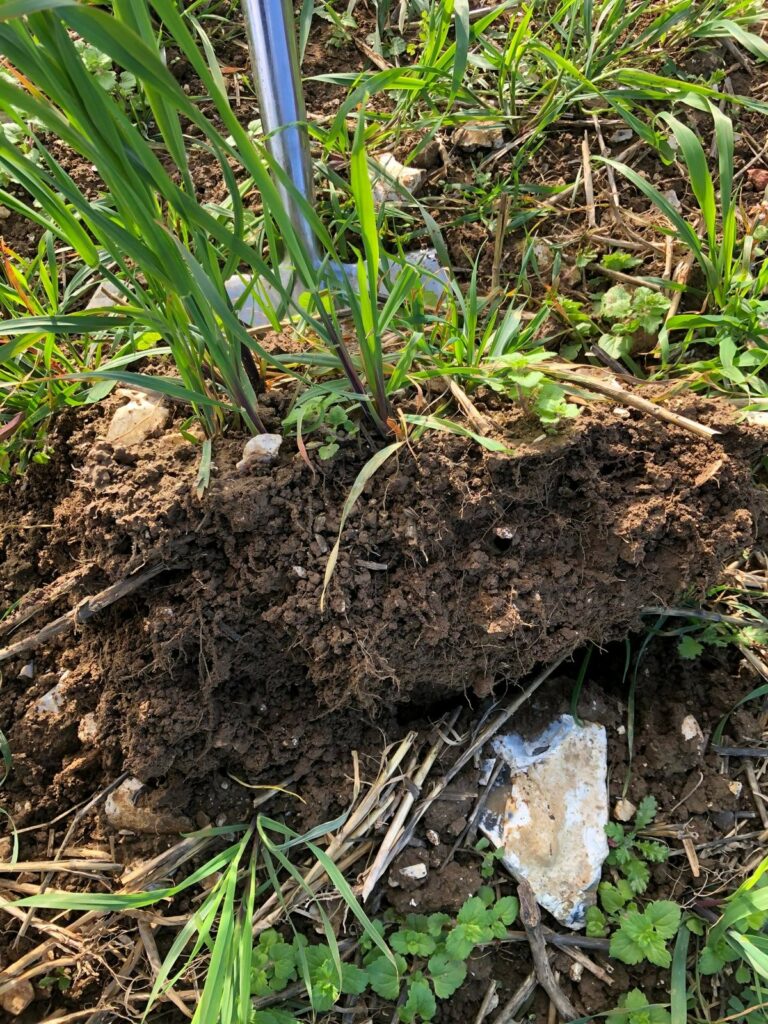
Winter Cover Crop Soil Structure Appropriate Tillage
When you first decide to begin your regenerative journey, it can be very tempting to acquire a shiny new direct drill. However, eliminating tillage overnight is often impractical and does not achieve the desired outcome.
We often talk about “earning the right” to no-till. This refers to ensuring your soil can support a no-till approach through good soil structure and drainage. Gradually reducing tillage over time will help you build the required structure and resilience in your soils to allow no-till.
Diversity in plants is key to a regen system, as is, diversity in tillage. This doesn’t mean changing tillage approach year-on-year, but addressing problems based on their needs.
If turning headlands are compacted, low disturbance sub-soiling will help alleviate this issue. If grassweeds are an issue, utilising stale seedbeds prior to drilling is wise. A light disc or straw rake may help. And in some cases, even ploughing may be the right tool for the job.
While ploughing isn’t associated with regenerative agriculture, it can have a place. Achieving the best crop establishment is key and we therefore must choose the most appropriate cultivation to achieve this. Risking having bare ground, is arguably more damaging to soil health than a well-considered appropriate cultivation.
Focus on outcomes rather than dogma. Strategic use of cultivation can help set a farm on the path to a more resilient, regenerative system. The key is to use these tools deliberately and sparingly, always with the end goal of long-term sustainability. Each farm’s soil type, cultivation history and cropping system will influence how long it takes to move to a no-till system.
Boost Farm Biodiversity
Monocultures have been shown to deplete soil health and increase pest and disease pressure, so increasing biodiversity is central to regenerative farming.
Introducing a variety of plant species supports microbiology and reduces reliance on chemical inputs. Bi-cropping, variety blends, catch and cover cropping are great tools.
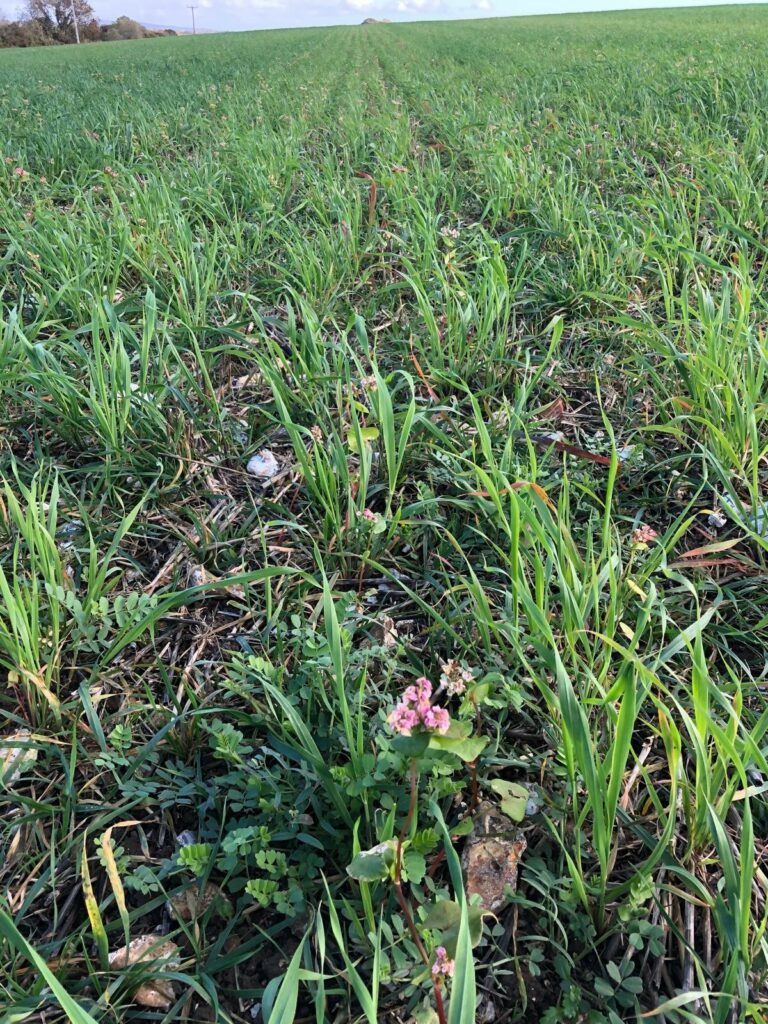
Winter Cover Crop In combinable crops, focus on diversifying rotations and integrating livestock.
Soil microbial activity can be enhanced by the integration of livestock. Rotational grazing of cover crops and or cereals accelerates soil health improvements and reduces reliance on inputs, as well as recycling nutrients. If direct integration isn’t feasible, partnering with a local livestock farmer might be an option.
Be Patient, Think Long-Term
Perhaps the most important principle to remember when transitioning your farm is that regenerative agriculture is not a one-size-fits-all approach. What one farm sees as regenerative, may look very different to another’s system — and that’s okay.Success lies in finding what works for your soils and your business.
One of the best things you can do is to assess your soils by eye — dig holes, get your hands dirty, and build a feel for what you’re seeing. That intuitive understanding becomes your personal benchmark, helping you track progress in a way that no report ever could.
Alongside that, monitor soil health indicators, crop performance, and input costs. Use tools like soil testing, infiltration tests, and aerial imagery to guide decisions.
Build flexibility into your strategy and be prepared to adapt. There’s a growing network of farmers across the country all on this journey — tap into it. Above all, be patient. Regenerative farming is a long-term shift. Challenges are inevitable, but improved soil health brings reduced inputs, greater resilience to weather extremes, and ultimately, more consistent yields — all contributing to a more sustainable future.

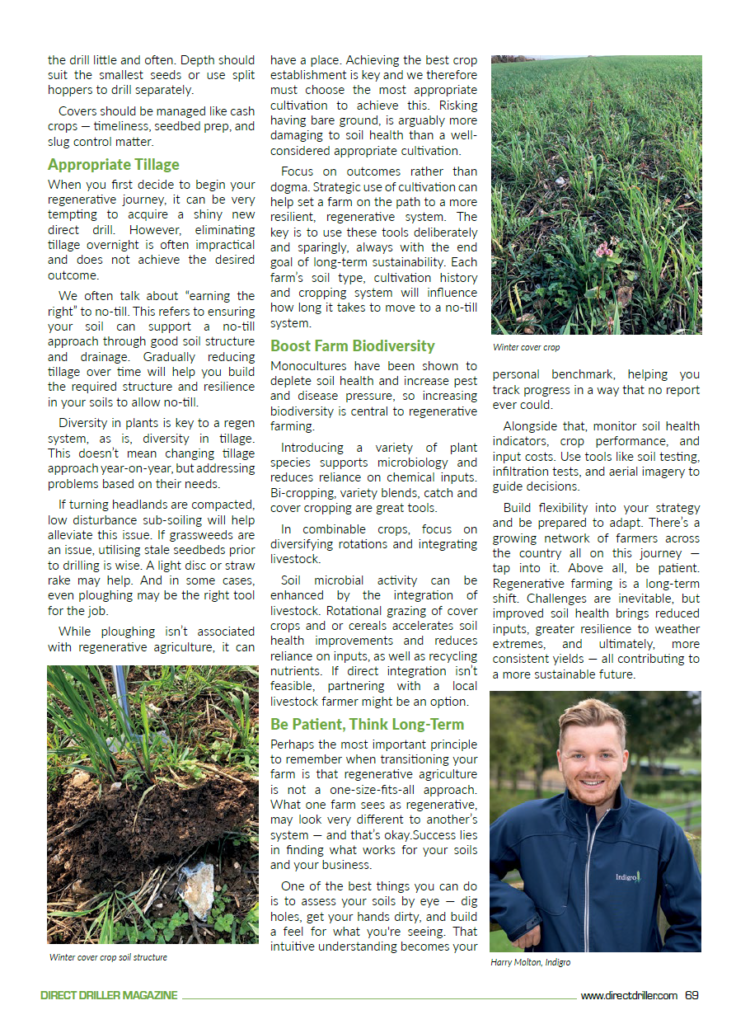
-
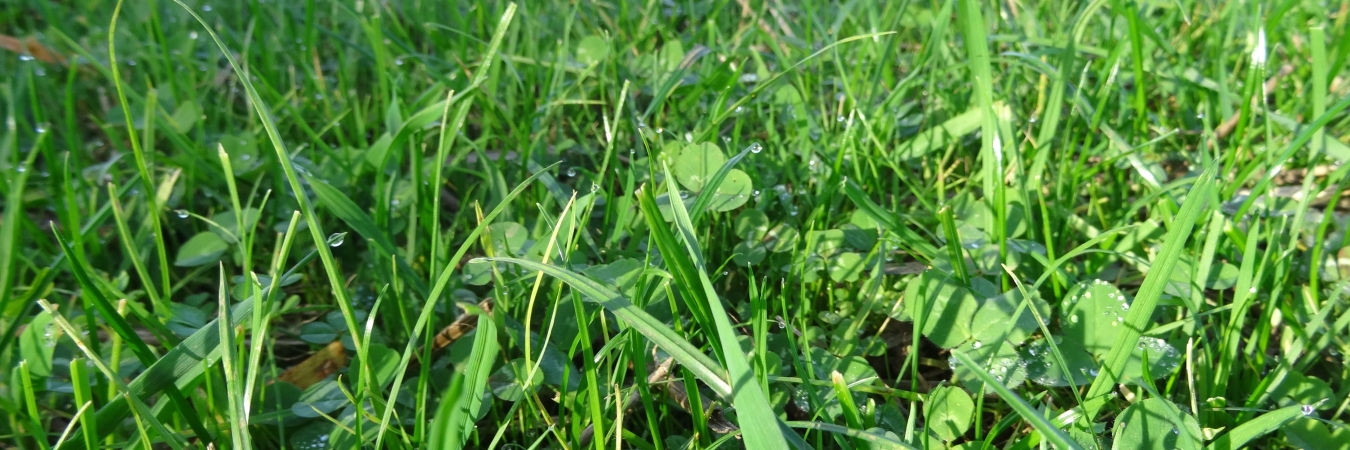
New living mulches guide to help boost soil health and farm resilience
Farmers looking to enhance soil health, increase resilience, and improve sustainability now have a powerful resource at their fingertips.
The newly released Agricology Living Mulches Technical Guide provides clear, practical advice on implementing living mulch strategies that deliver tangible benefits across farms of all sizes.
Living mulches are semi-permanent legume understories sown beneath cereal crops in the first year. By the second year, once the cover crop mulch is well established, new crops are direct drilled into it. This method integrates key regenerative agriculture practices, combining elements of intercropping, cover cropping, mulching, and undersowing to enhance soil health and improve biodiversity.
Co-created in response to farmers’ questions, the free-to-access guide builds on four years of research conducted through an Innovative Farmers Field Lab, further studies by the Organic Research Centre, and insights from UK farmers who have trialled living mulches. It is designed to offer clarity and step-by-step guidance on effectively adopting this innovative practice.
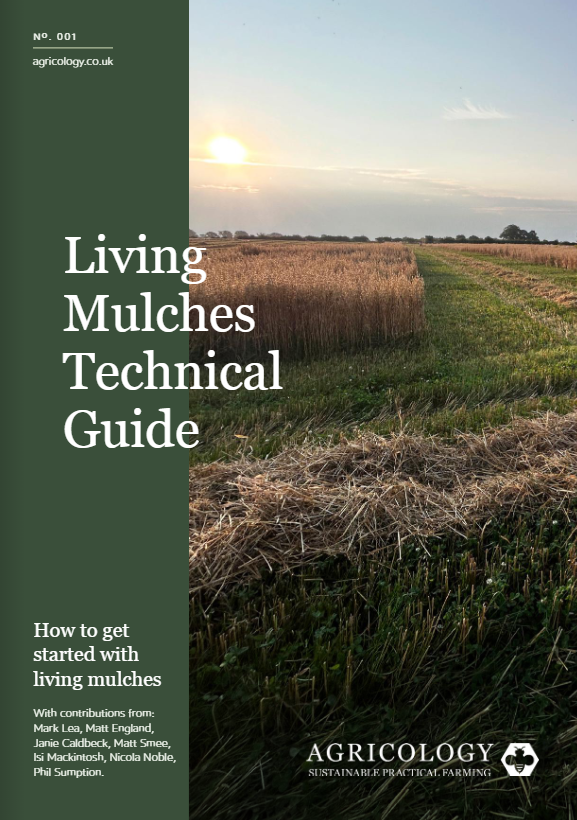
When managed effectively, living mulches can improve soil structure and fertility, reduce runoff and erosion, and enhance nitrogen availability for future crops. They can also boost in-field biodiversity, suppress annual weed populations, and lower production costs. However, without proper management, living mulches can also present challenges, including competition with crops, potential yield penalties, and increased perennial weed burdens.
Structured around the farming year, the guide focuses on the living mulch journey season by season – from spring establishment and summer field management, to harvest and autumn transition into a fully living mulch system and concluding with winter mulch management. Each seasonal chapter clearly outlines the actions required, important considerations and potential risks, providing a practical, time-based roadmap to help farmers plan, adapt and trial the system at their own pace.
It concludes with a detailed diary of Matt England’s observations and reflections from trialling living mulches on the Fring Estate in Norfolk over the course of three years.

While there are multiple ways to integrate living mulches, this guide focuses on a low-input system with alternative strategies and additional insights provided for those working within conventional farming systems.
Matt Smee, Head of Agricology at the Organic Research Centre, says that living mulches are a great tool for farmers seeking sustainable and efficient farming practices.
“Every farm is unique, every season brings new challenges, and no two years are the same. With this in mind, the guide provides a framework that allows farmers to tailor living mulch practices to suit their specific needs,” he says.
Along with the guide, an online learning journey exploring different approaches to getting started with living mulches has been created that you can find on the website in the form of the ‘Living Mulch Hub.’ It brings together a wide mix of resources; research papers, videos, tools, blogs and case studies, sourced from the Agricology archive and beyond.
To access the free online learning journey and the full Living Mulches Technical Guide, visit www.agricology.co.uk/resource/living-mulches-technical-guide/

Agricology (www.agricology.co.uk) is an independent knowledge platform that supports all farmers and growers in transitioning to more sustainable and resilient farming systems. It is a free platform open to everyone and was established in response to the increasing challenges of declining soil fertility, climate change, biodiversity loss, and the need to rethink the way land is managed. It brings together research from the field and farmer experiences on using practices that restore the farm ecosystem. These include reducing tillage to improve soil quality, planting cover crops, adding pollinator strips, using trap crops (which divert pests from crops instead of using chemicals), and using agroforestry systems.
Agricology was founded in 2015, is a collaboration between over 40 organisations, and is managed and delivered by the Organic Research Centre.
For more information contact Matt Smee on matt.s@organicresearchcentre.com
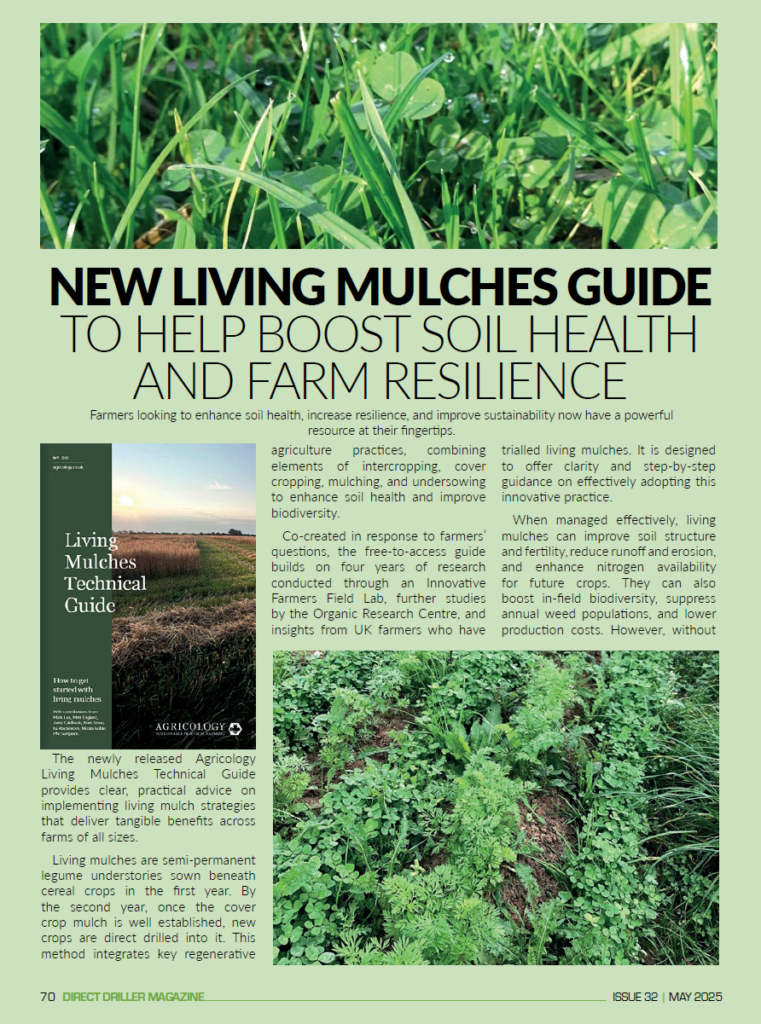

-
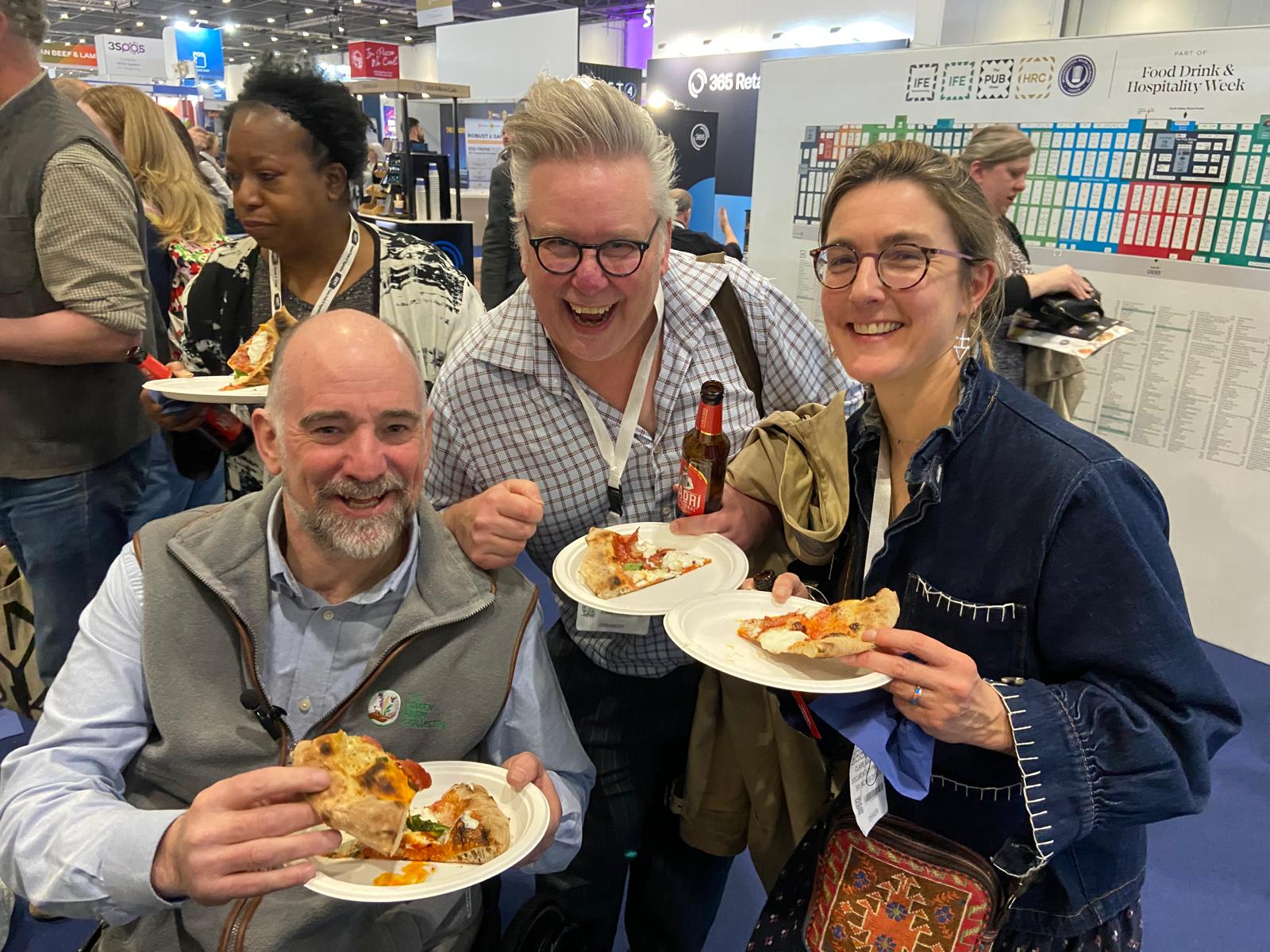
Farmer Focus – Tim Parton
At the time of writing things are getting dry! Are we in for another dry spring? The last time the moon was in the present orbit was the 1700s and they had the same weather as we are experiencing now (so I read as I am not that old), going from floods to drought. They got through it then so I am sure we will cope! The importance for having healthy soil has never been more significant in my opinion, in order to cope with the extremes we are experiencing.
Fortunately, I am mobile again and have been out giving a lot of talks and on-farm consultancy: so nice to see different people’s approaches around the country, but all aiming to improve their soil while making a profit.
As Green Farm Collective, we launched our flour brand through Eurostar commodities called “Rise”, down at the International Food and Drink show, at the excel building in London. Attention around our certified Regen flour was fantastic! I was asked to speak on a Regen panel while attending with Claire Mackenzie (Six Inches of Soil), Andy Neil (Rothamsted research), Dave Smith (Fielden’s whiskey) and Henry Astor (Bruern Farm). Henry supplies Fielden whiskey with rye and wheat farmed with no cides.
We had great fun on the panel with lots of interest from the audience about regenerative produce. Whenever I give a talk to consumers, I always get the question, where can I buy this food? I have never really been able to give an answer but now finally I can say, here! This is just the start in my opinion; the right education needs to be given, and full transparency needs to occur. Consumers should have the right to see the full journey of their food and have the right to be part of the story helping to heal the planet in which we live. Change in my opinion always comes from the people; as together we do have power. Just the same, it’s always been one of my aims to unite farmers across the world as together we have power but as individuals, we have very little.
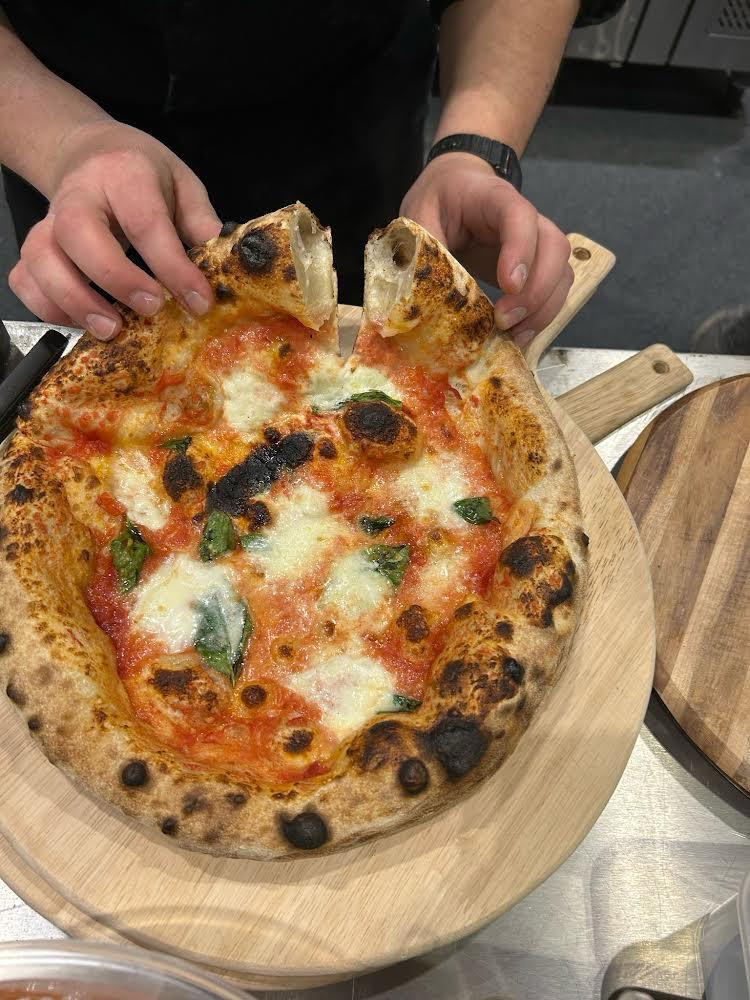

Tasting the pizza made from our flour was a true delight and one of the best pizzas I have ever had, which was probably helped along by the fact that the much-acclaimed Italian pizza chef, Marco Greco, making the Pizza. He made it look so easy, flipping the dough above his head etc, but of course it was all down to such a fine dough as you can see from the picture of my loaf of bread pictured. This is giving our growers a good premium of delivered bread wheat. We are still delivering carbon deals while still pursuing more avenues for our wheat.
Crops have come out of the winter well with roots getting down to good depths and biologically active. At the time of writing wheats had only received 20kg/ha of ammonium sulphate plus foliar applications of foliar nutrition in order to get them ready for an active immune system for the coming growing season. You can see from the picture attached they certainly are not hungry for N. It often horrifies me to see how much N has gone onto crops so early when the crop is not growing and a lot of that N could get converted into nitrate which is going to cause a lot of weak cell growth, which in turn, will lead to use of fungicides and pest attack. Supplying the plant with the right nutrition is crucial to allow photosynthesis and for plants to be putting out the right exudates to feed biology and endophytes within the plant.
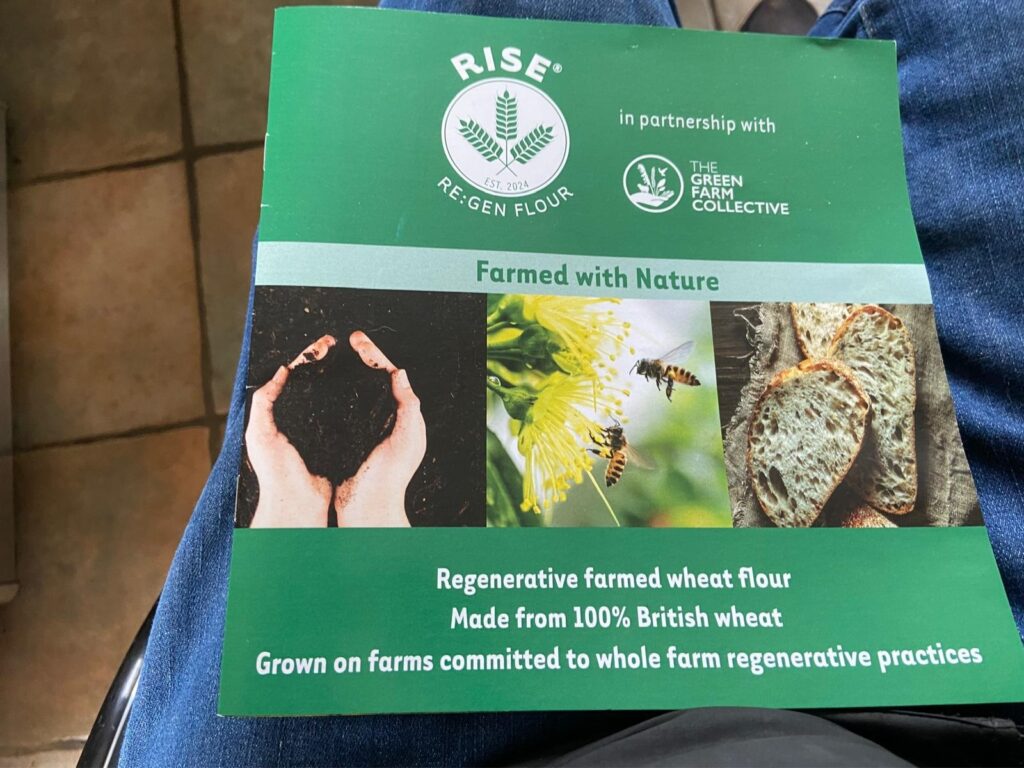
I feel that biology invented plants in order to get fed and we can see from the planet’s evolution that fungi and bacteria did create the very planet in which we live, finding a superb way to store carbon within soil and marine undersea Algae, plants and coral, with 93% of carbon stored within our oceans making it the largest store on the planet. It didn’t take human beings long to mess everything up did it? With the human body containing 30 trillion human cells and about 38 trillion bacteria, so are we in control ? When you look at the difference having the right biology within our gut in coalition with health, the similarities between and our gut and soil health is so very similar in my opinion and obtaining the right mix for optimum health and production is paramount. I like the work of Dr Mary Lucero who has shown the benefits of using endophytes from plants that have the desired outcomes for the right environment, protection and yield. The possibilities of using endophytes are endless in my opinion and one that should be explored far more, which are far safer and more natural than the damage that gene editing or GMO’s can do to our health or the environment.
Biology has all the answers and mother nature will always win in my experience, but the sooner we start to work with Her, the better, rather than thinking we know better! All problems can be overcome with biology and nutrition. The problem is, there is not enough money in it to attract big business to develop it further and so we continue down the path of synthetic inputs and DNA manipulation, which to me is always to the detriment to the grower/farmer from a financial point of view… or am I just a cynic?
Seeing how work with fungi and the benefits biology can bring dates back into the 1800s I feel that biology has been ignored for far too long and that change is going to have to come from us, as growers, to get the shift that is required to make change. Change never comes from government or authorities in my experience, it always comes from the people or corporations that require change for financial gain. We have the power to create change, but we need to come together as one voice, in order to have the power.
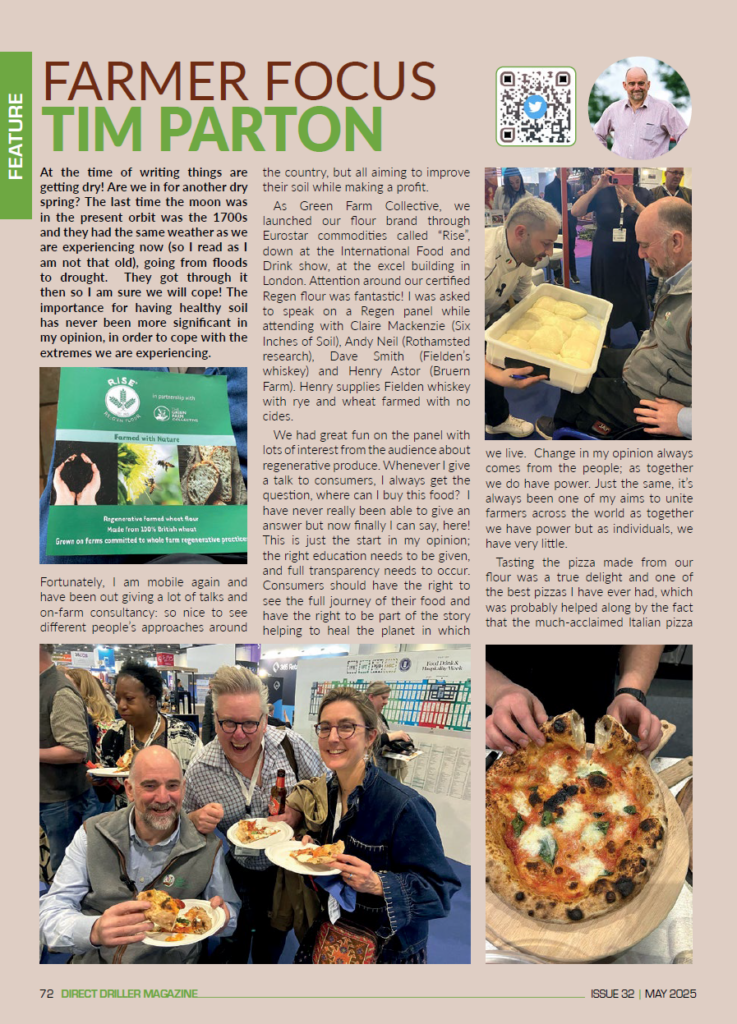

-
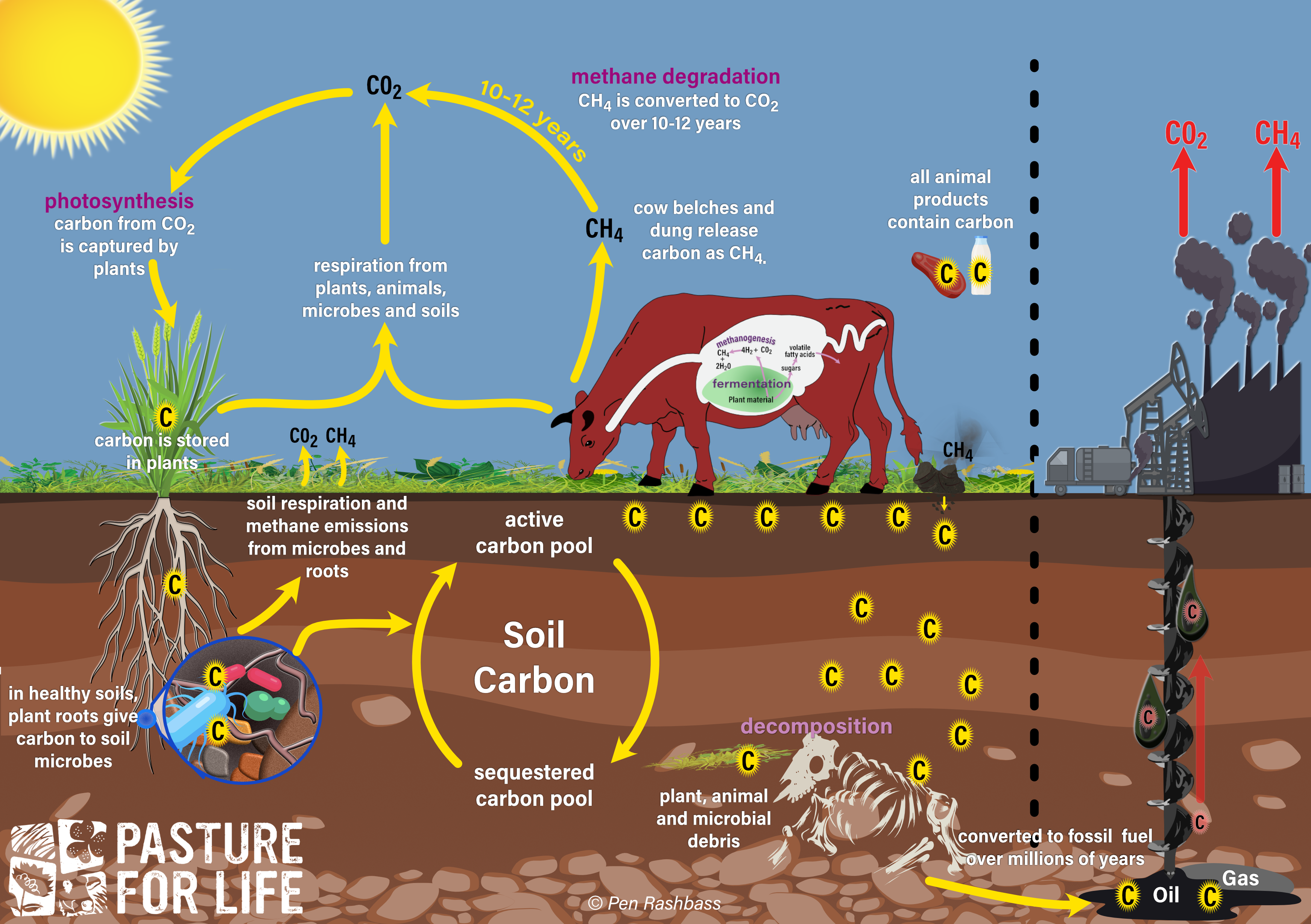
Pasture for life growing on many fronts
Pasture for Life, which champions the restorative power of grazing animals, continues to go from strength to strength with ambitious targets of hitting 5,000 members farming one million hectares by 2029.
Last year saw 208 events delivered and 93 farmers trained as grazing mentors helping 166 mentees. There was activity across England, Scotland and Wales, including research collaboration and partnerships, as well as successful supply chain initiatives.
Former director Sara Gregson talks to two Pasture for Life certified producers and reviews a couple of recent research projects…
Pasture for Life farmers
Sonja and Perin Dineley
Dorset
Sonja and Perin Dineley regard themselves as biological farmers, creating healthy living networks in the soil and above ground, whilst producing good food for people to eat.
They run 3,000 New Zealand Romney ewes across 750 hectares on three farms close to Shaftesbury. There is a wide range of soils including chalk, greensand and clay and the farms are at different stages of regeneration.
“Agriculture is not easy at the moment, with the reduction in payments and loss of faith from consumers,” says Perin. “But if we can demonstrate that production agriculture can be integrated with caring for nature, there is plenty of scope for us to succeed and be at the forefront of the future direction for farming.”
The ewes are run in three flocks and lambing starts no later than 10 April to make use of the high quality spring grass.
The lambs are weaned at ten to 11 weeks of age and divided into replacements and breeding stock or killing lambs. They are grouped according to weight and put into the most appropriate fields, including herbal leys.

“We have been rotational grazing lambs for several years, achieving growth rates of 400g/day or more,” Perin explains. “They are moved every three to four days on multi-species swards containing a lot of clover, plantain and chicory. Depending on feed availability, a combination of fat lambs are sold through ABP and some store lambs are sold privately.”
No meat is currently sold from the farm, but the Dineleys have recently become Pasture for Life certified in anticipation of doing so in future.
“We have been raising animals on just forage for 30 years or more,” says Sonja. “We need to find a way of getting this nature value through to consumers. Pasture for Life has a lot of direct selling members, and I am sure we can learn a lot from them.”
A small herd of Belted Galloway cross Shorthorn suckler cows has been introduced and their grazing has made a huge difference to biodiversity, with fabulous shows of wildflowers each summer, including fields with hundreds of Bee Orchids.
“We see our work as restoring damaged ground, which is better than merely sustaining it – who wants to sustain really depleted soils?’ asks Sonja. “Forage diversity with different root formations and root depth is critical to rebuilding soil health and that is what we are aiming for.”
James Newhouse
North Yorkshire
New entrant farmer James Newhouse started farming from scratch when Covid-19 brought him the option of redundancy from Rolls Royce. He bought 54 hectares of hill land on the south western edge of the Yorkshire Dales, near Skipton.
For the first two years he had just six Aberdeen Angus stores and 30 Swaledale ewes. Perplexed at the low and variable price he was getting for his lambs, James wondered how he would ever make any money. It was then that he turned to others for help and guidance.
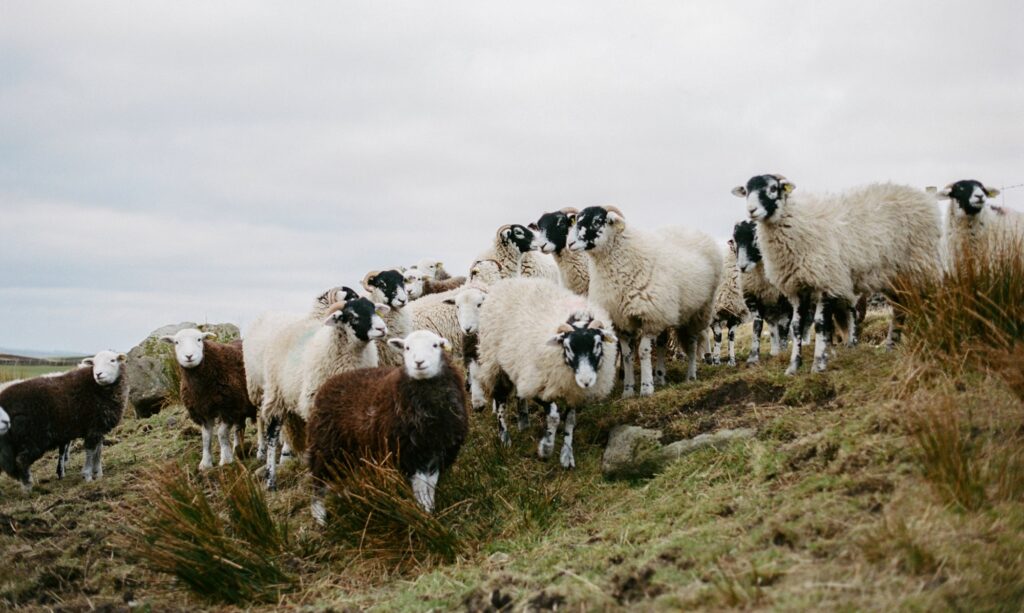
One of these was local farmer Neil Heseltine from Malham. Neil was an early member of Pasture for Life.
“Neil introduced Belted Galloways to his farm in 2003 and has significantly reduced his sheep to nearly zero,” says James. “His cattle spend all winter outdoors, are good mothers, calve easily on their own and gain condition off low quality grass.
“In January 2023, Neil sold me two in-calf cows with calves at foot and the cows calved, unaided in June. My suckler herd now has 10 cows with their calves and they are thriving.”
By 2023, now a member of Pasture for Life, James was put forward for a mentoring project – funded by the Government’s Farming in Protected Landscapes (FiPL) programme. His first mentor was Jim Beary of upland hill farm Gaythorne Hall in Cumbria. Jim directed James’ focus towards his soils.
They discussed how he could split up the four large fields into much smaller paddocks, so the animals can be grazed rotationally and the fields left to have long rest periods, which is good for soil health and regeneration.
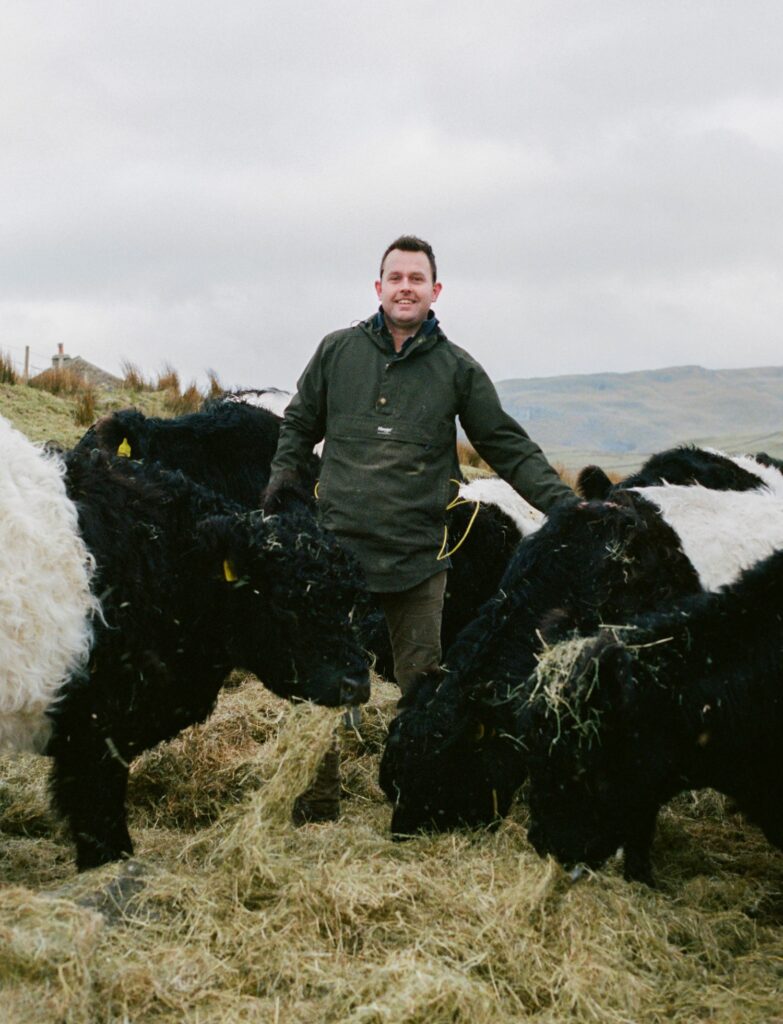
A second year of being mentored by Sam and Claire Beaumont farming near Ullswater in the Lake District, shone a light on improving animal health and welfare. They also encouraged James to get the herd Pasture for Life certified, as they felt sure that direct selling would be the way forward.
“Recently I have been looking more at how I can market our very special products,” says James.
“I cannot supply meat that looks exactly the same consistently week in, week out. But I can supply incredibly special and tasty meat when it is ready.
“And by selling as certified Pasture for Life, in boxes to locals and direct to restaurants – we are missing out the middle man and keeping more of the profit. I am selling 16 boxes per beast at £160 a box and making at least £1,000 profit per beast.”
Research update
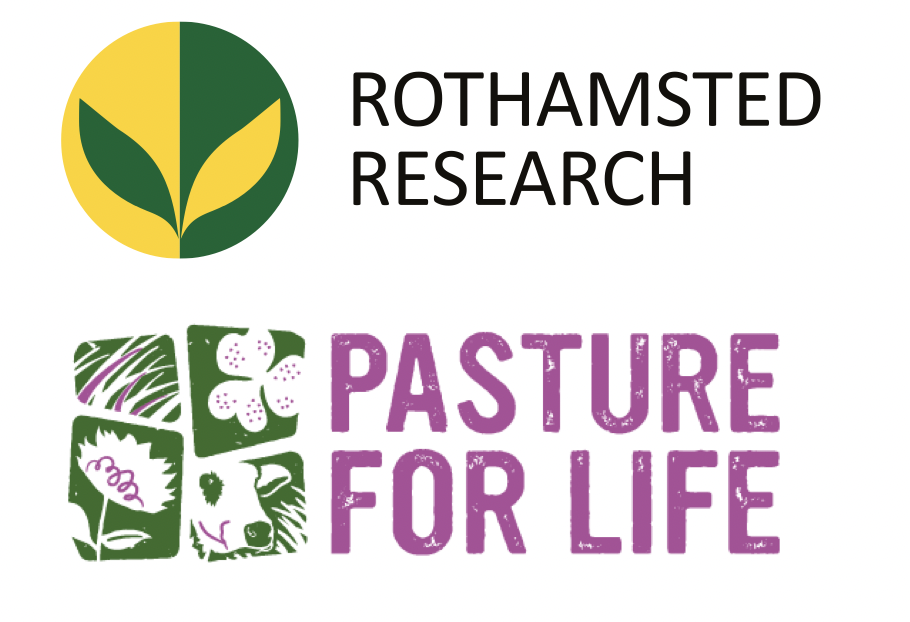
Getting farmers more involved with future research
Supported by funding from the UKRI-BBSRC, Rothamsted Research (RR) and Pasture for Life have joined forces to reflect on the current state and potential of pasture-based livestock research.
They believe that moving the science and the public debate forward requires an agricultural research environment which prioritises farmer-scientist collaborative research at the farm-level.
Between May and October 2024, a series of round tables involving a scientific advisory group from Rothamsted Research and Pasture for Life’s research group, followed by an open invite scientist-farmer workshop event, identified shared priorities to encourage more research funding that supports collaborative farmer-scientist research.
The shared vision was for Responsive, Dynamic and Impactful collaborative research.
Recommended changes
Relationship-based research funding
Most current funding models work on an episodic, project-based basis, which limits the opportunity for building long-term trust between scientists and farmers. Introducing a relationship-based funding strand would allow ongoing, mutually beneficial collaborations, fostering stronger partnerships and more effective, timely research.
Equal status as research partners
The current UK funding model does not facilitate the rewarding of farmers as equal partners in the research process. Funding models need to recognise farmers as full partners in research, allowing them to be listed as co-researchers and compensated fairly for their expert contributions.
Deploy a co-design approach
To ensure relevance and effective application of research, collaboration needs to move from its current focus on data collection to a co-design approach, where collaboration applies to the whole research process, starting with identification of the research problem and design of the study.
Read more here: https://bit.ly/43xdfQd
Carbon – a complicated story

Nikki Yoxall Nikki Yoxall has held the roles of Research Group Coordinator and Head of Research at Pasture for Life, but in 2024 became Technical Director, overseeing Knowledge Generation (research and evidence building) and Knowledge Exchange activity.
Here she outlines the organisation’s thoughts on carbon in Pasture for Life Farming Systems
We know that the interactions between soils, vegetation and grazing animals are currently not captured within Life Cycle Assessments (LCAs). However, soil has now been recognised by the Intergovernmental Panel on Climate Change (IPCC), as one of the potentially biggest sinks for atmospheric carbon dioxide. Therefore, with the correct carrying capacity and grazing management, pasture-based livestock systems not only lead to biodiversity rich grasslands and higher productivity, but are also able to store carbon, through their root systems, leading to net zero emissions from the farm, or potentially even acting as sinks.
In addition Pasture for Life farms:
- Use appropriate livestock carrying capacities, where the farmland is able to provide forage self-sufficiency, avoiding the need to buy in feed
- Are naturally more resilient, with lower inputs of fuel, bought-in forage and fertiliser, with the associated reductions in associated emissions
- Provide permanent grasslands and biodiverse habitats to maximise carbon sequestration
- Often have multi-species swards (MSS) and browsing available to livestock that we know contains species that can actively reduce methane emissions eg sainfoin, willow, plantain and bird’s foot trefoil.
What we sadly do not have is enough research focused on ruminants naturally grazing, their direct methane emissions, the ability for grasslands to sequester or the interactions they may play in the short carbon cycle.
Whilst many Pasture for Life farms will feel confident that they are working towards a resilient, farming system that actively supports the health of the water cycle, mineral cycle and carbon cycle, we are all of course part of a much wider global society where expectations are placed on land managers to deliver multiple outcomes, as well as food, for the benefit of society – one of which is the storage of carbon.
Carbon emissions are of course only one element of a complex narrative. We have not spoken about the impact of nitrous oxide or the many other factors of sustainability beyond emissions, eg the need to redefine efficiency beyond productivity, biodiversity, the rural economy, economics, food security and food waste.
We now know that a myopic view leads to unintended trade-offs, but it is also important to consider the inevitable trade-offs we may need to actively accept.
Achieving net zero targets will undoubtedly lead to consequences (good and bad) for society, food security and the economy. So our role as pasture fed farmers is to showcase that well-managed grazing animals at grass, power the regeneration of landscapes, economies, food cultures and communities and therefore play a vital role in rural Britain.
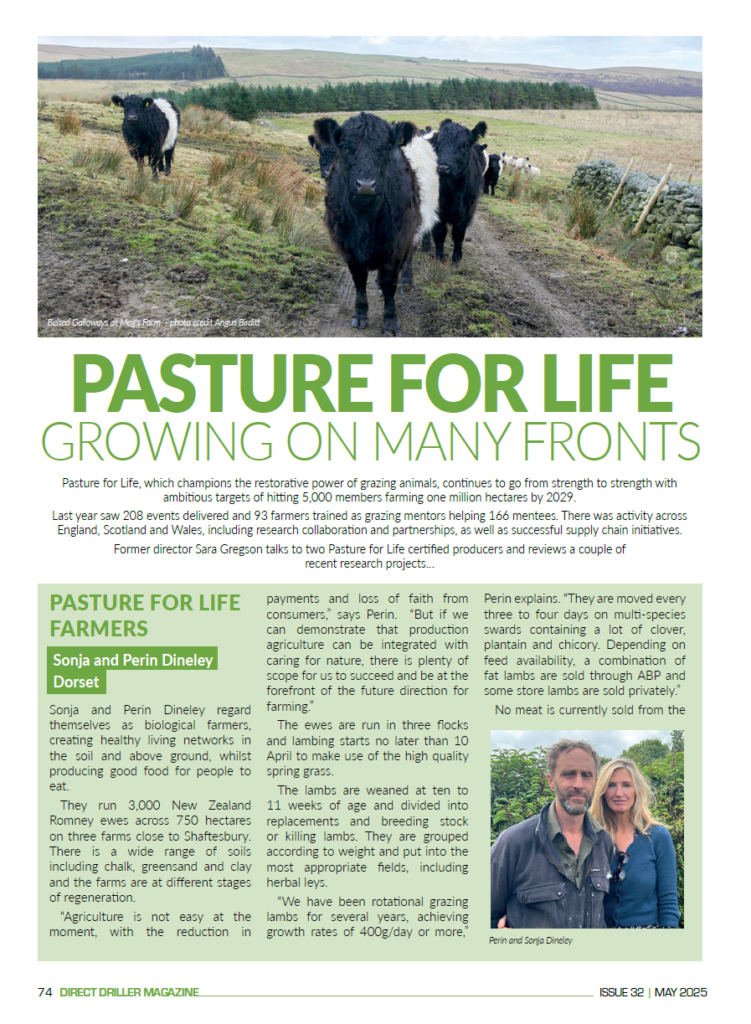
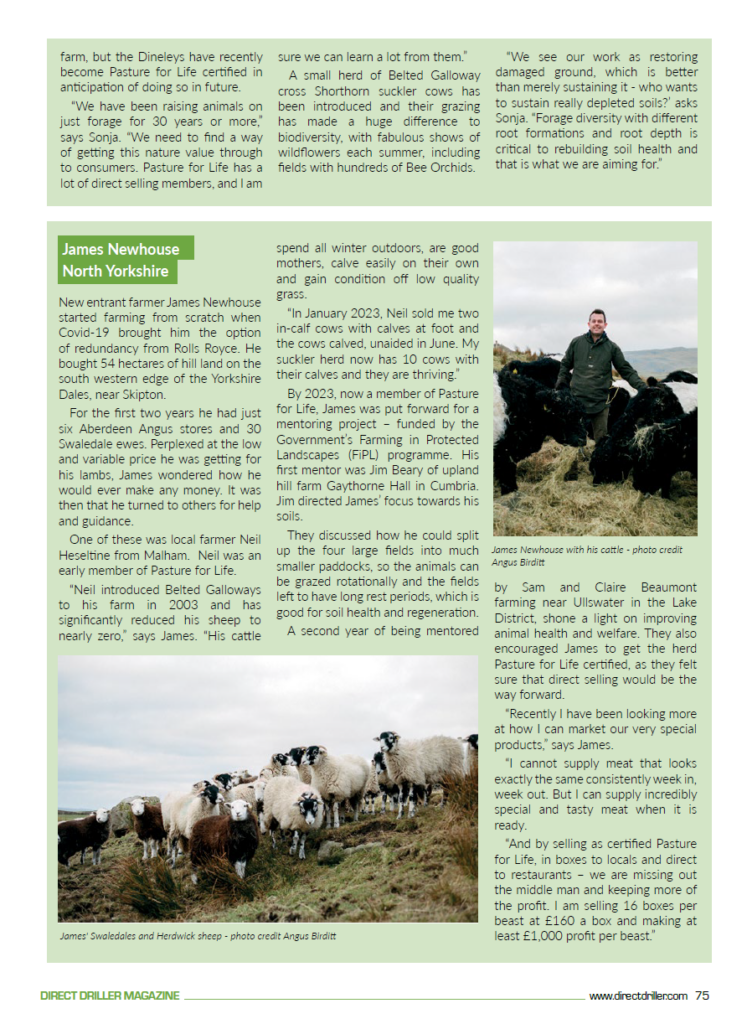
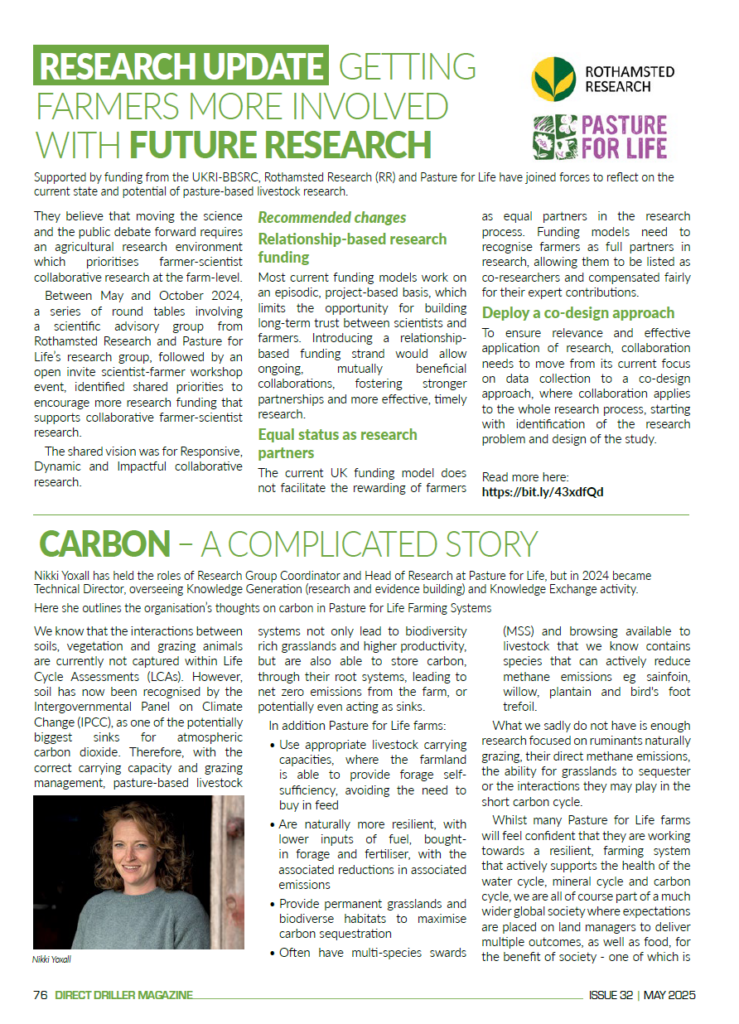
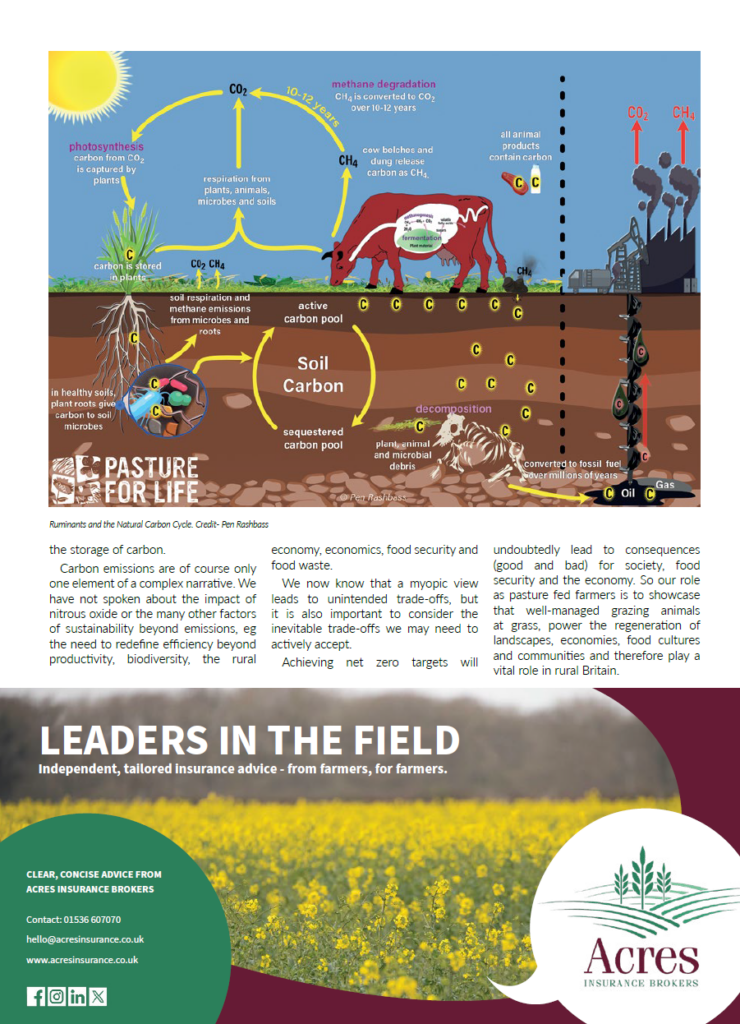
-

Turning the Tide: How Digital Intelligence Can Help British Farmers Break the ‘Perma-Crisis’
Let’s be honest — there’s hardly a farmer in Britain today who doesn’t feel like they’re paddling upstream. Whether it’s arable, livestock, dairy, or horticulture, the pressures are coming thick and fast. Soaring input costs, labour shortages, unforeseen legislative changes, wild swings in the weather, and post-Brexit market uncertainty are combining into something many are now calling a “perma-crisis.”
And it’s not just talk. Farm business incomes have dropped across nearly all sectors. Cashflow has become more fragile. Confidence in long-term investment is on the ropes. All the while, some businesses champion glossy sustainability initiatives that many label vanity projects and the government holds high-profile summits often without offering much to tackle the core issues: fair returns, workforce shortages, and the basic stability needed to plan ahead.
But in the midst of all this, something new is emerging — something quietly practical that could help farmers regain some control: national digital intelligence, applied properly and fairly, with the farmer in the driving seat.
Smart Farming: Making Complexity Work for You
You’ve probably heard talk of “smart farming” before. It’s sometimes presented with a lot of hype and little context. But at its core, it’s not about drones or gadgets. It’s about having better information, when you need it, to make better decisions.
Think of digital intelligence as a reliable navigator. It won’t replace your experience or your instincts — but it can cut through complexity and show you what’s really going on in your fields, sheds, or glasshouses. Done right, it helps you:
- Spot hidden potential in your soils, crops, or stock
- Track and measure what really matters — from biodiversity to water use
- Reduce guesswork in decisions on inputs, rotations, grazing or diversification
- Anticipate challenges, from disease outbreaks to extreme weather
In short, it helps make the complex manageable. And that’s exactly what most farmers need right now: intelligent navigators that simplify, not overcomplicate, that provide credibility not incredulity.
Natural Assets: More Than Just ‘Nice to Haves’
The other piece of this puzzle is recognising what you already have — and how it can work harder for your business. Good soil. Clean water. Carbon. Pollinators and natural habitats. These are more than just tick-boxes for schemes — they’re foundational to the long-term health of your farm. These are systems of a system that determine our prosperity.
More and more, we’re seeing a shift toward treating these elements as “natural assets” or “natural capital”. By properly measuring, managing, and valuing things like soil health, biodiversity, carbon and water management, farms can unlock access to new opportunities — while improving resilience at the same time.
But here’s the catch: doing this right means working with trusted, credible standards that comply with national and international protocols.
When you securely and confidentially add your data (such as your operations, soil and biodiversity), no matter how little or how much, under your control and your ownership to those of others in similar conditions, facing similar decisions, the value of your data is amplified, opening new possibilities.
That’s where a new national initiative comes in — something built specifically with British farmers in mind.
Introducing NASDA UK — A Smarter Way to Use Farm Data to Open-up New Possibilities
NASDA UK (National Agency for Data in Agriculture) is a new, farmer-first platform developed by Trinity Natural Capital Pro Council. The Pro Council comprised of a number of organisations was launched in September 2023 at Windsor. The platform is built on a simple principle: your farm data has value, you should only ever need one version, you should control it and benefit from it to the max.
Here’s how it works:
- Farmers and landowners join for free
- You choose what data to contribute — securely and anonymously
- You keep full ownership and control over your data
- Data can easily be permissioned and shared by you, to alternative management platforms and tools. You keep control, no laborious duplication of data and one version of the truth.
- The data hub includes a marketplace where you can choose to anonymously sell your data. You’ll receive 95% of the profits from the sale, with the remaining 5% going to national agricultural organisations in each UK region, such as the Royal Agricultural Society of England and Scottish Land & Estates.
- Pooled data is used to create big-picture insights and decision tools
- The whole system works with UK and international data standards (like ISO and SBTI)
The amplified power of your data and hence the platform lies in combining thousands of data points into a single picture. That picture then feeds back to the farmer as practical insights from farmers (for free) to the supply chain to policy makers (at a fee for farmers).
In addition to confidently monetising the value of your data (no matter how little or how much you have), imagine having access to tools that let you:
- Compare your soil performance with local or national benchmarks
- Get AI-driven alerts about weather risks or potential pest outbreaks
- Weigh up diversification or agri-environment options with better clarity
- Track how investments in nature — like cover crops or wetland buffers — are paying off
- Reduce waste and boost margins by fine-tuning inputs based on hard evidence
Why This Matters Now
Trying to figure all of this out on your own is getting harder and harder. The reality is, fragmented data just doesn’t cut it anymore — especially with changing demands from policymakers and markets whether it’s about proof of performance, sustainability, and resilience.
NASDA UK offers a way to level the playing field — giving all farms access to the kind of intelligence that helps monetise data and simplify decisions.
What’s In It For You?
Let’s break it down. By joining NASDA UK, you could benefit in a number of very real ways:
- New income from your anonymised data
- Clearer planning using national-level insights tailored to your farm
- Improved profitability through better decision-making
- Stronger resilience with better risk forecasting tools
- Faster innovation from R&D that’s based on real farm conditions
- Shared knowledge through peer-to-peer learning and case examples
And because the platform is designed to evolve with what farmers need, there’s room for this to grow — from local benchmarking and tools for tenancy planning to futureproofing for climate and market shifts.
Breaking the Cycle
We’ve seen cycles before — boom and bust, price shocks, changing policy. But this “perma-crisis” is something different. It’s ongoing. And it’s eroding confidence in a sector that quite literally feeds the nation.
NASDA UK isn’t a silver bullet. But it is a practical step toward building something better: a UK farm sector that is more connected, better informed, and less at the mercy of external shocks.
As farmers, we’re not short on resilience. What we’ve been short on is clarity, control, and collaboration. With the right digital tools, shared insights, and focus on real-world results, we can begin to shift from reacting to rebuilding.
The bottom line? Farming in Britain has a future — but we need to make it ourselves. And it starts by making smarter use of what we already have: knowledge, nature, and now, data.
Want to find out more about NASDA UK or register your interest? Visit https://www.trinityncpc.com/.
Public Service Trusteeships held by Dr Hosein Khajeh-Hosseiny include:
- Royal Agricultural Society of England (RASE)
- National Oceanography Centre (NOC) & Chairman of NOC nnovations
- Royal Society of Arts, Manufactures and Commerce
- The Productivity Group
- Royal Albert Hall Trust
- The Brookings Institution (Washington DC, USA)
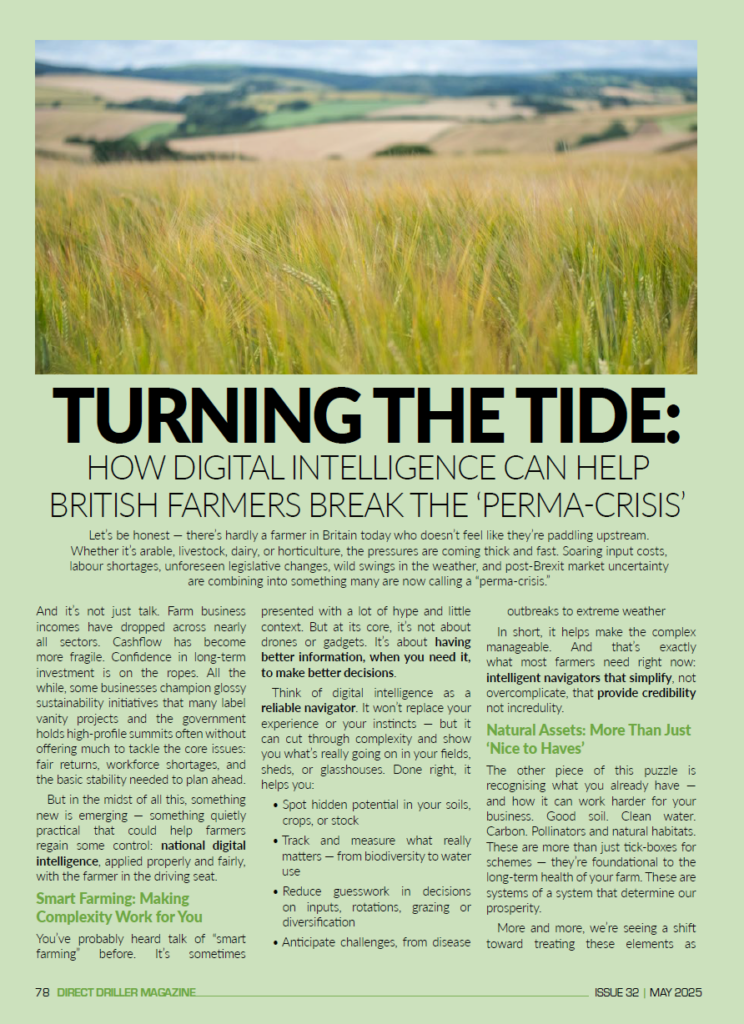
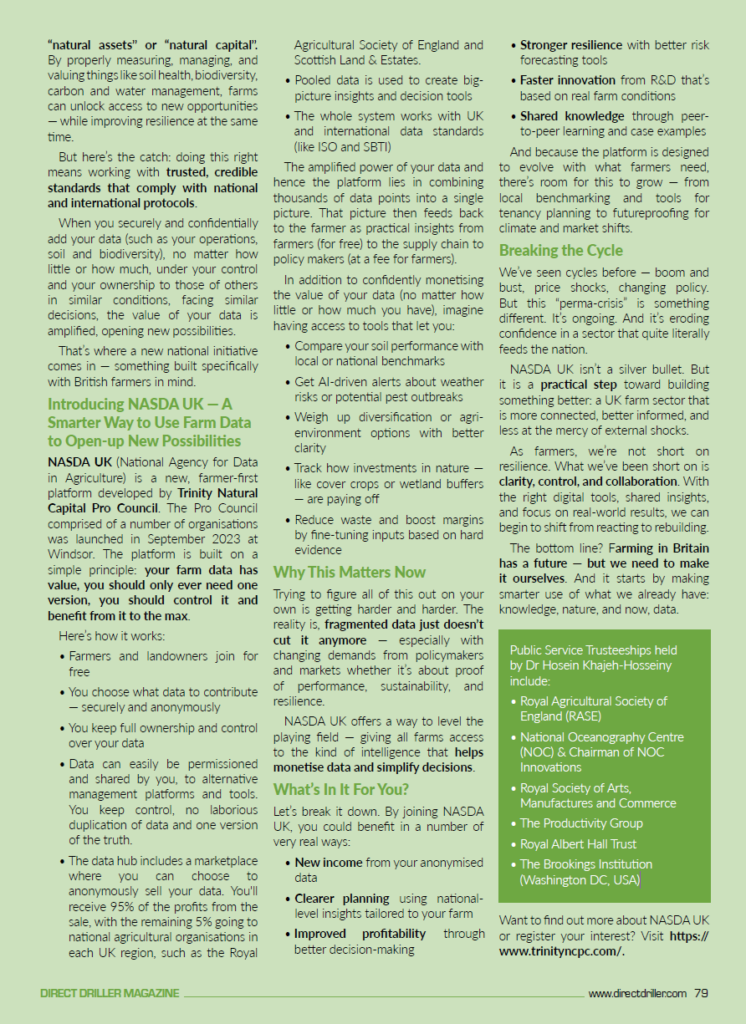

-
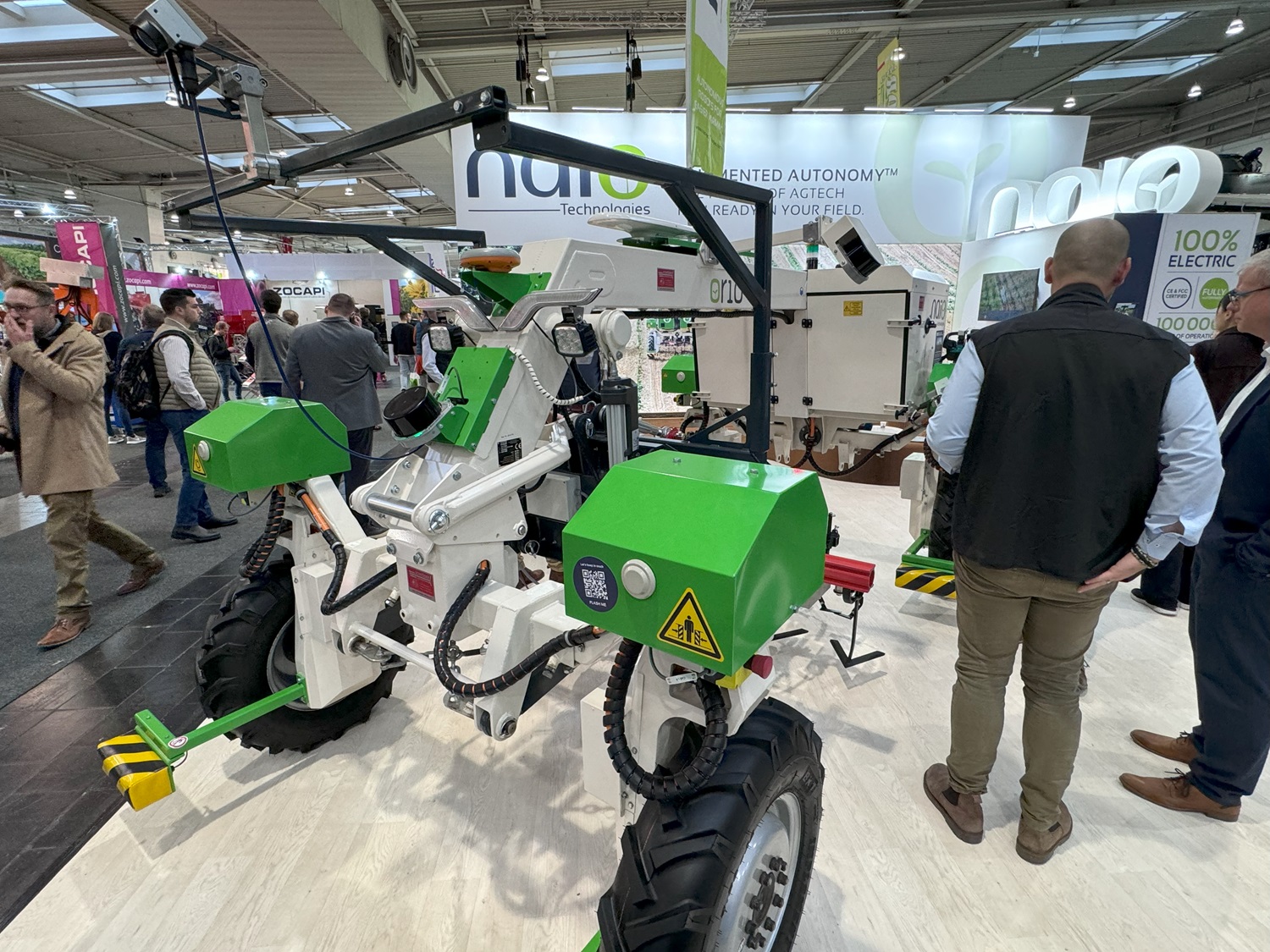
Ag Tech Has a Problem
There is a common saying around the industry that “Farmers are slow to adopt technology.” It’s a long standing perception and it’s linked to my last article on step verses incremental change. Step change is difficult.
But I do think this is used by companies to explain away slow adoption of their products to their investors. Ag tech as a whole, needs to look intrinsically if it feels this is really what is holding your solution back or is your approach holding your solution back?
The Year Long Problem
The perception that farmers are slow to adopt technology, in my view, largely stems from the seasonal nature of agriculture. In an industrial or automotive setting, implementing a new solution provides almost immediate feedback on its impact. However, in farming, results take an entire harvest cycle to materialise. When it comes to digital agronomy tools, additional variables like weather conditions must also be considered. This means the evaluation process can take years before confidence in a technology is fully established—something that many outside the industry might not fully appreciate.
Now, let’s consider some ag tech solutions that have been widely adopted, such as GPS guidance systems and boom section control. These provide instant feedback—farmers see right away that they’re not steering the tractor manually or that they’re reducing seed and chemical use on irregularly shaped fields. On the other hand, digital agronomy tools, like those designed to optimise nitrogen application, require much more time to assess. Farmers must wait until harvest to analyse yield data, then determine whether the results were influenced by factors like weather or specific management practices. Did the technology perform well only because it was a wet year? Would it work just as effectively in drier conditions? Should nitrogen be applied differently to maximise the tool’s benefits? Answering these questions takes time—sometimes years and sometimes isn’t even possible.
Ultimately, this long evaluation process isn’t a sign of slow technology adoption in agriculture—it’s simply a reflection of how the industry operates. If your product does not offer an immediate response on a farm then it is going to take a lot more explaining to farmers and they will see it’s use as a lot more risky or complicated.
What is your approach as an Ag Tech Company?
Now for the tough part—the moment when ag tech companies need to take a serious look inward if they believe farmers are slow to adopt new technology. The first question to ask is: how much time are you actually spending with farmers? How many farmers really know about your products and how many of them really understand them? Have you taken farmers on a journey of development or have you simply presented a solution.
From what I’ve seen, many ag tech companies focus heavily on those at the forefront of innovation—the early adopters. But if you truly want to scale your solution and move beyond the frustration of “farmers are slow to adopt technology,” you need to step outside that bubble. You need to be taking a lot more farmers on a journey with you. If you really think a farmer will take 3 years to adopt your product then you needed to have started speaking with them 3 years ago. That doesn’t mean your product needed to be ready 3 years ago (they wouldn’t have bought it then anyway). But those farmers needed to be part of your journey then, to be adopters now.
There’s a wealth of insight to be gained from everyday farmers, the ones who aren’t always chasing the latest tech. Their feedback might not always be easy to hear, but it’s exactly what the industry needs. Its how you change over the period that means those initial farmers who weren’t ready to adopt, become your advocates of the future.
Engaging with them will reveal what it really takes to scale a product for the broader market. Are you solving a genuine problem farmers face, or are you pushing a solution in search of a problem? And even if your product does address a challenge, is the value it provides enough to justify the effort and potential headaches of implementation? Sometimes, the reality is that a farmer might find it easier to live with the problem than to adopt a complicated solution.
As with most things in life – communication is the key. It’s not easy – but every farmer I know like a chat. They are happy to hear from you as well.
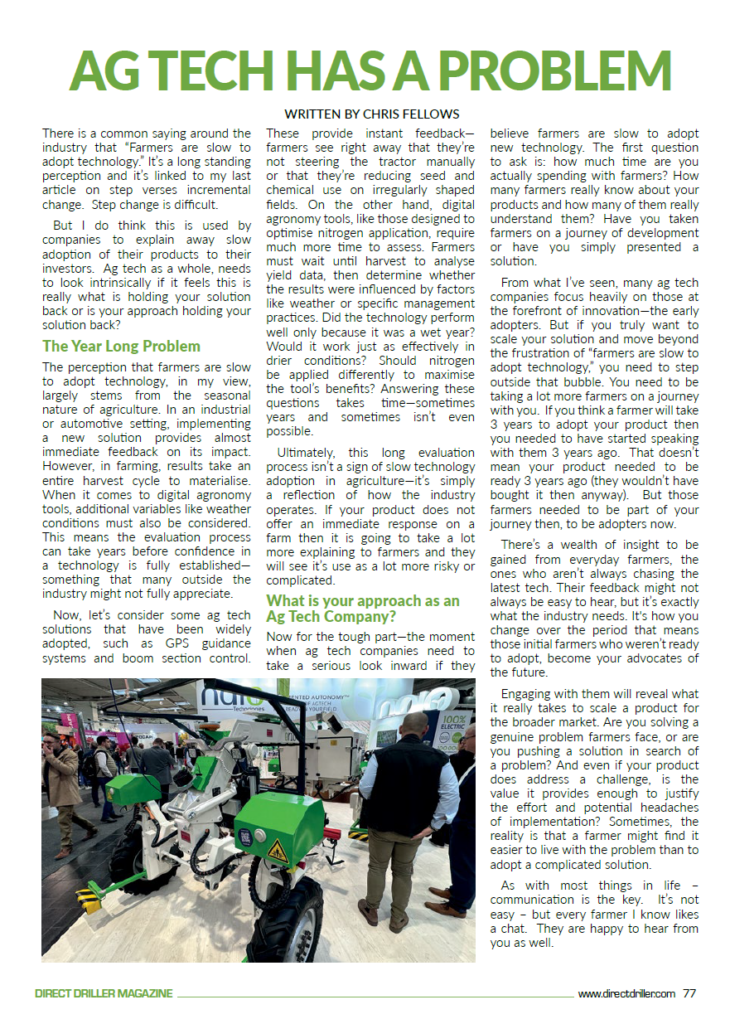
-

Parsnip Pioneers: the world’s first autonomously grown parsnip crop
Huntapac’s parsnip crop, grown without human machinery operation, used Skippy Scout drone monitoring operated by Agrii’s technical experts in the world’s first instance of entirely autonomous vegetable agronomy and production.
Huntapac, in collaboration with Autonomous Agri Solutions, AutoSpray Systems and Agrii, funded by the Marks and Spencer Plan A Accelerator Fund, successfully grew a crop of parsnips autonomously. This achievement is believed to be a world first.
The field-scale trial is the most recent step in a series of trials investigating how to improve the sustainability of Huntapc’s carrot and parsnip production, says Stephen Shields, technical and sustainability director at Huntapac.
“We have done a lot of work looking at low-carbon fertilisers. We started doing 80 acres and have expanded that to 1,700 acres this year.”
This work has been combined with an autonomous field concept, which is when Agrii and the other partners became involved. It coincided with Marks and Spencer launching the Accelerator Fund to discover innovative technologies that will enable its rapid progress towards becoming a net zero business across its supply chain by 2040.
To prepare the field, an AgXeed electric drive autonomous tractor was used for primary and secondary cultivation, says Tom Beach of Autonomous Agri Solutions.
“That was able to do the subsoiling operations and ploughing, which was the first case of autonomous ploughing in the UK. Finally, it did the bed tilling.
“A Robotti was utilised for the following lighter operations. We use this because it has a standard three-point hitch to use conventional agricultural implements, but it is substantially lighter and more accurate than a tractor.”
The crop was drilled using a single-bed Stanhay X-Series drill, comparable to what is used in a conventional tractor pulled triple-bed drill. Tom believes that the longer work hours possible using autonomous technology means that smaller-width implements will deliver at least the same efficiency as larger human-operated ones.
The Robotti was responsible for the weed control, spraying the pre-emergence herbicide across the entire bed width. Subsequent applications were made post-emergence using a band sprayer on the rows and an inter-row hoe between them.
The project called on AutoSpray Systems’ expertise in drone spraying for variable rate and selective biopesticide and fertiliser applications. Robert Pearson, CEO of AutoSpray Systems, explains that the technology is well-equipped for the precise application of pesticides.
However, what drones can apply is limited by regulation because plant protection products approved for use in parsnips need specific approval for aerial application. Most biopesticides and fertilisers can be applied through the drone system, says Robert.
Autonomous vegetable agronomy
To monitor the crop and guide the precise application of plant protection products, Agrii used a drone equipped with Skippy Scout to do the agronomy.
Skippy Scout is a software system that will automatically fly a drone to selected points in a field and send high-resolution, leaf-level images to aid with decision-making. The system analyses the captured images and sends a field report, explains Jonathan Trotter, technology trials manager for Agrii.
He used a drone to collect data from the field every few weeks. Parsnips were not a crop that Skippy Scout was working with before the project. “That’s a really nice element of the project; we’re developing the AI in the background to use Skippy Scout in parsnips going forward.”
“We’ve reported back to the group every time we have surveyed the field. The idea is that we can then deploy the other technologies accordingly,” explains Jonathan.
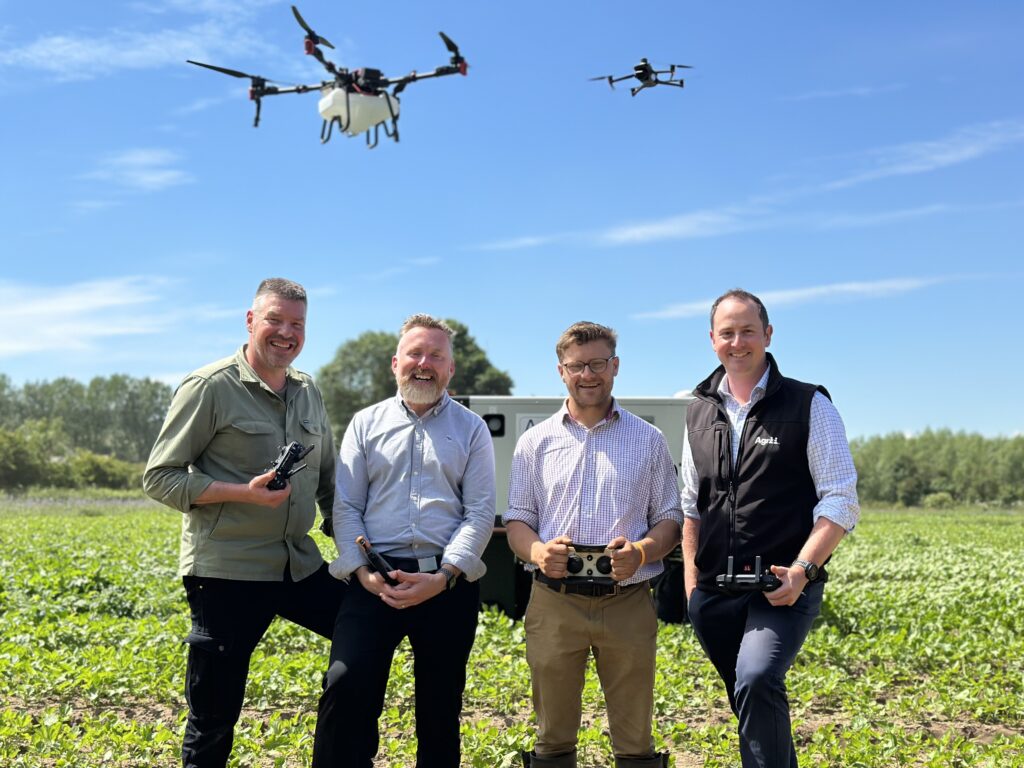
“Skippy Scout helps identify the areas to be treated, which can be inputted into our app to treat those areas specifically,” says Robert. “We’ve been asked if our (spray) drones can do the same level of crop monitoring, and our response is absolutely not. That’s where Skippy Scout is a perfect solution.
“We believe this method will allow conventional chemistry to remain on the market for longer because you apply much less of it using our precise process. At the same time, it allows us to apply more novel products much more easily.”
Robert used the drone to apply bio-fungicides to the crop for disease prevention. This is a task a drone is especially well-suited to because the airflow from the propellers agitates the canopy, giving excellent leaf coverage for the bio-fungicide.
Scaling digital interoperability
The successful field-scale trial has demonstrated a 46% reduction in carbon emissions and significant labour and input savings. Naturally, thoughts move to how the system developed by the group can be rolled out on a larger scale.
Interoperability between the systems controlling the decision support tools and machinery is a crucial milestone. This is a challenge Agrii has already begun working on.
“We are integrating Skippy Scout with our digital platform, Contour,” says Jonathan. “This can then be linked to soil mapping through Rhiza, and further into the future, it could export treatment recommendations to the other technologies used within this very project.”
Tom Beach says the sprayer on the Robotti is already equipped and ready to do this. “It has the standard Topcon ISOBUS, giving us full variable rate capability. We can input field maps or shape files, whatever the source is.”
The data could originate from an agronomist or decision support system like Contour. As well as applying variable rates across the sprayer’s width, Robotti can be programmed only to treat specific areas and return ‘as-applied’ data through its Crop Eye camera.
More precise digital record-keeping will benefit Huntapac’s relationship with its suppliers, says Stephen Shields. “The request from our customers is to have full electronic traceability throughout the process. For some, that’s from 2025.”
Tom concludes by saying that regardless of the ag tech’s sophistication, external factors like the weather and soil conditions will still dictate how the crop is grown.
“As much as we can automate the sensing and recommendations, we are a long way from removing a human from the decision-making process.
“Robots will do whatever you tell them, but knowing what to tell them still requires a huge amount of skill.”
What is involved in growing a parsnip crop autonomously?
Autonomous tool Action AgXeed AgBot T2 Subsoiling Ploughing Bed tilling Agrointelli ROBOTTI Drilling and Nemguard (garlic extract) application Pre-emergence herbicide spraying Granular nitrogen placement Band spraying (herbicide, insecticide and trace elements) Inter-row hoeing Skippy Scout powered drone (Mavic 3 Multispectral) Crop monitoring, data analysis and decision support XAG P100 Pro Drone bio-fungicide application 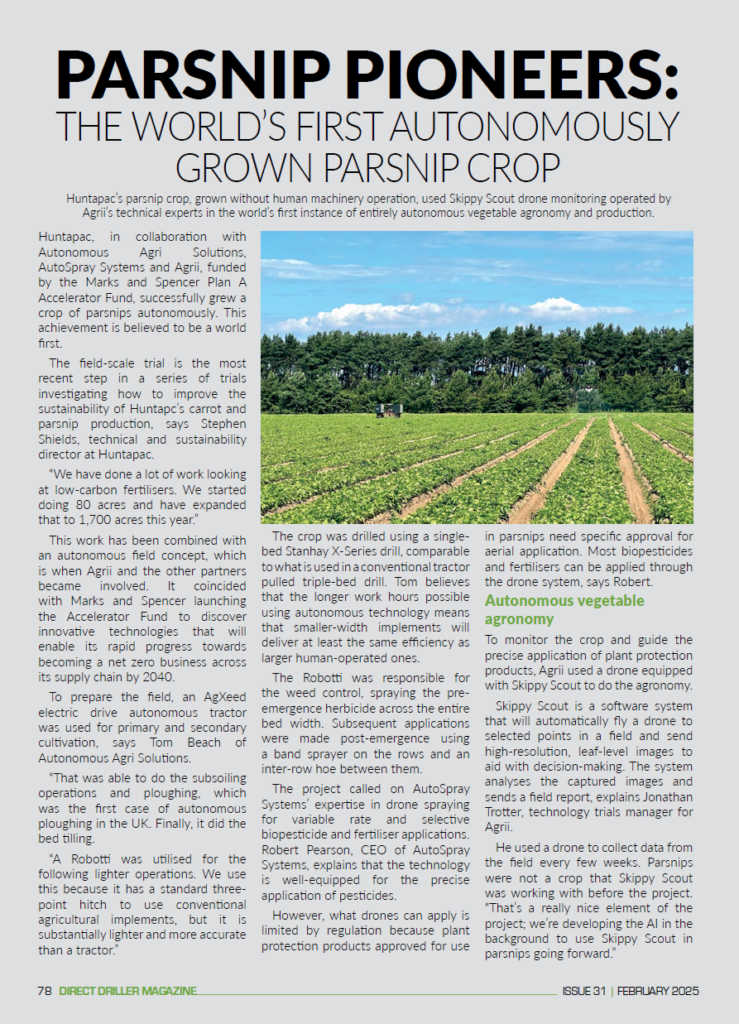


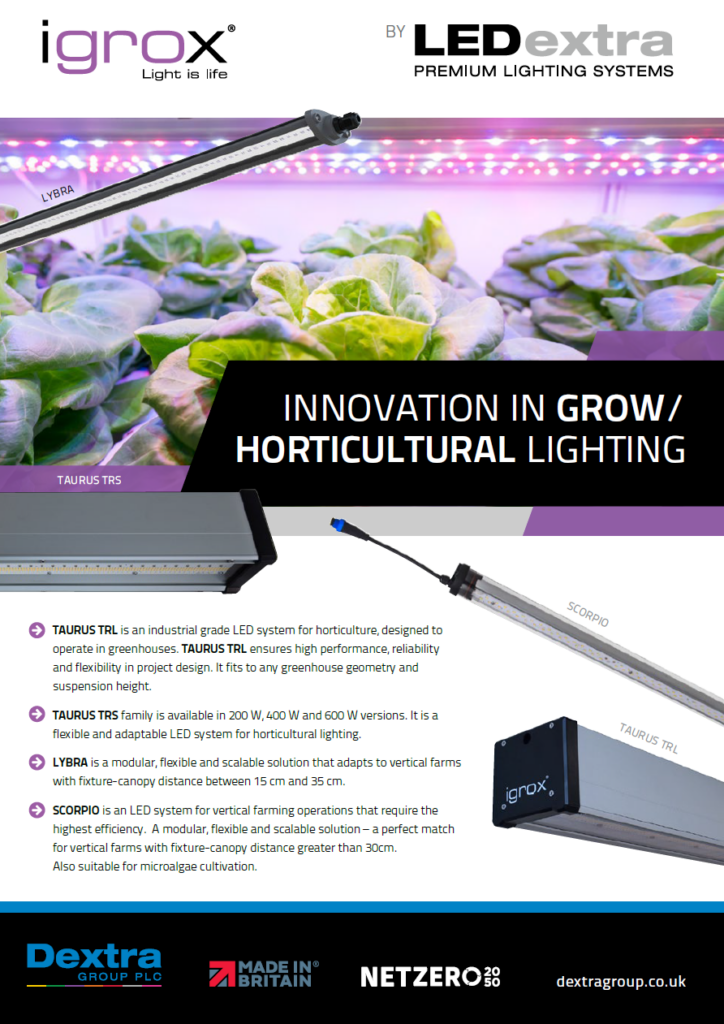
-

New genomic technologies flex their potential
Billions are being invested in gene editing globally, but what innovations will that investment deliver? Tech Farmer visited the World AgriTech Innovation Summit to gain a global perspective on what it might deliver for UK farmers.
Written by Mike Abram
There’s been no shortage of global investment in gene editing, even if venture capital funding in the area has plateaued in recent years.
Since the first research paper demonstrating genome editing of plant genomes using CRISPR/Cas9 was published in 2013, somewhere between $4bn and $6bn has been ploughed into start-ups applying the technology in agriculture, while similar, if not higher amounts have been invested by seed companies of all sizes, according to Syngenta head of seeds research Gusui Wu.
“Significant investment or funding has also happened in the public sector in plant gene-editing research,” he told delegates at the World AgriTech Innovation Summit in San Francisco.
Progress has been made in turning that investment into commercialised products. The US Department of Agriculture (USDA), for example, has granted exemptions for (effectively approving) 53 gene-edited traits in 17 crops, as of January 2024.
“At the same time, we have not seen the kind of big impact, large scale commercialisation of gene-edited products in the market yet,” Gusui acknowledged.
That’s not totally surprising, he argued. It took over 10 years from the initial publication of research for the last disruptive technology in plant breeding, transgenic genetically modified traits, until the first blockbuster commercial trait in Roundup Ready soybeans.
And it wasn’t simply because of the regulatory process, although that played a part. It was as much that associated application technologies, such as methods to introducing traits into elite varieties, also needed to be developed alongside the plant transformation technique.
The same is true for gene editing, where enabling technologies are also required. “The good news is that in the past five years significant progress has been made,” Gusui said. “And we’re now approaching a turning point for gene-editing new breeding technology.”
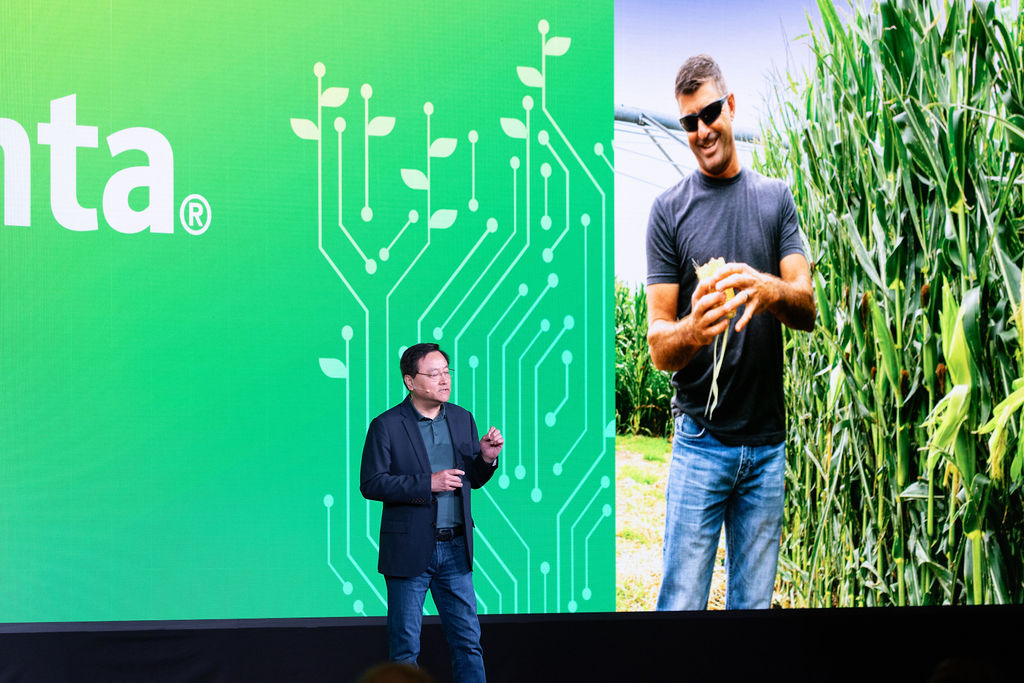
Syngenta has developed a method of introgressing any trait into elite lines in just one generation, says Gusui Wu. Progress includes development of alternative CRISPR/Cas systems by companies like Inscripta, Pairwise and Syngenta to the CRISPR/Cas9 system originally used, which overcomes some of the Cas9 limitations, including its murky intellectual property path, Gusui suggested.
Syngenta has also developed a method of introgressing any trait into elite lines in just one generation, rather than six or seven generations it usually takes. “These types of technologies are very important for the success of gene editing in agriculture,” he said.
“Perhaps the largest opportunity is how we apply gene editing to complex traits,” he noted. “For those traits it is difficult to make simple edits. Instead, we will likely need multiple gene modifications and that is a step change that can be brought by CRISPR.”
Making multiple gene edits at the same time, including different types of edit such as turning genes on or off, or regulating gene expression up or down, will be crucial to making transformational changes, rather than just incremental improvements, according to Inari CEO Ponsi Trivisvavet.
“We are targeting 10-20% yield improvements in three key crops – corn, soybeans and wheat – without adding any resources,” Ponsi said. “In corn, we’re also targeting a 40% reduction in water use and 40% reduction in nitrogen by improving resource use efficiency.”
Inari is using two technology platforms to help achieve those goals. The first, artificial intelligence-powered predictive design help scientists understand what genes to target and express more effectively, she explained.
“For the second part, we use multiplex gene editing to not only turn genes on and off but also think about increasing or decreasing gene expression, like dimming a light switch or making it brighter.

Making multiple gene edits at the same time will be crucial to making transformational changes, says Ponsi Trivisvavet. “And we only use tools that work on natural genes, meaning when we edit wheat, for example, we only edit wheat genes.”
That approach has led to the development of a potentially higher yielding gene-edited wheat. “There is no simple answer for how to increase yield. Through predictive design we are working to build an understanding of the wheat genome’s complexity and create a blueprint for updating the plant’s architecture with our multiplex gene editing,” Ponsi said.
“In this project we’ve explored edits to address grain size, quantity and weight, as well as the number of tillers.”
The first trials of the gene-edited wheat will be in Australia, after Inari signed a collaboration with Australian breeding company InterGrain. “We delivered our gene-edited seeds into Australia, where they are currently in a quarantine greenhouse. Once released they will be further evaluated in local field conditions in field testing.”
Inari’s technology is transferable to other geographies and crops, she added.
Another example of a gene-edited wheat in development was given by Prof Eduardo Blumwald, professor of cell biology at University of California, Davis. His research is looking to address the challenge of reducing synthetic fertiliser use in crops, such as wheat, while maintaining production.
The starting point for his research was examining plant exudates from roots. “The plant communicates with the environment through chemicals,” he explained. “They extrude chemicals all the time through their roots, and with that they can talk with the environment.”
The reason why that is important is that in the soil are nitrogen-fixing bacteria – 80% of our air is nitrogen and only those bacteria can fix that nitrogen into ammonia which plants can use.
“The problem is only 10-15% of the bacteria in the soil can do that. But they don’t because in agriculture soils need oxygen, and oxygen inhibits the nitrogenase enzyme that can fix nitrogen.
“So we started analysing the plant exudates to see which one of those chemicals can induce the production of biofilms in soil. Why a biofilm? Because the biofilm is practically impermeable to oxygen.
“So although there is oxygen in the soil, bacteria surrounded by the biofilm start behaving like hippies by forming colonies and sharing resources,” he said.
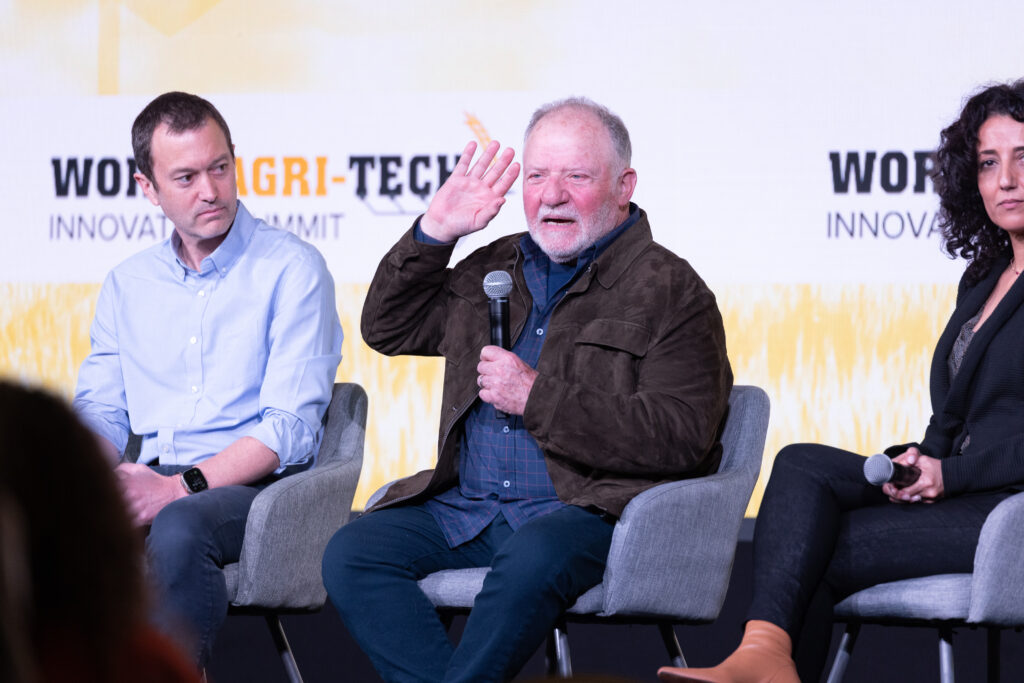
Eduardo Blumwald’s research has examined how plants communicate with the environment through chemicals exudates from roots. While surrounded in the colony by biofilm the bacteria fix nitrogen and produce ammonium.
“They’re happy, the plants are happy, and the farmers are happy as they can reduce the amount of nitrogen applied.”
Finding exudates that induced biofilm production was not easy, Eduardo stressed. “We screened almost 3000 chemicals and only found a few candidates.”
The next step was to understand the complex metabolic pathway that produced the chemical in the plant. Instead of over expressing the pathway for the plant to produce more, Eduardo silenced the enzyme that uses the chemical in the plant, so it accumulates, and more is ultimately extruded.
“It sounds easy, but it’s not,” Eduardo said. “But we did it in rice and in wheat.”
The result are crops that need 50% less fertiliser to grow, albeit ones that currently come with a 25% loss in yield in wheat. That could be improved, Eduardo hopes, with further development in the hands of a major plant breeder.
“We think there could be some issues with the way the plants are assimilating the nitrogen, so we are working with the breeder to find better varieties. We believe that in very old cultivars there might be some great candidates.”
Biotechnology firm Switch Bioworks is also investigating the use of microbes to fix nitrogen to replace synthetic nitrogen fertiliser. Its initial research focused on corn, Elizabeth Ordeman, senior research associate at the firm, told Tech Farmer.
“We are isolating the best colonisers and nitrogen fixers that already live around corn roots, and then engineering them to share nitrogen with the plant.”
Typically, wild-type bacteria won’t share nitrogen because of the high energy intensity required for nitrogen fixation. “The resource is very precious for bacteria. What we do is add a genetic switch to microbes already great at fixing nitrogen that allows them to release ammonia that can be used by the plant.”
While the concept of engineering a microbial biofertiliser product isn’t unique to Switch Bioworks, the key differentiator for the company is the separation of the process of building the microbial population and producing fertiliser.
“If you engineer a microbe that always produces fertiliser, since it’s an energy intensive process, the microbe can never grow or compete well in the soil, and you don’t end up with that many bacteria producing fertiliser in the field,” Elizabeth explained.

Switch Bioworks is investigating the use of microbes to fix nitrogen to replace synthetic nitrogen fertiliser, says Elizabeth Ordeman. Switch Bioworks engineered bacteria incorporates a sensor that leads to the activation of ammonium release later in the season, once the population has built. “You get this period where the microbes grow and colonise the root, and then when they are at a high number and the plant needs nitrogen the most, you turn on the ammonium production.”
How exactly that happens is the firm’s intellectual property, but Elizabeth said there were a number of different options available that could serve as the trigger, such as changes in the soil, changes in the bacteria or something related to plant exudates to name just three.
But building the microbial population first was critical, she stressed.
“Every time the population doubles, it doubles the amount of fertiliser the bacteria can produce. It’s how we think one ounce of dried microbes will be able to inoculate an entire acre and replace up to a 100 lbs/acre (112 kg/ha) of nitrogen.”
US start-up Napigen is specialising in gene editing of mitochondrial DNA, using it to develop male sterile wheat plants that can be used in hybrid breeding of wheat.
Development of hybrid wheat has been held back commercially because of the difficulty in producing a viable hybrid seed production system in the crop, with one key challenge the development of male sterile parents, Dr Hajime Sakai told Tech Farmer.
“Currently there is no efficient, stable method of producing male sterile plants, but we hope our technology will enable that.”
Male sterility in rice, vegetables and wheat occurs naturally through genetic differences in the mitochondria, so Napigen is mimicking that through its gene-editing process.
The result, according to Hajime, will be a reliable male sterility trait in elite wheat lines in a much cleaner genetic background than anything currently available.
Once proven, he expects to partner with seed companies to develop hybrid wheat that could increase wheat yields by anything from 15% to even doubling current yields.
Napigen is also using its technology to develop other products, such as herbicide-resistant crops that will not cross-pollinate with weedy plants.
Gene-edited nematode resistant potatoes being developed
Israeli biotech start-up GeneNeer is developing gene-edited potato traits using its proprietary “Superlines” platform, including nematode and disease resistance.
Gene editing in potatoes has proven challenging, even with the newly developed gene-editing tools, CEO and co-founder Dr Kinneret Shefer says, partly because of the inability to completely remove the gene-editing machinery.
As long as foreign DNA is no longer present in the final gene-edited product, most regulatory bodies across the world do not regard the edited crop to fall under genetically modified regulations.
However, removing the DNA is difficult in potatoes due to vegetative clonal propagation from tubers rather than from true seeds. The complexity of the potato genome, particularly its tetraploidy – four copies of each gene – is another complicating factor, which makes generating new traits challenging.
GeneNeer is overcoming these challenges through its Superlines platform, which simplifies the gene-editing process by creating tissue cultures of leading varieties that serve as innovation platforms for researchers to modify genes and create improved traits.
This eliminates the need for crossing or single cell assays to remove the gene-editing machinery as well as reducing the time to produce improved traits.
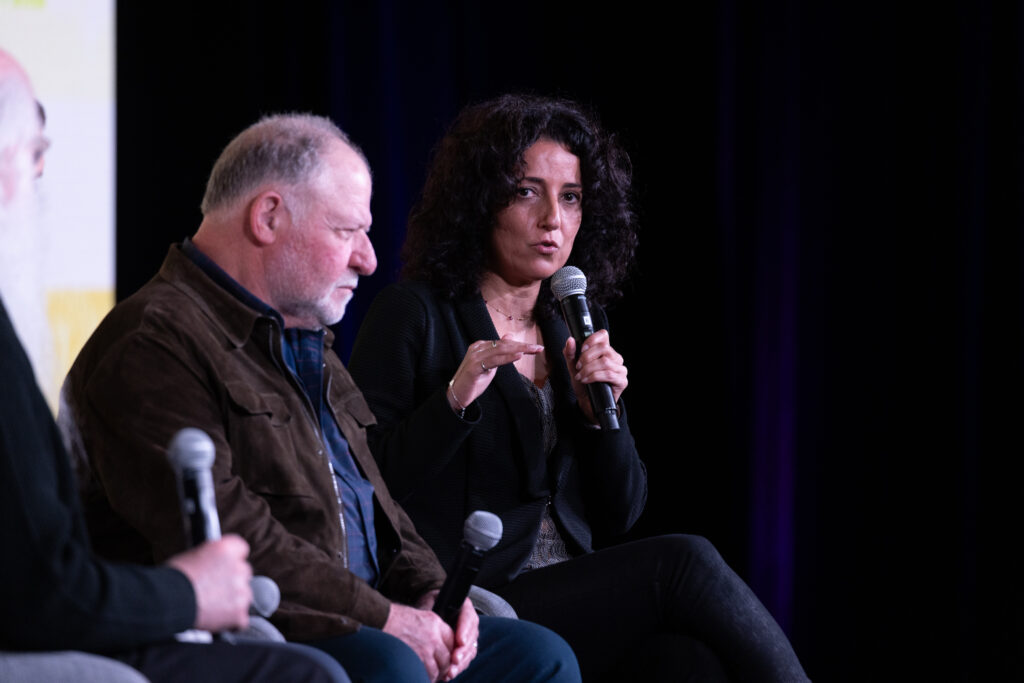
One of the first traits arising from GeneNeer’s platform is a gene-edited potato with nematode resistance.
“We can use our technology to silence genes in a tissue-specific manner,” Kinneret explains. “Our manipulation occurs in the root tissues, where we silence some specific genes which prevent the nematode from proliferating. Even if a nematode attacks the potato, it cannot complete its lifecycle, cannot lay eggs and use the potato as a host.”
Initial work is being done in three varieties – Russet, Atlantic and Desirée – against both potato cyst and root knot nematodes.
The second development is aiming to solve what Kinneret suggests is a growing problem in potato production in North America – verticillium wilt.
“The reason why it is a growing problem is the push in Canada for faster maturation of the potato crop is genetically linked to greater susceptibility to the fungus causing wilt, Verticillium dahliae.
“It is very hard to target with chemicals, and because of the genetic link, it is difficult to solve with traditional breeding. However, with gene editing we can break that link,” she says.
What is gene editing?
Gene editing, also known as genome editing, at its most basic changes a DNA sequence in a living cell. It’s only been practically possible since 2012, when Nobel laureates Jennifer Doudma and Emmanelle Charpentier discovered the CRISPR-Cas9 method for precisely editing genomes.
Using such a tool allows breeders and plant scientists to “cut” a specific DNA sequence and rely of cells’ natural DNA repair mechanisms to introduce changes at that site. Think of it like a word processor used to edit documents – adding, deleting and replacing letters in the cell’s natural genetic code.
Editing just a single gene can have important effects. Most gene editing to date in food and agriculture are the result of simple edits like turning off, of “knocking out” genes. Examples include improved soybean oil with reduced saturated fatty acids, GABA-enriched tomatoes with higher levels of amino acids to lower blood pressure and browning-resistant mushrooms to prolong shelf life.
But simple edits may not be sufficient to tackle some challenges. The size and complicated nature of many plant genomes increases complexity, while some functions, such as water use efficiency or increased yield, can be driven by multiple genes working together rather than a single native gene.
Enhancements might also require different types of edit, where one gene might need to be knocked out, while other genes’ expressions need to be amplified or suppressed.
That’s where multiplex gene editing can help. It involves making a variety of edits and edit types to multiple genes at the same time. Coupled with the latest advances in genomics and artificial intelligence it provides the opportunity to address biological complexity resulting in accelerated crop improvements.
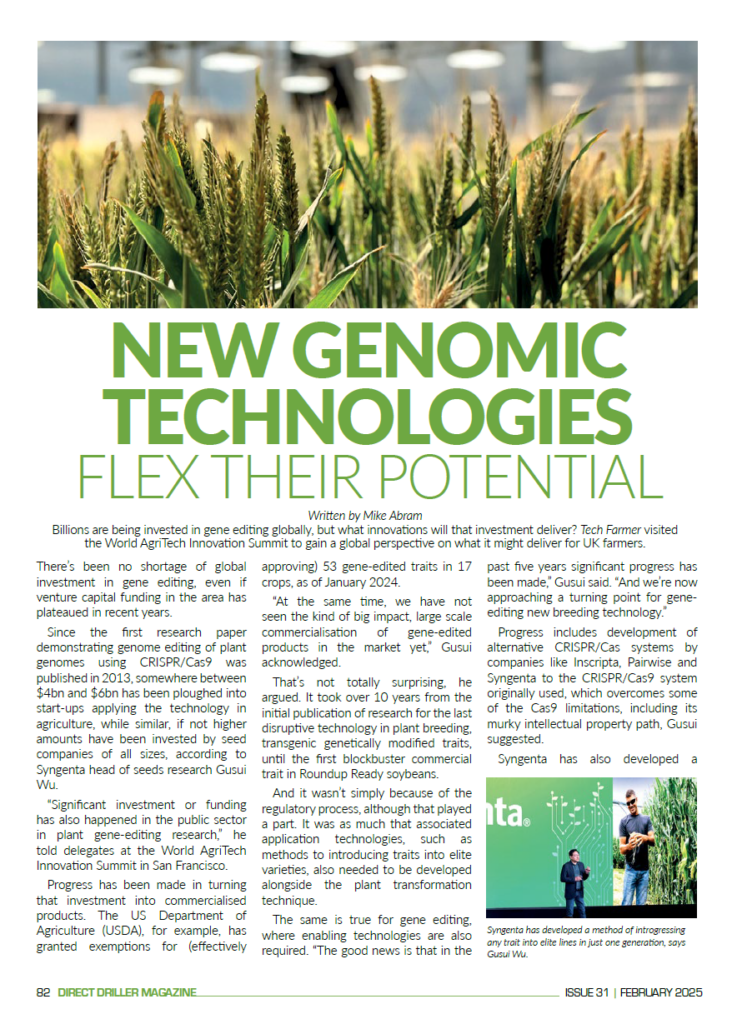
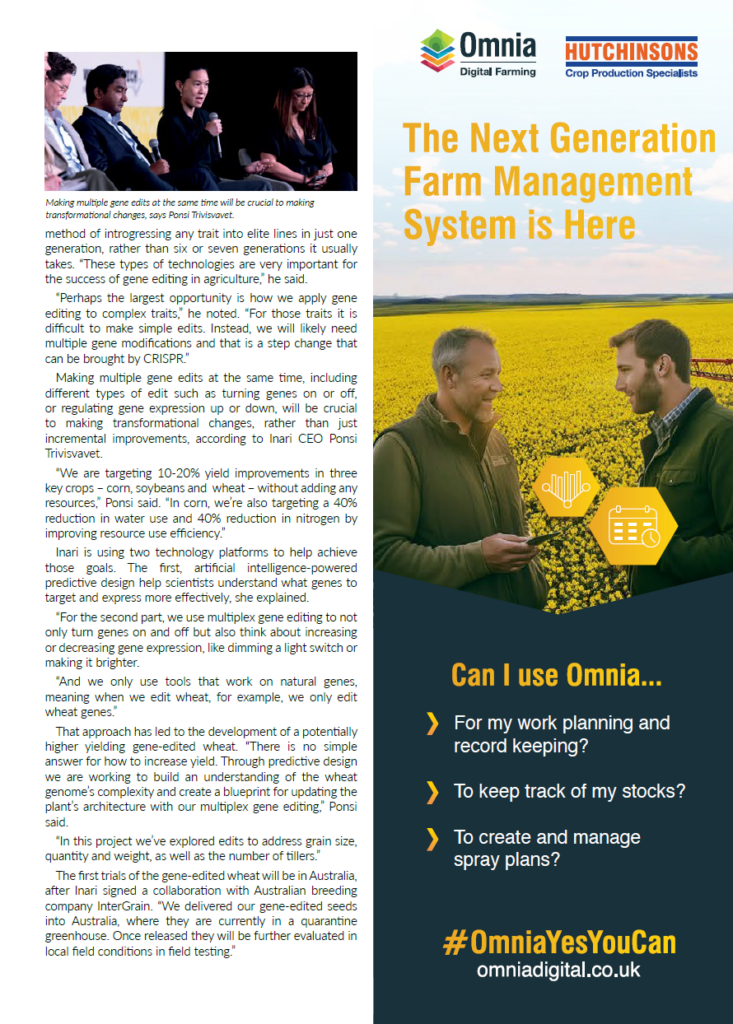
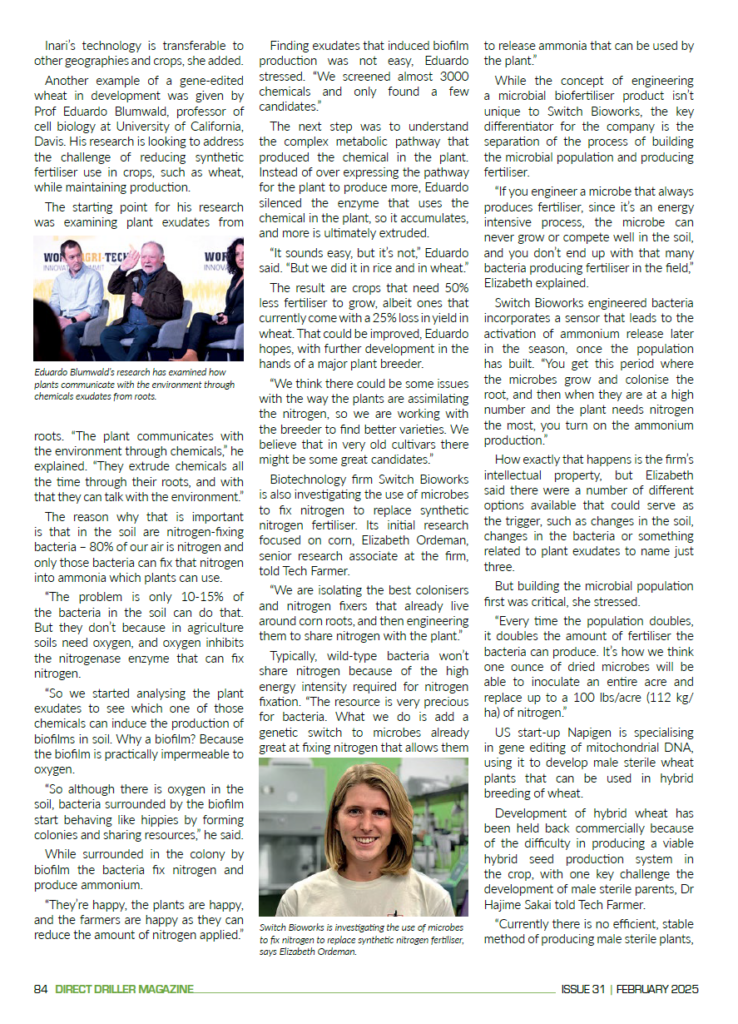
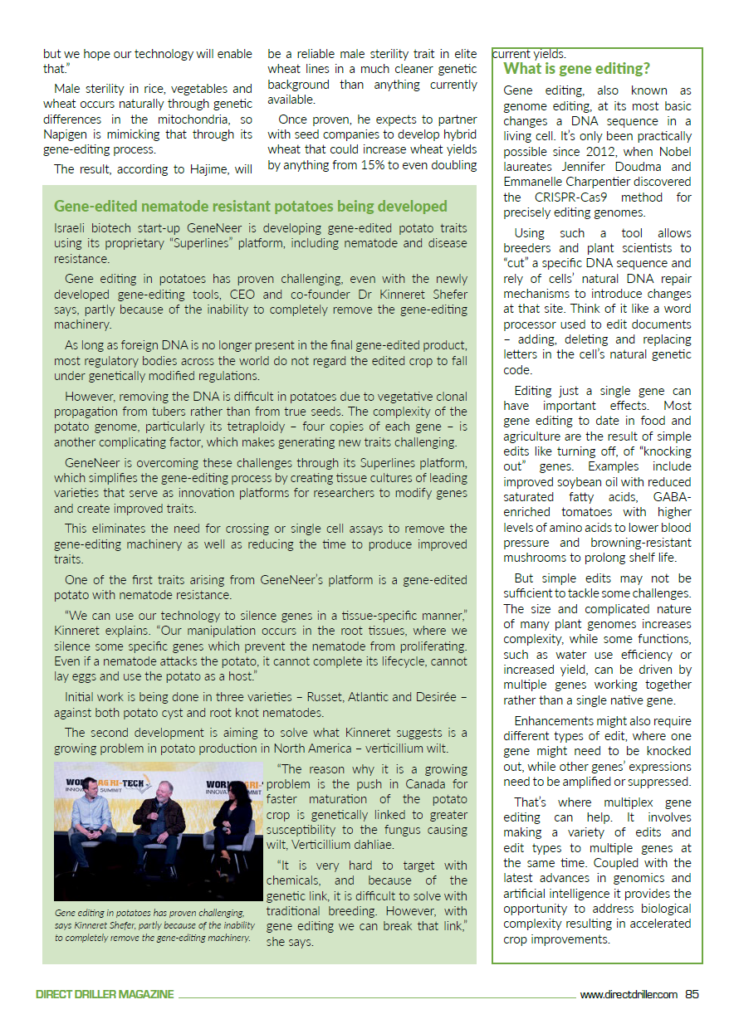
-

New technology connecting the lab to the field
Drone technology is unlocking the potential of traditional crop trials and helping to bridge the gap between detailed laboratory studies and field trials.
Drones were used to assess an oilseed rape trial this spring at a site in Yorkshire, gathering data that hasn’t been possible before.
The trial is a collaboration between Envirofield, Agrii and Yara. Envirofield is a crop research organisation that conducts independent trials. In 2022 it was acquired by Origin Enterprises, Agrii’s parent company.
Will Baldwin, director of Envirofield, says the business has maintained its independent status in the Origin group, but also benefits from being part of a bigger organisation. Most recently, this has included access to higher level technology via Agrii’s research and development drone technology to enhance trial assessments.
Will says: “Envirofield acquired a drone five years ago, but we didn’t have the capability to conduct assessments. It just gave us a nice visual perspective of a trial, with only the obvious differences showing.”
Jonathan Trotter, technology trials manager for Agrii has been operating the drone to assess the trial. He uses photogrammetry, a method in which the drone maps the trial with hundreds or thousands of high-resolution images stitched together for analysis.
He explains: “The brief from Envirofield was that Yara was interested in counting oilseed rape flowers and understanding how flowering is impacted by the products being tested. The exact details of the trial don’t concern me, my role is to help facilitate their work with the drone.
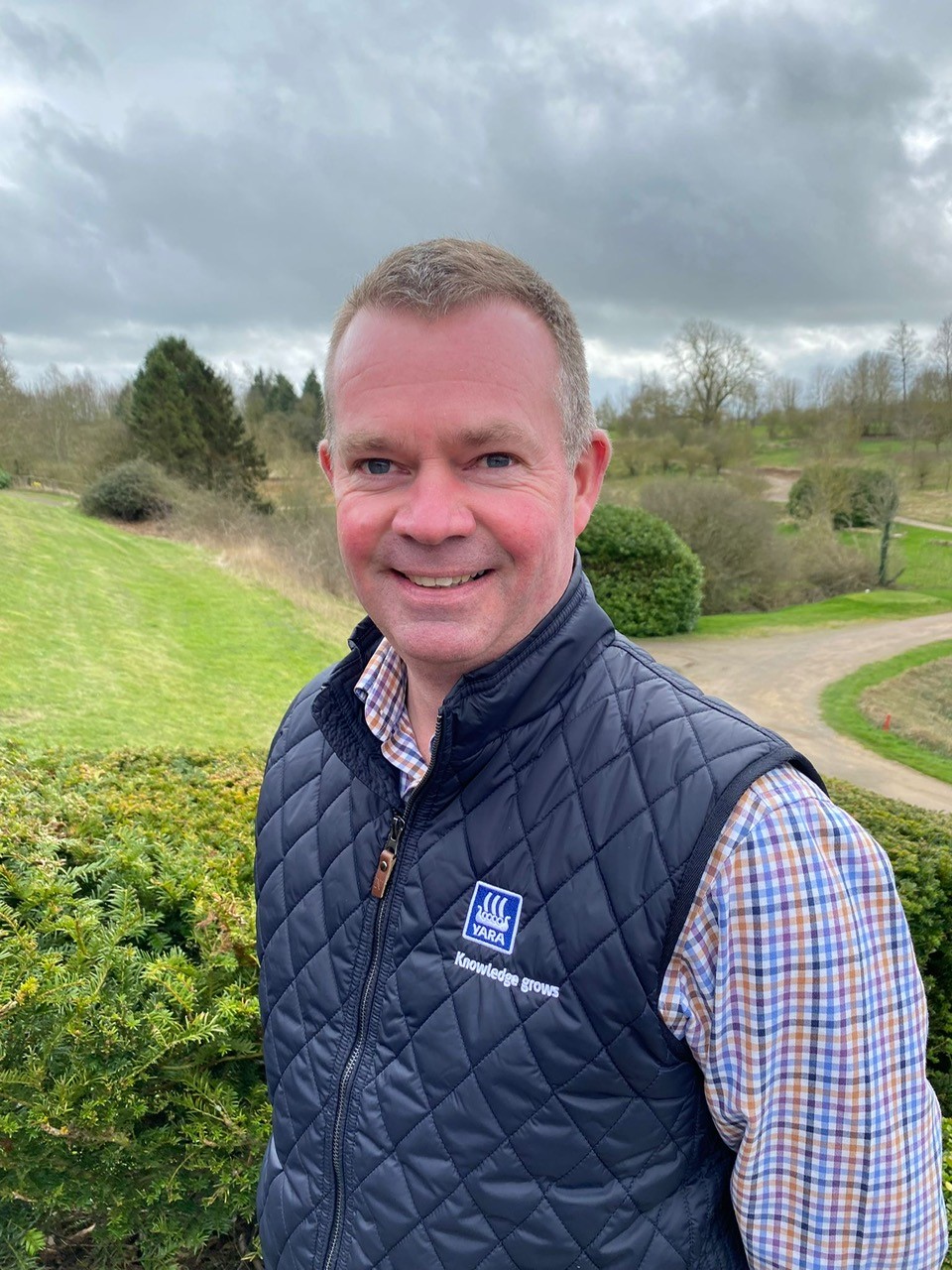

“I timed how long it took me to conduct an assessment using the drone. From opening my car door, doing the flight, packing the equipment away and finally closing the car door, it took 17 minutes!
“The drone flies across the plots at about 12 metres high. There are 40 plots, about 0.2ha, and the drone captures almost 400 images across the trial.
“Once the images are processed, every pixel equals 0.31cm of resolution,” explains Jonathan.
Agrii uses Solvi to analyse its drone images. Jonathan uploads the data to the platform, which takes about one hour to process.
Using a new tool that Solvi introduced, alongside Agrii’s experience with reflectance, Jonathan used the triangular greenness index (TGI) measurement. He explains that TGI filters out different wavelengths to remove specific colours, such as green and brown, leaving just yellow.
“TGI is perfect for only measuring flowering, which you can record as a percentage cover per plot, giving individual treatment results to monitor throughout the flowering period.
“This couldn’t have been done without a drone,” says Jonathan.
Chris Harrold, YaraVita product manager for Yara UK, says the company is investigating a range of pipeline products based on a mix of nutrients and biostimulants. Their global R&D team has found benefits in using them on flowering crops to improve flowering and pod set.

“We have been working on how we can develop these products in the UK on oilseed rape, peas and beans,” explains Chris.
“When our R&D team placed the trials with Envirofield, they requested a detailed flowering score assessment. Will Baldwin couldn’t imagine how they could accurately deliver this before drone technology was suggested.
“I saw the appeal of that, as did the R&D team. There’s a cost involved, but it’s only a fraction of the cost if we had tried to do it manually.”
The cold spring weather extended the trial’s flowering period longer than expected. Fortunately, since the drone assessments are relatively quick to conduct, Jonathan has been able to add additional assessments to cover all of the flowering.
Meanwhile the R&D team have been speaking to colleagues in Canada who expressed an interest in the work. They want to know if the methodology can be replicated in their country and if it works on other crops.
Chris continues: “Yara has been on board with the work from the outset. The results at the end of the year will reveal the benefits of the products we are testing. Regardless, I believe in the approach and can see its value in different crops and scenarios.”
He hopes to repeat the work next year to gather further data on Yara’s new products and expects the drone assessments to be an important part of the research.

Drone data enhances confidence in trials
Collecting data using drones allows Envirofield to have an archive of evidence showing how it produces its datasets from trials. Will Baldwin believes it gives companies placing trials with them confidence in their work.
He says: “We report what we find in the field at the time of assessment. The digital images taken by the drone can be revisited anytime to see exactly how the dataset was made. With traditional visual assessments, we rely on the eye of the assessor. If another party wants to look at the images, they can if they have permission.”
Will sees potential for drones to fill gaps in our understanding of new products as they go from being tested in glasshouses to small plot and tramline trials.
“What is possible in a glasshouse is not achievable in a field. If there are only one or two plants growing in a pot in a glasshouse, you can measure any physiological or pathological aspect you want in detail,” says Will.

Jonathan Trotter, technology trials manager for Agrii “Once you scale that up to in-field measurement, assessment becomes more subjective due to the large area you must cover to include variability across each plot. We could use two trial agronomists to conduct an assessment depending on what is required. This helps to alleviate any unconscious bias in the data, but that doesn’t always eliminate it.”
In the short term, Will says drones will enable trial contractors to conduct assessments in the field that could previously only be done in a controlled environment. Looking further ahead, he believes they will make it possible to capture even minor differences and account for spatial variation across much larger-scale (tramline) trials and more frequent assessments possible.
He concludes: “Our job in R&D is to give growers the confidence that the data we are collecting is done in conditions that reflect growers’ actual practices.”
Drone in a box to allow autonomous operation
Although the drone assessments only took 17 minutes, Jonathan Trotter had a three-hour round trip to get to the site. Authorisation by the Civil Aviation Authority (CAA) of the ‘drone in a box’ (DiaB) concept for trial use could eliminate the travel time and allow Agrii to assess the trials remotely and more frequently.
Jonathan explains: “Fully autonomous flight would allow us to capture the data daily to see exactly when the plots started flowering, and monitor that through the whole period to count how long each plot is flowering for and how extensive it was.”
In May, Agrii installed one of the first DiaB systems to be used for trial plot data collection and analysis in the UK at one of their sites in Yorkshire. The team is collaborating with DroneAg via Skippy Scout on this project.
“For now, we must use it with a person monitoring the drone as it flies autonomously. We have to be there with a visual line of sight and be able to take control if necessary,” says Jonathan.
“This is part of the process for us to prove autonomous drone flights are safe and possible to receive authorisation for fully autonomous flights.”
He expects Agrii to receive approval in 2025. The process is complex, with authorisations granted on a company-by-company basis. The CAA assesses each case on its merits, creating a high bar for the investment required.




-

Farmer and scientist collaboration helps to unearth soil secrets
Farmers and scientists working on the TRUTH Project have revealed some intriguing findings from their first year of working together.
TRUTH (Thriving Roots Underpinning Total soil Health) is a three-year £1m project with twin aims of boosting productivity while improving soil health. The project is led by the British On-Farm Innovation Network (BOFIN) with four partners UK Agri-Tech Centre, the John Innes Centre, University of Nottingham and PES Technologies.
Ten ‘Root Ranger’ farmers were paid to carry out on-farm trials in year one (2024), with an additional 10 recruited recently for year two (2025). The Root Rangers’ farms represent varied soil types, across conventional, regenerative and organic systems. They are based across the UK from East Lothian in Scotland to Downpatrick in Northern Ireland and as far south as the Isle of Wight. The farmers each chose a treatment they wanted to assess and have been trained in soil sampling methods.
Microorganism discovery
Dr Tom Thirkell of Crop Science Centre in Cambridge is an expert in mycorrhizal fungi which he has been studying in wheat root samples taken by the Root Rangers. As well as healthy populations of mycorrhiza, Tom’s analysis of the Root Rangers’ samples has also uncovered some “unidentified foreign organisms” (UFOs).
Some of these appear to be bacteria, while others are likely to belong to an ancient but newly-described group of fungi known as Mucoromycotina.
Tom said: “We believe these can also form beneficial interactions with cereal crop roots, but there has been very little study of them compared to the arbuscular mycorrhizas.”
They were found in several samples and are not unique to a specific type of farm. “They are random in how they crop up, but a strength of this project is that we can repeat these tests in years two and three and see if there are any patterns.”
Tom also hopes that DNA sequencing of these samples may be possible in future, so that the ‘UFOs’ can be identified.
His findings from year one suggest that variations in fungal presence are influenced more by individual farms’ management practices, rather than the different treatments being trialled, but repetition of sampling in years two and three will develop this understanding further.
“There is a lot going on underground, but it can be uncovered through collaboration with farmers and other researchers through projects like TRUTH. It’s been well-documented that farm management impacts the soil microbiome. Moving forward, with an increased focus on sustainability and reduced chemical use, it is going to become more important.”

Microbial analysis
Dr Maria Hernandez-Soriano of the John Innes Centre is leading a fascinating investigation into soil microbial diversity. Her work involves analysing DNA from soil samples collected by Root Rangers across 10 farms, revealing a staggering 15,686 individual species.
At the John Innes Centre laboratories in Norwich some 222 samples from the Root Rangers were carefully processed to extract the DNA. The DNA was then prepared for sequencing by specialists to ensure the best quality analysis, and finally sent to a leading provider of sequencing services.
The scientists then compiled a ‘library’ of all the DNA found in the samples, naming matched sequences using extensive databases. The result is a vast spreadsheet listing all the individual species found in each sample – a total of 15,686 across the Root Rangers’ soils. From there the data was analysed, drawing comparisons across different systems and the whole dataset, but also drilling down into individual farms’ results to assess and compare diversity.
Maria said: “At the moment the results are suggesting that management is the strongest influence.” In particular, the organic farmers amongst the Root Rangers had the most diverse samples with a significant difference in nitrification too.
Diversity is important because these microbes work together as part of a complex network, both in cooperation with each other and regulating their different roles in soil. “It’s a huge community – some of which we know a lot about while others are yet to be characterised.”
Understanding the activity of nitrification bacteria helps in improving nitrogen use efficiency, Maria added. She has been looking closely at two of the most prevalent nitrifying communities, Nitrososphaera and Nitroscosmicus archaea. These have become the biomarkers in the rhizosphere of modern cultivars following N-fertiliser application, to the detriment of other communities, she explained.
“The abundance of these microbes in soil dramatically increases when you apply ammonium-based fertilisers, rapidly turning ammonium into nitrate, which is highly soluble and easily lost to the environment through leaching or gas emission as nitrous oxide.”
Year two of the project will focus more on the rhizosphere and now with 20 Root Rangers on board the sampling will produce an even stronger dataset.
“Working on the TRUTH project is a dream,” says Maria. “The farmers have been brilliant, and have sent us quality samples meaning that scientists like me can focus on what we do best. Through our work together we can deliver information that is of real value to the farmers.”

A 360 view of soil health
The Root Rangers have also been given a unique view of their soil structure and root systems through X-ray Computed Tomography (CT) scanning.
Dr Craig Sturrock of the University of Nottingham explained that CT scans were used to compare soil ‘cores’ from the different farms. The farmers took samples from their chosen fields of first winter wheat using sections of plastic pipe (15 cm x 8 cm). These were hammered into the ground before being carefully excavated to preserve the structure of the soil and roots inside. Each of the Root Rangers took 10 samples in a typical w-formation, five samples from the treated area under scrutiny in their trials and five from the untreated area.
Craig explained: “It’s been a really exciting first year of the project, using the imaging technology to visualise the structure of soils across the UK, completely non-destructively, which is usually really difficult to see.
“We’ve found some nice differences between the soils. There’s variation between geographical location, soil texture, treatments, and differences in the root structure.”
The research highlighted the impact of management practices, such as ploughing and grazing. The results were not always as expected, with ploughed soil showing minimal differences to min or no-till. This may have been related to the time of sample collection being relatively late in the growth season (May 2024), where the soil has had time to settle after cultivation the previous autumn. “This year we plan to sample in March so tillage differences between sites may be more apparent.”
In year two the Root Rangers will repeat the sampling process, but this time with five soil cores just from untreated areas.
Craig concluded: “I’m really looking forward to year two of the project, seeing how the results will look and what more we can learn from repeating the sampling.”
Root Ranger feedback
Anna Pearce is an organic farmer and seed producer from Northumberland. She joined the TRUTH project as she was keen to work with scientists to learn more about the health of the soil on her farm.
She said: “As farmers we don’t often get the opportunity to interact with scientists and this is a huge opportunity to be able to put our heads together.” Anna was particularly interested to find out how her soil compared to other farms and to see the soil core CT scans.
“It is fascinating to see pictures of what is under the ground,” she said. “It was reassuring to learn that my soil copes well with being lightly ploughed and that there is enough life in it to repair any changes to structure.”

Hertfordshire farm manager Ted Allen-Stevens also welcomed the opportunity to take part in the project, particularly as it validated the introduction of regenerative practices on the farm.
He said: “When I saw our results from the TRUTH project I felt that I had some real evidence that soil health had improved since we brought in regenerative practices here.
“It’s only when you drill down into the detail of your own farm that you can get that substance and reassurance of what you’re actually achieving.”
Next steps
The second year of the project will build on the successes so far, with the soil/root testing tools under further scrutiny by the farmers and scientists. An innovative soil health sensor, developed by PES Technologies, will also be circulated amongst the Root Rangers who will put it through their paces. The sensor is designed to measure microbial diversity and fungal:bacterial ratio.
Also, in year two novel wheat varieties are being multiplied ready for trialling on Root Rangers’ farms in the final year of the project. These include a ‘remarkable’ variety that can moderate its own nitrogen supply. Originating from Iran, this particular wheat landrace is part of the historic Watkins collection at JIC.
Maria Hernandez-Soriano explained: “What is interesting about this particular wheat, is that it has demonstrated capacity to decrease the transformation of ammonium into nitrate in the soil. This is believed to be an adaptive trait.”
It means much less nitrogen from fertilisers potentially being lost to the environment and more being taken up and used by the wheat plant itself, because it is controlling the transformation in soil and optimising the uptake.
“We haven’t observed that same capability or trait in any commercial wheat cultivars yet, so that is remarkable.”
Tom Allen-Stevens, managing director of the British On-Farm Innovation Network (BOFIN) which leads the project said: “The quality of samples and resulting data has proven again the value of on-farm trials and what can be gained when farmers and scientists work together.
“There is a huge appetite amongst farmers to learn more about soil health. This project is paving the way for discoveries about how we can improve the long-term productivity of our farms through improved understanding and management of our most precious resource.”
TRUTH is funded by the Farming Futures R&D fund, part of Defra’s Farming Innovation Programme. Defra is working in partnership with Innovate UK, the UK’s innovation agency, who are delivering the programme. TRUTH is led by BOFIN alongside PES Technologies, UK Agri-Tech Centre (which is responsible for project management), John Innes Centre and University of Nottingham.




-

A ‘big revolution’ in nitrogen management
Written by Clemmie Gleeson from BOFIN
Could hyperspectral imaging revolutionise nitrogen management in agriculture? Clemmie Gleeson spoke to George Marangos-Gilks, CEO of agritech startup Messium to find out.
Hyperspectral imagery can overcome the limitations of existing nitrogen assessment methods, equipping farmers with high level insights that could optimise fertiliser applications according to George Marangos-Gilks.
Conventional approaches like lab tests are accurate, but often impractical due to high costs and time constraints, he says. Handheld sensors, though more accessible, struggle with farm-level practicality. And current satellite technologies using NDVI (Normalised Difference Vegetation Index) offer valuable biomass insights but fall short in directly quantifying crop nitrogen levels.
Hyperspectral satellites however are changing the game by capturing hundreds of wavebands, including the invisible infrared spectrum, far surpassing the capabilities of traditional multispectral imaging.
Initially introduced by NASA over two decades ago, early hyperspectral satellites were prohibitively expensive and data-intensive. However, 2024 marked a turning point with the launch of the first commercial constellations creating the possibility of cheaper and more powerful satellites. Indeed, the number of hyperspectral satellites is increasing at a rapid rate and Messium has secured priority supply deals with the major players.
“There is a new age coming with much richer data,” says George.

George Marangos-Gilks, CEO of agritech startup Messium Hyperspectral’s application for assessing nitrogen in crops is based around the fact that every chemical on earth absorbs and reflects a wavelength and has a spectral signature and research has shown that there are key nitrogen wavelengths.
“We can take these wavelengths and use that to develop a very good understanding of the amount and intensity of the nitrogen in the crop.
“Hyperspectral satellites are the first satellites that can accurately detect nitrogen,” he stresses.
Previous generation satellites such as NDVI are adept at understanding biomass – different levels of green density in the crop and where the biomass is larger or smaller – but they can’t tell if that biomass has high or low nitrogen.
“This is the big revolution. We are linking biomass and nitrogen insights together to then apply the science.”
Messium has collected more than 16,000 samples to date – each sample being a 50cm row of crop which is connected to a GPS location and sent to a laboratory where it is analysed for nitrogen concentration and biomass.
George continued: “We take this data and match it to the satellite images that were acquired at the same time. The more we link this data together the more powerful our predictive AI model becomes.
“We are confident that we’re on track to achieve a 90% accuracy level compared to a lab test in the next year.”
Handheld and tractor sensors are also accurate, but they are time consuming and impractical, he adds. Tractor sensors in particular only assess the crop as it is driven over.
“You could be two weeks too early or too late to hit that optimum nitrogen level. The obvious solution therefore is satellites. With satellites you can image an entire farm, but NVDI simply doesn’t do nitrogen.
“You could have high biomass and low nitrogen in the crop or high biomass and high nitrogen. It doesn’t tell you whether you’re above or below that nitrogen nutrition index, the critical nitrogen curve which is the key to utilising the science effectively.”
Cloud cover presents less of an issue for hyperspectral satellites than NDVI satellites, as they operate in networked constellations to increase the frequency of flyovers. Whereas legacy satellites have historically provided imaging opportunities every five days or more, hyperspectral constellations are moving towards daily, and eventually multiple times per day.
“There is basically a satellite overhead every single day, so the chance of having a cloud-free day in a two-week period in the UK is about 96%. With the number of satellites set to double in 2026, cloud is less of a blocker.”
In 2024 Messium collected over 1,000 samples from 47 farms across Europe.
“The results showed that 51% of fields were over-fertilised, they were 40% above the critical nitrogen curve. Then 39% of fields were under-fertilised, by an average of 28%. That’s a big error either side.
“But it makes sense – it is very difficult to understand the nitrogen concentration of a crop mid-season.”
Worldwide Messium has run 47 recommendation trials and plans to release results from its Australia and New Zealand harvest soon. From its trials in the UK 10 out of the 14 farmers involved saw a significant financial benefit in terms of cost saving from reducing nitrogen application and/or yield gained from increased application.
Three were helped with reduced nitrogen for the second or third application, says George. “For four farmers, who were actively trying to reduce nitrogen use, we could demonstrate how applying a bit more would boost yields.
“Then for three farmers, we noticed that nitrogen was not the limiting factor. Plenty of nitrogen had been applied, the crop was not responding, and it wasn’t increasing in biomass. This indicates, potentially a P, K, manganese or calcium issue instead.”

From left Vishal Soomaney Vijaykumar (Messium CTO and co-founder), Nick Wilson (farmer) and Violet Hill (Lead Crop Growth Modeller, Messium) Farmer experience
Mid Suffolk arable farmer Tom Jewers has been trying to reduce nitrogen applications to increase efficiency and has a keen interest in technology that could potentially help, but satellite imagery had previously been a source of ‘endless frustration’.
Speaking at a webinar co-hosted by Messium and the British On-Farm Innovation Network (BOFIN) he said: “We started using NDVI imagery in about 2011, but realised that if we couldn’t get even establishment, it was pointless.
“We then used a variable seed rate to try and get a level playing field, and then varied the nitrogen. When we were purely looking at biomass the advice was always to chuck more on the low bits, and invariably they don’t catch up, so you then put less on afterwards.
“It seemed to me that was the wrong advice.
“We’re now measuring the nitrogen in the crop. Here in the east of England we can suffer with very dry springs, so we’ve tended to start applying more and more N earlier.
“If we’re above the critical N curve, then it’s not going to take that nitrogen up as efficiently, because it’s already got too much, so our use efficiency will go down.
“The really interesting thing to me from working with Messium is the delay in application.”

Mid Suffolk arable farmer Tom Jewers Tom had eight trial strips – some managed under his usual regime, others with higher rates of nitrogen and another in accordance with Messium’s findings. The Messium strip received 227kg of Nitrogen and the strip next to it received 225kg however Messium strip yielded 0.6t/ha more. This was due to the timing of that application.
“Seeing that yield response from a place in the field where there isn’t historic variation was really interesting,” concluded Tom. “We don’t often see that sort of response from a trial so I’m quite excited by this.”
Oxfordshire farmer and managing director of the BOFIN Tom Allen-Stevens said: “It’s essential that farmers can make best use of the latest technology if they are to increase productivity and sustainability in 2025 and beyond.
“Satellite technology has become part of the toolkit for UK farmers seeking precision application, so hyperspectral imaging is of huge interest to those wanting to take their production to the next level.” “My advice to farmers is that to give it a go in trials as Tom has, to find out what difference you can achieve on your farm with your soils.”


-

Nuffield Recommendations for ‘AgTech’ entrepreneurship and development
Yorkshire entrepreneur Hannah Senior NSch has published her Nuffield Farming report ‘Innovating AgTech Entrepreneurship’, sponsored by the Elizabeth Creak Charitable Trust.
The full report is now published and available on the Nuffield Farming report library. A recording of Hannah presenting at the Nuffield Farming Conference watch via the QR Code.
During her Scholarship, Hannah travelled to New Zealand, Australia and the United States, in addition to conducting a number of visits in a further 11 countries via video call due to travel restrictions during the COVID-19 pandemic.
Hannah wanted to learn how to create a more vibrant ecosystem for AgTech entrepreneurs in the UK, understand beneficial support around entrepreneurship and how interactions between start-ups and farmers should operate.
In her report Hannah found that it was inappropriate to model AgTech entrepreneurship ecosystems on those found in Silicon Valley.
“Farming is a very different ‘problem space’ to computing or software,” she says. “AgTech innovation influences the food system, ecosystem and economic system, all of which are influenced by a complex set of interactions and feedback loops. This makes the impact of a new technology hard to predict.”
She identified a pattern which she named the ‘Chain of Extraction’ that happens at macro-level between the environment, agriculture, entrepreneurs and investors. “Despite both the two-way nature of the transactions and the many exceptions, overall benefits tend to accrue more in one direction than the other and this erodes one party’s ability to sustainably create value.

“Improving AgTech innovation requires greater awareness of this dynamic. It also needs creative approaches to align interests and address imbalances, paying attention to how risk, value creation and trust are created and shared.”
In her report, Hannah shares several suggestions, including involving farmers earlier in technology development, diversifying how early-stage investments are made and equipping people in AgTech with ‘Systems Thinking’ skills.
“Technology is only a partial answer to our problems. Changing less obvious things like how we solve problems, invest our capital and measure success will also be essential,” she concludes.
Study objectives
- Investigate how to better align interests between the environment, farmers, entrepreneurs and investors.
- Learn how to create a more vibrant ecosystem for AgTech entrepreneurs in the UK.
Key messages
- A lot of emphasis is put on technology to address agriculture’s major challenges. Technology matters, but it’s equally crucial to address other issues, e.g. how we solve problems, invest capital and measure success.
- Many entities are involved in agriculture and agricultural innovation, including governments, the environment, farmers, entrepreneurs and investors. Naturally all these parties want to benefit, but currently imbalances in the relationships undermine long-term value creation.
- Important differences exist between AgTech and the Silicon Valley innovation template that often informs entrepreneurial ecosystems. To align interests and make a more vibrant AgTech ecosystem these differences need to be considered.
- Equipping the agricultural sector to understand the complicated relationships and unpredictable effects of change requires a new ‘tool set’ – more skill in Systems Thinking will help.
- Farmers, growers and their representative organisations must be more involved in entrepreneurial innovation as idea progresses from its conception, to commercialisation, to a change in farming practice. We must also diversify who invests in AgTech start-ups and how investments are made.
- All this requires a greater emphasis on collaboration, which involves finding methods to build trust, share risk, and equitably distribute value that’s created.
Executive Summary – From Full Report
Written by Hannah Senior NSch
The potential for entrepreneurs to bring new technology to agriculture (“AgTech”) has created a recent focus for start-up activity ($19Bn invested in “on-farm” innovations in 2021). Most AgTech innovations promise to tackle agriculture’s most pressing concerns: environmental impact, labour issues and farm profitability.
This study set out to explore how to create a vibrant AgTech entrepreneurial community, and investigated questions such as what support around entrepreneurship is beneficial, and how interactions between start-ups farmers should operate. However, it also asked much wider questions such as whether AgTech entrepreneurship can really influence farming, the environment and the food industry in the way founders and investors often hope. I questioned the appropriateness of modelling AgTech entrepreneurship ecosystems too closely on what worked well in Silicon Valley. Farming is a very different ‘problem space’ to computing or software. AgTech innovation influences the food system, ecosystem, and economic system, all of which are influenced by a complex set of interactions and feedback loops. This makes the impact of a new technology hard to predict – what is a good idea in one respect (e.g. artificial fertiliser) can bring unforseen negative consequences (e.g. climate change impact, water pollution). I began to recognise a pattern that I came to call a “Chain of Extraction” that happens, at a macro-level, between the environment, agriculture, entrepreneurs and investors. • Agriculture extracts from the environment (e.g. biodiversity, carbon, water) • Entrepreneurs extract from farmers (e.g. time, insight, risk) • Investors extract from entrepreneurs (e.g. financial returns, mental health, lifetime earnings) • Everyone is extracting from the public purse (e.g. tax breaks, subsidies, publicly funded research) Despite both the two-way nature of the transactions and the many exceptions, overall benefits tend to accrue more in one direction than the other and this erodes one party’s ability to sustainably create value. The chain arises despite most people trying to do the right thing most of the time. It that emerges from the way social, economic and environmental systems operate. Improving AgTech innovation requires greater awareness of this dynamic. It also needs creative approaches to align interests and address imbalances, paying attention to how risk, value creation and trust are created and shared. Examples include: • Involving farmers earlier and more substantially in new technology development. Tennessee AgTech business accelerator AgLaunch does this well, working with farmers to select and trial entrepreneurs’ innovations while ensuring the farmers’ contributions are reflected when financial returns are distributed. • Diversifying how early-stage investments are made. Novel ways to structure startup investment (“innovative finance”) exist but are not widely used although there is emerging evidence that investors can achieve strong financial returns even with agriculture-like characteristics (e.g. ii longer adoption timeframes). Greater efforts to diversify who invests would also be beneficial. • Equipping people in the AgTech ecosystem with “Systems Thinking” skills (e.g. being better equipped to identify how/where to make change in complex systems, and understand how influences can deflect us from our stated goals) alongside an openness to collaboration. New Zealand’s Te Hono movement aims to build a more holistic mindset among leaders of their Primary Industries, and build “collaborative advantage” The study concluded that technology is only a partial answer to our problems. Changing less obvious things like how we solve problems, invest our capital and measure success will also be essential.
Read the full report here: https://www.nuffieldscholar.org/sites/default/files/2025-02/Hannah%20Senior%20final%20report%20pdf.pdf

